








By Malou Talosig-Bartolome @maloutalosig
STARTING August 1, 2025, the United States will impose a 20-percent general tariff on all Philippine exports to the US. Washington informed Manila of this via a letter from President Donald Trump to President Ferdinand Marcos Jr., citing persistent trade imbalances and non-reciprocal policies.

Jan-April FDI slips 33%; tariffs seen to worsen it





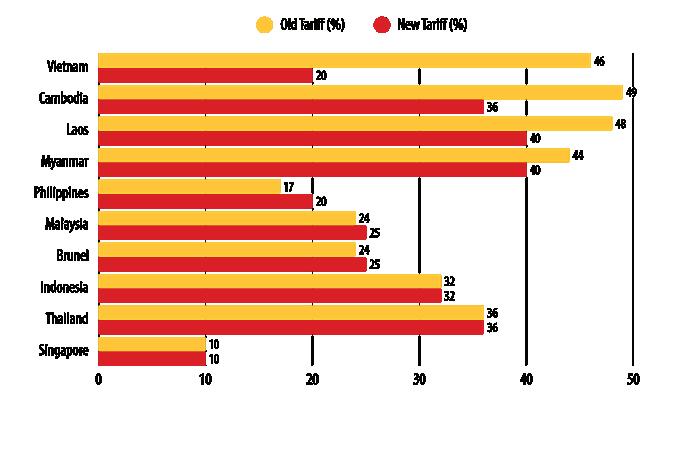



By Justine Xyrah Garcia
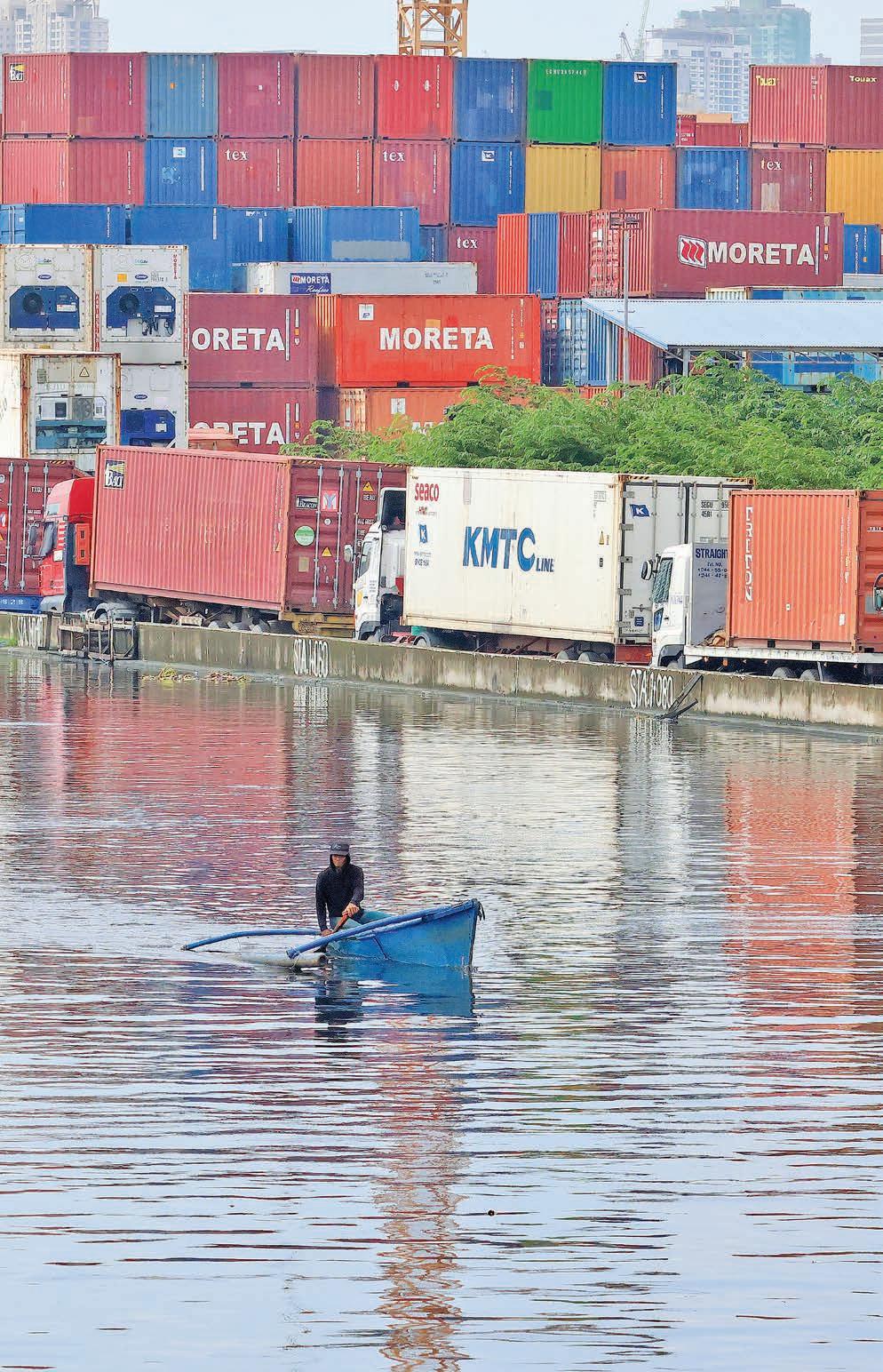

By Samuel P. Medenilla
SContinued from A1
unfortunately, far from reciprocal.”
Trump said Philippine firms that manufacture products within the US will be exempt from the tariff, with promises of faster investment approvals.
@sam_medenilla
PECIAL Assistant to the President for Investment and Economic Affairs Frederick D. Go together with other trade officials is set to fly to Washington next week to pursue negotiations to lower the 20-percent tariff imposed by President Donald Trump, which will kick in next month, as well as a comprehensive economic agreement.
In a press briefing in Malacañang, Go disclosed he will be accompanied by Department of Trade and Industry (DTI) Secretary Cristina Roque as well as trade undersecretaries Perry Rodolfo and Allan Gepty during the trade talks.
He said they will pursue two-stage negotiations with their US counterparts. The discussion on the reciprocal tariff is just stage one [of the negotiations]. There is still a stage two, which is the bilateral partnership agreement that we seek and to us, ever since it’s very clear that this is the more
important thing for us,” Go said. He reiterated that they will continue to push for the Free Trade Agreement (FTA) or a bilateral comprehensive economic partnership agreement with the US, where they can push for specific tariff concessions on specific goods like coconut.
“For example for our coconut industry, because if we are just negotiating, for example we can lower it from 20 percent to 10 percent, our coconut industry still has a 10-percent tariff. But if our coconut exports are so important, in a bilateral negotiation, we can negotiate for, say, dropping that to, say, zero percent because these are the industries that are important to us,” Go said.
Favorable rate
HE explained that while they expressed “concern” that the 20-percent reciprocal tariff cited in Trump’s letter to President Ferdinand Marcos Jr. on Wednesday is twice the current 10-percent tariff rates on Philippine goods entering the US, it is still relatively low compared to the rates of other Association
Continued from A1
The Philippine Statistics Authority (PSA) earlier reported that the manufacturing sector already shed 374,000 jobs in May, shrinking its workforce to 3.51 million from 3.89 million in the same month last year. Economists said the decline reflects weak external demand and slowing investment—conditions that could worsen as higher US tar-
of Southeast Asian (Asean) countries.
“ The fact remains however that the 20 percent rate is the second lowest among all reciprocal tariffs that the US has imposed on the region—the lowest being the 10 percent of Singapore,” Go said.
T he country, he said, also has a favorable rate compared to Vietnam, which is also among the top exporting partners of the US.
“Vietnam has two tariffs, two tariff lines; we only have one tariff line, which is 20 percent. Vietnam has two, its 20 percent for all goods and 40 for all transshipment. So I think that the true tariff rate of Vietnam is somewhere between 20 to 40 percent, right? Let’s say 30 percent, I picked the median. But they have two tariff lines, we only have one. So, I think we are still more competitive than Vietnam in that regard,” Go said.
Unlike Vietnam, which negotiated for zero-percent tariff for all goods from the United States, the Philippines will also continue to impose tariffs on US goods entering the country, in order to
iffs take effect, making these job losses more likely to persist. (Related: https://businessmirror.com. ph/2025/07/08/underemploymentseen-to-haunt-jobs-picture/).
protect certain local industries. Exempted goods GO said the new tariff rates indicated in the letter will not cover semiconductors and electronics, the country’s top exports to the US.
“Although there are…feelers from America announcing that they are studying this whether they will continue to keep them tariff-free or will they impose tariffs. But the good news for us today is that most of our semiconductor exports are not covered by tariffs,” Go said.
However, he admitted that the Department of Economy, Planning, and Development (DEPDev) is still computing the economic impact of the 20-percent tariff.
When we try to compute the effect on our economy of our tariff rate, we have to take it into consideration with the rest of the countries. Not just our number [tariff rate] will be analyzed. It has to be in relation to the tariff rates of all our competitive set,” Go said.
For Mata, the US government’s move should serve as a “wake-up call” for Philippine economic managers— “or mismanagers,” as he put it. Trump conveniently forgets that for decades, the US empire has been bleeding our economy dry—through unfair trade terms, structural adjustment programs, exploitative investments, and political interference....We have paid, and continue to pay, the price for the wealth and dominance of the Global North,” he said.
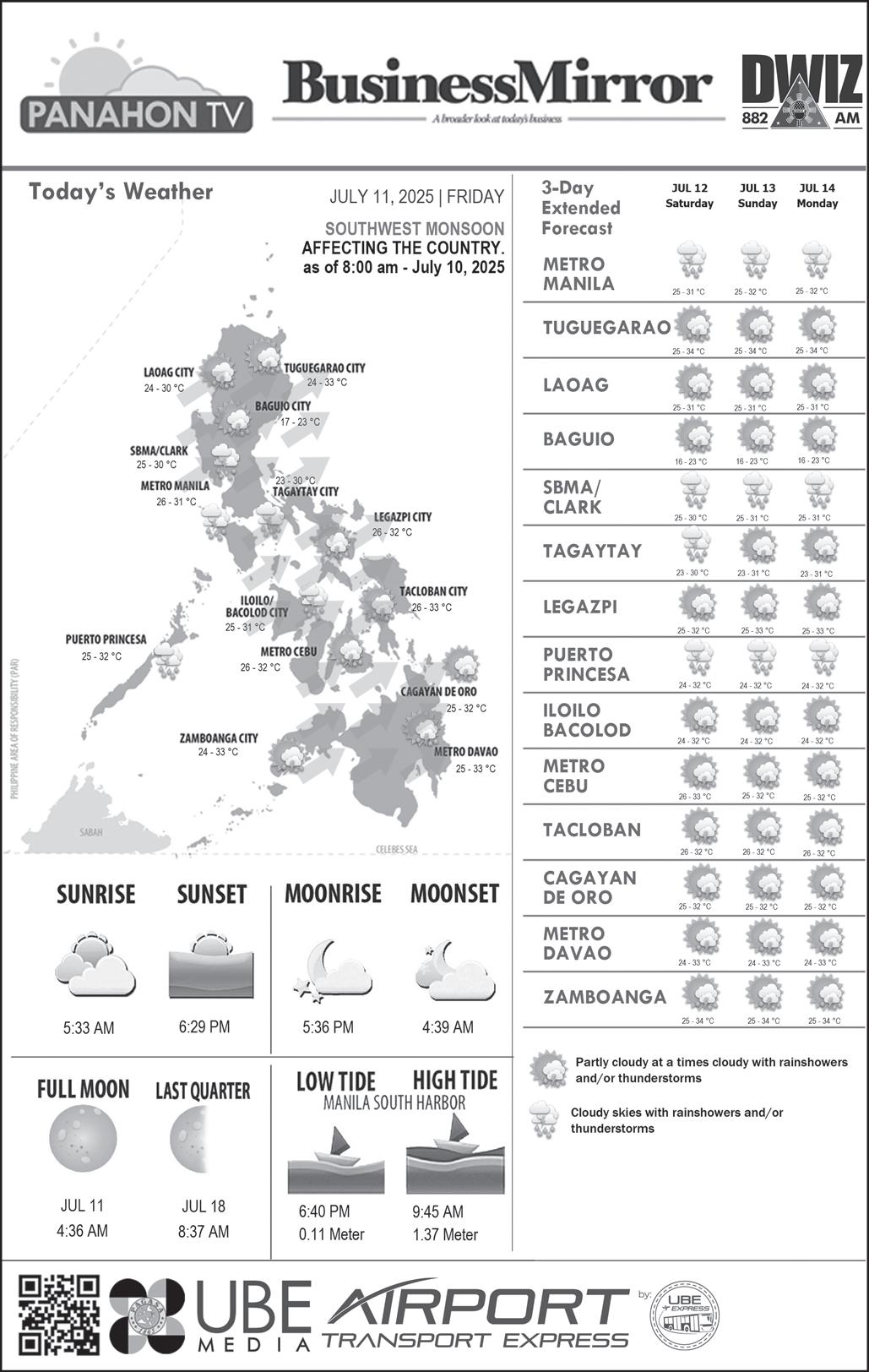
Continued from A1
for countries with more favorable trade terms with America.
Nonetheless, given the growth in FDI in April, Asuncion is still optimistic that firms remain confident about the Philippines’s long-term prospects.
While the tariff poses a risk to future FDI performance, the April rebound and continued reinvestments indicate that the impact may be sector-specific rather than systemic. Monitoring investor responses and p olicy adjustments in the coming months will be very critical,” A suncion told this newspaper.
Meanwhile, Jonathan Ravelas, senior adviser at professional services firm Reyes Tacandong & Co. told BusinessMirror that the US tariff is certainly a concern in terms of FDI growth.
Th e recent announcement made by the White House, Ravelas said, could prevent foreign i nvestors from considering the Philippines as an investment destination.
Further, Ravelas said, Trump’s promise—to assist Philippine firms wanting to get exemption from tariffs if they relocate—could provide incentives for offshore investments.
[This creates] investment uncertainty. The tariff move adds to geopolitical and trade uncertainty, which may deter foreign direct investment,” Ravelas told this newspaper.
A ccording to him, among the “significant and multifaceted effects on the Philippine economy” of the 20-percent tariff on all Philippine exports to the US are: the contraction of export earnings; the slowdown in the country’s economic growth and the derailment of employment creation.
It is important, Ravelas said, for businesses to adopt strategic shifts such as diversifying markets and exploring US-based manufacturing partnerships as well as leveraging Asean trade networks.
For policymakers, there is a need to accelerate free trade agreement talks; support industries with transition assistance; as well as investments in trade facilitation.
In a statement issued on Thursday, the Department of Trade. Industry said: “We are in receipt of the United States’ latest reciprocal tariff for the Philippines. We are concerned that, notwithstanding our efforts and constant engagements, the US still decided to impose a 20-percent tariff on Philippine exports.”
We recognize the concerns of the United States regarding trade imbalances and its desire to strengthen do mestic manufacturing. However, global supply chains are deeply interconnected, and unilateral trade impositions will have adverse effects to the g lobal economy,” DTI added.
It remains committed, it stressed, to continuing negotiations “in good faith to pursue a better and more comprehensive bilateral trade agreement.”
A Philippine delegation is scheduled to hold discussions in the US next w eek, ahead of the tariffs implementation on August 1. Story on page A2, “Go, t rade officials flying to US for further talks on tariff.”
Trade and Industry Secretary Cristina A. Roque, interviewed at the sidelines of the launch of the Women Enterprise Fund by the Department of Trade and Industry (DTI) and the Small Business Corporation, told reporters the Philippine negotiating team would still have to reconvene and discuss the concessions the Philippines would to the US in the upcoming negotiation between Manila and Washington, ahead of t he implementation of the 20- percent tariffs on August 1.
“It’s hard for me to talk because we still have to meet. So it’s best for us to meet and we’ll be able to come up with a statement,” the DTI secretary said.
Asked if the negotiating team will consult with stakeholders and industry groups before flying to the United States next week, Roque said: “Mag-uusap muna kami [the negotiating team].”
The top sectors affected are:
Electronics (accounting for over 50 percent of PH exports to US)
Apparel (Garments, fast fashion)
A griculture (Coconut oil, canned pineapple, seafood)
Philippine government officials had earlier emphasized the initial 17-percent tariff rate is relatively lower than those imposed on several Asean neighbors.
The second-tier tariff announcement comes the day after Asean foreign minister start meeting in Kuala Lumpur for a w ide range of issued affecting the region.
U S Secretary of State Marco Rubio is expected to attend the AseanU S ministerial meeting, and could face tough questions on Washington’s sweeping economic measures.
M alaysian Prime Minister Anwar Ibrahim, Asean Chair, had earlier denounced the “weaponization of trade” a nd urged bloc members to reduce dependencies and reinforce intra-Asean c ommerce.
No countermeasures
IMPOSING countermeasures in response to the US decision to raise tariffs on Philippine exports to 20 percent is unwarranted at this point, according to Finance Secretary Recto.
“[There is] no need for retaliatory tariffs. [This] will only increase costs for consumers in general,” Recto told BusinessMirror when asked if the Philippines is considering retaliation.
“ We don’t want additional tariffs. It makes our products more expensive. The lower the tariffs the better for our exporters,” the Finance chief said when asked if t he 20-percent tariff rate is acceptable.
Other countries are slapped with higher tariffs because of their trade imbalances with the United States.
However, the Philippines only has a US goods trade deficit of $4.9 billion in 2024. This widened by 21.8 percent from the previous year.
Compared to other Asean neighbors, Vietnam—pressed with the same tariff rate as the Philippines—has a trade deficit of $113.1 billion with the US in 2024.
Still, government officials argued that the Philippines’s tariff rate is lower among other Asian peers, such as Thailand with 36 percent and Malaysia at 25 pe rcent.
To cushion the blow of Trump’s sweeping tariffs, Recto said trade
should instead be expanded within the region and reach other markets as well.
Private economists weigh in JONATHAN RAVELAS , senior adviser at Reyes Tacandong & Co., echoed Recto and told BusinessMirror the Philippines should not consider retaliatory t ariffs against the US. We want their help on security issues. They provide much-needed arms,” R avelas said.
B ut definitely, the 20-percent tariff would cause a contraction in the exports sector, slow down GDP growth a nd uncertainties in investments, among others, Ravelas said. Michael L. Ricafort, chief economist at Rizal Commercial Banking Corporation, added that any retaliation would only make the situation worse.
“ Higher Philippine tariffs on US imports are not a good strategy and would only provoke higher US import tariffs on the Philippines,” Ricafort told this newspaper.
Th e government should pursue constructive negotiations that are winwin, since there is a tendency for Trump to compromise and bring down tariff rates eventually, depending on how trade talks transpire, Ricafort noted. R avelas added that free trade agreement talks should be accelerated, as well as investments in trade facilitation infrastructure. Support, in the form of transition assistance, must also be given to affected industries.
Th e United States remained the top market for Philippine exports in 2024, with shipments reaching $58.7 billion or 80.2 percent of total exports to the country’s top 10 trading partners. Total trade in goods between the United States and the Philippines reached approximately $23.5 billion in 2024, with US exports to the Philippines growing by 0.4 percent to $9.3 b illion, while imports from the Philippines stood at $14.2 billion.
PCCI concerned
FOR its part, the Philippine Chamber of Commerce and Industry (PCCI) said that while it respects the “sovereign right of the US” to implement a 20-percent increase in tariff on Philippine e xports to the United States effective August 1, 2025, it is concerned over the “significant challenges this poses to the competitiveness of our industries with significant exports to the US market, industries that are within their value chain, and their workers.”
Th is development “underscores the importance of diversifying our export markets, strengthening regional trade partnerships, and investing in domestic competitiveness,” said PCCI. It urged government to provide “greater support to our local industries by increasing the budget for research, development, technology and market intelligence and improving our supply chain efficiency, infrastructure, and cost competitiveness. To remain viable in a shifting global market, we must accelerate investments in automation, logistics, a nd workforce upskilling.”
I t also urged the government “to continue engaging with the US government to explore pathways toward a m ore equitable and sustainable trade relationship.”
The PCCI said it is “ready to work closely with our government agencies, exporters, and international partners to mitigate the impact of this tariff and to ensure that Philippine industries continue to thrive on the global stage.”
Asean tariff comparison US tariffs Across Southeast Asia (as of July 2025) are seen below:
Philippines—20 percent (up from 17 percent; Free Trade Agreement talks are under way)
Cambodia—36 percent (Reduced from 49 percent)
Thailand—36 percent (No change)
Indonesia—32 percent (Unchanged; talks ongoing)
Vietnam—20 percent (tentative) (Dropped from 46 percent)
Malaysia—25 percent (up from 24 percent)
Singapore—10 percent (Baseline; spared from new round)
Brunei—25 percent (up from 24 percent)
Myanmar—40 percent (reduced from 44 percent)
Laos—40 percent (reduced from 48 percent).
AGROUP of bishops, retired generals, lawyers and civil society leaders on Thursday filed at the National Bureau of Investigation (NBI) a complaint for 55,874,700 million counts of violation of the provisions of Republic Act 10175 or the Anti-Cybercrime Law against Commission on Elections (Comelec) Chairman George Erwin Garcia and several other officials and personnel of the poll body.
The complaints accused Garcia and his co-respondents of allowing and instituting a “man-in-themiddle intermediary server and an authorized source code” during the conduct of the May 12, 2025 national and local elections.
“Any instance of vote tampering constitutes electoral fraud and must be unequivocally condemned. This becomes all the more apparent and pressing when such tampering occurs on a national scale,” the complaint read.
Aside from Garcia, also named as respondents were Comelec officials identified as Nelson Celis, Ernesto Ferdinand Maceda Jr., Aimee Feralino-Ampoloquio, Roy Bulay, Norina Tangaro-Casingal and Noli Pipo.
Specifically, the respondents were charged with violation of paragraph 4, Section 4(a), of RA 10175 (Cybercrime Prevention Act of 2012).
The said provision states that the cybercrime of “system interference” is committed when there is “intentional alteration.. or interference with the functioning of a computer or computer network, by inputting, transmitting, deleting,.... altering or suppressing computer data or program, electronic document, or electronic data message, without right or authority...”
The complainants claimed that the respondents allowed the unauthorized substitution of the certified software version 3.4.0 with 3.5.0 as well as the installation of an intermediary server called Data 3 which constitute illegal acts under RA 10175.
By allowing the substitution of the software version, the complainants said the source code
installed in the automated counting machines (ACMs) used for the last midterm elections was not the same as the source code reviewed in the final source code review report dated April 30, 2025.
They pointed out that the version 3.5.0 was not made available for audit.
The complainants also accused the respondents of allowing the election results from the ACMs in precincts nationwide to pass through an unauthorized and illegal intermediary server or system, or the so-called Data Center 3, which first received, consolidated and processed the election results before they were sent or forwarded to the designated five Transparency Servers of the Parish Pastoral Council for Responsible Voting (PPCRV), National Movement for Free Elections (Namfrel), Media, Dominant Majority Political Party, and Dominant Minority Political Party.
Furthermore, the complainants sought to prosecute the respondents for cleaning-up or deletion or both of around five million votes of vote discrepancy all by itself, without the presence or participation of any of the five Transparency Groups.
The complainants said the respondents should be held liable for 110,000 counts of system interference, representing the 110,000 ACMs used in the 2025 elections aside from 55,874,700 counts of system interference, representing the 55,874,700 votes they routed, consolidated, and processed in Data Center 3.
The complainants include Bishop Colin Bagaforo, Bishop Gerry Alminaza, Bishop Efraim Tendero, Bishop Roberto Gaa, Baguio City Mayor Benjamin Magalong, Gen. Generoso Senga (Ret), PMGen Wilfredo Franco (Ret), BGen Alejandro Camagay (Ret), BGen Eliseo Rio (Ret), former Comelec Commissioner Augusto Lagman, former Financial Executives Institute of the Philippines (Finex) presidents Franklin Isaac and Edwin Fernandez, retired Army Capt Roberto Yap , Fr Wilmer Tria and lawyers Melchor Magdamo, Harold Respicio and Alex Lacson. Joel R. San Juan
THE Commission on Elections (Comelec) on Thursday said it is ready to face the complaint filed against it by a group of bishops, retired generals, lawyers, and civil society leaders before the National Bureau of Investigation (NBI) over alleged fraud in the May 12 midterm polls.
The complainants accused the poll body of committing 55.87 million counts of system interference under Section 4(a) (4) of Republic Act 10175 or the AntiCybercrime Law.
Comelec Chairman George Erwin M. Garcia maintained that the commission has nothing to hide, saying the issues raised in the complaint had long been addressed.
“We have nothing to fear, and we’re ready to face any investigation and provide all necessary documents. We’re fully prepared—this is part of post-election processes,” Garcia said in an ambush interview.
He clarified that version 3.50 was the correct version to be used because it matched the hash code stored with the Bangko Sentral (BSP), which confirms its authenticity.
It was also the version that went through the trusted build process and was installed in the automatic counting machines.
Garcia stressed that this version was certified by the Technical Evaluation Committee—the body designated by law to give the final certification for any system and hardware used in elections.
The international certification agency Pro V&V also previously confirmed that version 3.50, not 3.40, was the version it reviewed and approved for use in the 2025 polls.
Garcia added that election watchdogs
Jsuch as the Parish Pastoral Council for Responsible Voting (PPCRV) witnessed the entire software testing process and confirmed that version 3.50 was used in the machines.
The complaint also accused Comelec of system interference by allegedly routing, consolidating, and processing 55.87 million votes through an unauthorized “intermediary system” in Data Center 3— before transmitting what it claimed were manipulated results to the five transparency servers.
Garcia dismissed the allegation, saying what appeared as vote fluctuations were due to duplicated data being processed by some servers that lacked proper filtering mechanisms.
He explained that votes are transmitted to multiple servers, including Comelec’s and those of media organizations.
While Comelec’s server has a built-in filter that removes duplicate transmissions, not all servers have this feature.
Garcia stressed that no votes were removed or manipulated, and the final results accurately reflected the real count.
“There was no fraud or vote deduction. The 5.1 million-vote difference came from duplicated data being added to the running total on servers that lacked filtering tools,” he added.
Still, the poll chief acknowledged the importance of addressing such concerns— even those that have been explained multiple times.
“We should also be grateful for people like them, because even if we’ve already answered the issues they’re raising, they still help us further strengthen, improve, and refine the conduct of future elections,” he added. Justine Xyrah Garcia
By Joel R. San Juan @jrsanjuan1573

USTICE Secretary Crispin Remulla late Thursday confirmed the retrieval of a sack “contining what appears to be burned human bones” during the initial technical site assessment at Taal Lake on Wednesday by a team from the National Police-Criminal Investigation and Detection Group (PNPCIDG), in coordination with the Coast Guard (PCG).
During what was only supposed to be a test dive, “a white sack was visibly identified and recovered from the lake bed,” Remulla said. As part of the DOJ’s evidencebased and methodical approach, he said, the next steps will be the formal determination and certification is indeed the sack contained human bones, and if so, the conduct of deoxyribonucleic acid (DNA) testing to deternine if there
is a match with any of the families of the missing sabungeros.
In a statement, the department said: “This discovery could represent a significant breakthrough in the ongoing investigation. While we proceed with caution and diligence, it offers renewed hope that we are closer to uncovering the truth and securing justice for the families of the missing.”
MEMBERS of the elite operations forces of the Coast Guard PCG) will lead the official search and retrieval operations to be conducted starting Friday for the bodies of the more than 30 missing sabungeros that were allegedly dumped in the Taal Lake four years ago.
The Coast Guard District Southern Tagalog (CGDSTL) commander, Commo. Geronimo Tuvilla said the elite coast guard divers
would focus on a portion of the 234 square-kilometer Taal Lake adjacent to the town of Laurel, Batangas, which is believed to be the ground zero for the missing sabungeros.
He said the divers would be using remotely operated vehicles and aerial drones to support the operation which is expected to reach a depth of 30 meters.
“We have already seen the area, definitely starting tomorrow we will be doing the dive,” Tuvilla said.
He added that the number of divers would depend on the length of the area that will be covered during the operation.
Tuvilla said the operation will be conducted daily as long as the weather permits it.
A team of divers from the PCG on Wednesday inspected the ground zero to determine the possible challenges that they might face during the operation.
Aside from the PCG, also present during the inspection were representatives from the Department of Justice, which is leading the investigation into the missing sabungeros and the National Police–Criminal Investigation and Detection Group (PNP-CIDG).
DOJ Spokesman Jose Dominic Clavano IV described Wednesday’s operation as a technical site assessment to determine the condition of the water, the current and other factors that might affect the effort to retrieve the bodies including the threat of low-level unrest of the Taal Volcano.
Chances WHEN asked about the chances of retrieving the remains of the missing sabungeros after four years, Clavano said: “We are confident, we cannot say for certain, but it is
AFTER weeks of speculation of another impending change in the leadership of the Presidential Communications Office (PCO), Malacañang finally announced that President Marcos has appointed retired corporate communications veteran and former journalist Dave M. Gomez as the new head of the agency.
Marcos also promoted Department of Energy (DOE) officer-in-charge (OIC) Sharon S. Garin as the new secretary of the agency.
Palace Press Officer Claire Castro made the announcements during a news briefing in Malacañang on Thursday.
The change of leadership in the two agencies, she said, is expected to enhance the government communications and energyrelated initiatives.
“We look forward to their leadership as
we strengthen government communications and secure our country’s energy needs under Bagong Pilipinas,” Castro said.
As a reporter, Gomez covered Malacañang during the time of former President Fidel V. Ramos. He was later appointed director general of the Philippine Information Agency.
Gomez later transitioned to advertising and joined the local subsidiary of an international advertising agency.
After his stint in advertising, Gomez later joined the local subsidiary of the international tobacco giant Philip Morris international which later merged with the Lucio Tan-owned Fortune Tobacco Corp. and became the PMFTC Incorporated.
Gomez replaced Presidential Communication Secretary Jaybee “Jay” C. Ruiz, who was appointed as a member of the board of
director of the Manila Economic and Cultural Office (Meco), the country’s de facto embassy in Taiwan.
Meco chairman Cheloy Garafil is also a former PCO chief, having served from October 2022 to September 2024, the longest serving PCO chief to date.
As early as last month, there were already rumors of Gomez replacing Ruiz.
Castro said the decades of experience of Gomez in journalism, as well as government and corporate communications, will “ensure ensure clear and truthful” government messaging to every Filipino.
She also lauded the promotion of Garin, who is a lawyer and Certified Public Accountant by profession.
He thanked Marcos for his almost fivemonth stint as head of PCO, which he said gave him the opportunity to advance “transparency, timely information, and responsible public communication.”
He also welcomed the designation of Gomez as the new head of PCO.
“I am confident that under his leadership, the agency will continue to grow and thrive in fulfilling its vital mission,” Ruiz said in a statement. Samuel P. Medenilla
Castro described Garin as someone with a “strong background in energy policy and legislation to advance accessible, reliable, and sustainable energy for our people.” Garin, who belongs to a prominent poltical family in Iloilo, is a lawyercertified public accountant and once was a party-list member of the House of Representatives. Ruiz said he will continue to support the Marcos administration in his new posting at Meco.
By Jovee Marie N. dela Cruz @joveemarie

MORE than 60 first-term lawmakers have been urged to outperform the 19th Congress by enacting even more impactful pieces of legislation in the 20th Congress that starts sessions late this month.
The 19th Congress’ Speaker, Leyte Rep. Ferdinand Martin G. Romualdez, challenged lawmakers in the 20th Congress as they gathered Tuesday evening at Imelda Hall of Malacañang’s Aguado Residence, marking the conclusion of the second batch of the three-day Executive Course on Legislation.
Organized by the House Secretariat in partnership with the University of the Philippines–National College of Public Administration and Governance (UP-NCPAG), the training culminated in a fellowship dinner and a direct call to action from Romualdez, who also serves as the president of Lakas-Christian Muslim Democrats (CMD).
“We wound up the 19th Congress as a very, very productive one,” said Romualdez. He highlighted the House’s impressive record of passing 61 out of 64 priority
measures identified as the Common Legislative Agenda (CLA) by the LegislativeExecutive Development Advisory Council (Ledac). Throughout the 19th Congress, House members filed 11,557 bills and 2,393 resolutions, passed 1,565 measures, enacted 287 national and local laws, and processed an average of 29 measures per day across 188 session days.
“Many say, and I tend to agree with them, that it was the most productive and most hard-working Congress in recent memory,” he added.
“But I’m not going to leave it there,” Romualdez said. “Because I think the 20th Congress may just live up to be the better one—with you there.”
ROMUALDEZ emphasized that the strength of Congress lies in its members’ commitment to serve and lead, calling on the incoming legislators to bring fresh ideas and renewed energy to their work.
He pointed out that the Executive Course aimed to prepare them for this responsibility, covering essential topics such as legislative procedures, committee functions, budgeting, parliamentary rules,
and ethics in public service.
The course covered key areas including the legislative process, committee work, budgeting, parliamentary rules, and ethics in public service.
In his message, Romualdez also reminded them that legislative work goes beyond drafting bills or attending sessions.
“The House isn’t just about passing laws—it’s about listening, serving, and lifting people up,” he said. “With your passion, drive, and fresh perspectives, I truly believe we can make this 20th Congress the most dynamic yet.”
Throughout the evening, lawmakers reflected on the lessons from the training and explored how they could align their legislative priorities with the Marcos administration’s Bagong Pilipinas agenda.
“With you, the 20th Congress can be even better,” Romualdez said.
Among those who joined the ev ent were Quezon Rep. David “Jay-jay” Suarez, former Senior Deputy Speaker Aurelio “Dong” Gonzales Jr. of Pampanga, Manila Rep. Joel Chua, Davao de Oro Rep. Maricar Zamora, House Secretary General Reginald “Reggie” Velasco, Deputy Secretary General Sofonias “Ponyong” Gabonada, and Deputy
Secretary General for Legislative Operations David Robert Amorin. Also in attendance were several leaders of the Young Guns bloc, including Reps. Paolo Ortega V (La Union), Jay Khonghun (Zambales), Rodge Gutierrez (1-Rider Party-list), Ernix Dionisio (Manila), and Lordan Suan (Cagayan de Oro City). Romualdez also acknowledged the presence of rising House leaders collectively known as the “House Hotshots,” such as Reps. Andrew Julian K. Romualdez (Tingog party-list group), Javier Miguel “Javi” L. Benitez (Negros Occidental), Ryan S. Recto (Batangas), Brian Poe-Llamanzares (FPJ Panday Bayanihan party-list group), and Leandro Legarda Leviste (Batangas).
Collaboration
ECHOING President Marcos’ call for a stronger national-local collaboration, Secretary of the Interior and Local Government (SILG) Secretary Juan Victor Remulla urged newlyelected officials to rise above politics and personal interest, and to focus on improving the lives of their constituents.
Addressing provincial governors and city
TBy Jonathan L. Mayuga @jonlmayuga

HE Department of Environment and Natural Resources (DENR) is eyeing to plant three million trees within the next three years to expand the forest cover of the Marikina Watershed by 20 percent, particularly the area within the Upper Marikina River Basin Protected Landscape (UMRBPL).
The target, according to the DENR’s
Forest Management Bureau (FMB), is to include some 1,300 hectares of land within the 2,700 conservation
housing project over Lot 10, which is located within the Masungi Georeserve Foundation, Inc. conservation area. Masungi and Blue Star are both run and managed by members of the Dumaliang family—Ben and his daughters, Billy and Ann. With this, the DENR said forest cover will increase to 43 percent from the current forest cover of the UMRBPL, now estimated at 24.99 percent. The UMRBPL was proclaimed a protected area through Proclamation 296 dated September 26, 2011, two
family, which, in effect, cancels a 5,000-unit
Friday, July 11, 2025
SBy Jonathan L. Mayuga

@jonlmayuga
EVEN more brands of paints and coatings, mostly used for automotive and industrial applications and manufactured in the Philippines, passed the third-party Lead Safe Paint® Certification, the International Pollutants Elimination Network (Ipen) reported.
This brings to 11 the total number of locally-manufactured paints that comply with environmental and health safety standards for paints.
Passing the third-party certification by Ipen and the SCS Global Services, owner and certification body, respectively, confirms compliance with the
strictest regulatory limit for lead content in paints and similar surface coatings.
EcoWaste Coalition, an advocate for a zero-waste and toxicsfree society, welcomed the report and lauded local paint manufacturers for replacing lead-based ingredients used as pigments, driers, or as anti-corrosive agents in the manufacture of decorative, automotive and industrial paints.
“We congratulate Asian Coatings for replacing lead-based ingredients used as pigments, driers, or as anti-corrosive agents in the manufacture of decorative, automotive, and industrial paints, and for having this confirmed through unbiased and trustworthy thirdparty certification,” said Manny
Calonzo, EcoWaste Coalition campaigner.
“Certified lead-safe paints will not pose lead-based paint hazards, especially for workers, women of childbearing age, and children, who are highly vulnerable to the harmful effects of exposure even at low levels, particularly when the paint has deteriorated and scattered contaminated chips or dust, which can be ingested and inhaled.”
SCS conducted an independent assessment on behalf of Asian Coatings Philippines Inc. for USA, Trend, Trans-Lac, Texas, PolyGloss, Paralux and Glasurit paint products and found them in conformity with the regulatory limit of 90 parts per million (ppm) for lead in paint on a dry
weight basis.
These bring to 11, the number of its duly certified products, including Alpha Chroma, Arkhon, Rain or Shine, and Welcoat paints.
“SCS is really excited to see more brands obtain Lead Safe Paint® Certification. We take pride in helping manufacturers provide paints below 90ppm of lead content, the most stringent international standards currently available. SCS uses a science-based approach to our assessments, allowing consumers to make educated choices that affect the health of family, friends, and other loved ones,” said Rob Emelander, SCS program manager. SCS is a pioneer and leader in the field of sustainability standards and third-party
ATOXIC chemicals and waste watchdog, on Thursday, expressed alarm over the online sale of elemental mercury, also known as silver mercury or quicksilver, on the Marketplace of the social media platform giant Facebook.
Mercury is a highly toxic chemical, and its importation, sale, and distribution are strictly regulated and, in most cases, prohibited under Philippine laws aligned with the Minamata Convention, which the country ratified in 2020 to eliminate mercury use in products, processes, and trade, says BanToxics.
The group released the statement in time for the fifth anniversary of the ratification of the Minamata Convention on Mercury by the Philippine government.
In a recent online market monitoring, the group found 23 active Facebook Marketplace postings of silver mercury offered by sellers based in Angeles City (Pampanga), Baguio City (Benguet), Sta. Maria (Bulacan), Silang (Cavite), Cebu City and Lapu-Lapu City (Cebu), Iloilo City (Iloilo), San Pedro City (Laguna), Lipa City (Batangas), and the Metro Manila cities of Makati, Manila, Muntinlupa, Parañaque, Pasay, and Quezon.
The postings commonly advertise silver mercury as a “highdensity, silver-colored liquid metal used in gold mining, amalgamation, scientists’ instruments, and chemical synthesis.” Prices range from P22,000 to P71,000 per flask/cylinder, with a net weight of 34.5 kilograms.
Several Facebook groups dedicated to the sale of mercury were also identified, along with one listing each on the e-commerce platforms Lazada and Shopee.
Apalling
“IT is appalling that toxic mercury continues to be sold openly, especially through online platforms,” said Thony Dizon, BAN Toxics’ Advocacy and Campaign Officer. Dizon said the government already has in place several pertinent policies to control and eliminate the use of mercury in the country. One of the key regulations is the Department of Environment and Natural Resources (DENR) Administrative Order 2019-20, or the Revised Chemical Control Order for Mercury and Mercury Compounds.
The Department of Health (DOH) also issued Administrative Order 2020-0020, which mandates the phase-out of dental amalgams by the Minamata Convention.
In addition, the Food and Drug Administration (FDA) released Circular 2022-003, banning thermometers and sphygmomanometers that use mercury, as well as dental amalgam capsules used to fill cavities. The FDA also regularly issues advisories banning mercury-containing skin-lightening products found in the market.
Govt clearance
ARTICLE 3 of the Minamata Convention does not allow the import of mercury without government consent, ensuring that both the mercury source and proposed use
comply with the Convention and applicable domestic law.
The Minamata Convention was established in response to decades of severe health and environmental damage caused by mercury exposure. It addresses mercury pollution by limiting mining, regulating trade, reducing and, where feasible, eliminating mercury use in products and processes, controlling emissions, and promoting safe waste disposal.
According to the World Health Organization (WHO), mercury is a neurotoxin that can cause ireversible damage to the nervous system. It can also affect the brain and kidneys, and is significantly dangerous to children and pregnant women. It is also known for its long environmental persistence and global mobility. Its emissions and releases can bioaccumulate and biomagnify in the food chain, posing a significant threat to human health and the environment.
“Despite our strict laws and regulations on mercury, it begs the question: how does this hazardous substance continue to enter the country?” Dizon asked.
BAN Toxics suspects that buyers of mercury sold on Facebook are small-scale gold miners. Mercury is commonly used in artisanal and small-scale gold mining (ASGM) as a means of extracting gold from processed ores. While its use has been strictly prohibited, mercury continues to be used in ASGM operations to this day.
According to Arleen Honrade, BAN Toxics Community Development Officer and Secretary of the
National Coalition of Small-Scale Miners of the Philippines, Inc. (NCSSMPI), mercury use in the sector remains prevalent owing to the lack of sufficient support for mercury-free technologies and alternatives.
“As a poverty-driven sector that relies on subsistence mining, the transition to mercury-free processes needs to be supported by the government,” Honrade added.
BAN Toxics and NCSSMPI are pushing for amendments to the decades-old Republic Act 7076, or the People’s Small-Scale Mining Law, to better support small-scale miners in transitioning to environmentally sound technologies in their operations.
BAN Toxics also raised concerns about the transboundary nature of the mercury trade, noting that many of the products sold online are likely smuggled into the country. The group is calling for stronger intergovernmental cooperation to address illegal mercury shipments, especially those entering through e-commerce platforms and informal channels.
Both groups called on the DENR-Environmental Management Bureau (EMB) to investigate individuals and groups involved in the illegal sale of mercury, and urged the Department of Trade and Industry (DTI) to strengthen regulation of online platforms facilitating such transactions, and on platforms such as Facebook to take immediate action in removing hazardous listings and accounts engaged in mercury trade.
Jonathan L. Mayuga
THE Philippine Statistics Authority (PSA) and the United Nations Population Fund (UNFPA) have sealed their partnership for the 2025 National Demographic and Health Survey (NDHS), a wide-scale national effort to gather critical insights into the country’s health and population trends.
The NDHS, traditionally conducted every five years, collects data on key indicators such as fertility, family planning, maternal and child health, nutrition, HIV-AIDS awareness, and violence against women. In recent years, it has been conducted more frequently—every three years— to allow for timelier monitoring of development goals.

“Our partnership comes at a crucial time when population and health programmes face evolving threats, and when disparities in health and rights are increasing, particularly in underserved areas,” said UNFPA Philippines Representative Leila Joudane.
The survey’s findings will serve as a foundation for crafting policies and tracking progress toward national priorities, including the Philippine Development Plan 2023-2028 and the United Nations’ Sustainable Development Goals (SDGs) 2030.
The 2025 NDHS will mark the eighth round of the survey, building on the methodologies of previous years while integrating new digital tools. National Statistician Claire Dennis Mapa noted the increasing complexity of the survey and the need for innovation.
“To address these needs, our Memorandum of Understanding with UNFPA establishes a strategic partnership,” Mapa said. “UNFPA’s expert advisory and hands-on support will strengthen the PSA’s capacity to effectively execute the survey and innovate existing systems and processes.”
Also backing the effort is the Australian government, which shares the goal of empowering the PSA to sustainably generate essential population data that supports evidence-based decision-making across sectors.
Survey findings are expected to be used by government agencies, development partners, researchers and civil society groups to guide program design, planning, and evaluation, especially in health and social development.
certification.
“Asian Coatings graciously accepts the Lead Safe Paint® Certification for our automotive and industrial paints. This milestone brings our company full circle, as we trace our roots to the vibrant automotive coatings market of the 1970’s. We extend our sincere appreciation to the EcoWaste Coalition for facilitating this important initiative toward environmental sustainability. The Lead Safe mark stands as a testament to the continued trust of our dealers and end-users, and affirms our commitment to producing safer, more responsible products,” stated Redmond Yu, Assistant VicePresident for Sales and Marketing, Asian Coatings Philippines, Inc., a member of the Philippine
By Cai U. Ordinario @caiordinario

IN the wake of the publication of recent labor data showing an increase in the number of Filipinos looking for better jobs, the Department of Economy, Planning, and Development (DEPDev) assured the public that job quality remains a priority of the government. This, the country’s chief economist, Arsenio M. Balisacan, said is reflected in the Trabaho Para sa Bayan plan. He said more than the quantity, the emphasis of the plan is on creating and securing quality jobs.
On Tuesday, the Philippine Statistics Authority (PSA) reported that while there was a decrease in the number of unemployed Filipinos, some 1.79 million joined the ranks of the underemployed.
(See: https://businessmirror.com. ph/2025/07/08/more-pinoys-lookingfor-new-side-jobs/)
“More than just the quantity, it’s also the quality. That’s the one that we are really more focused on, the quality. Because the unemployment number is already very low. It’s even better than many other countries,” Balisacan said.
“If you look at the unemployment numbers in the US, for example, in Europe, they are the same numbers that we are seeing now. But the quality is the one that we need to work on hard,” he added.
Balisacan explained that there is a supply and demand aspect to job quality. He said on the demand side, there has to be quality employment available for Filipinos while on the supply side, workers should posses the necessary skills needed to perform these kinds jobs.
He said that in order to address the demand side, the government is keen on attracting more investments, whether from foreign or local firms. These will lead
Continued from A3
mayors, Remulla challenged the new local leaders “to cut through the noise of online discourse and set an example of hope and good governance on the ground.”
“We are entrusted by the people and it is a mandate. And the mandate carries not only the capacity to rule, but also the trust, hope, and confidence that you’ll make their lives better,” said Remulla during the kick-off of the NEO PLUS (Performing Leadership for Uplifting Service) Program led by the Department of the Interior and Local Government’s Local Government Academy (LGA) on Wednesday.
Continued from A3
of its natural resources.
The protected area covers a total area of 26,125.64 hectares in the city of Antipolo and in the towns of Baras, Rodriguez, San Mateo, and Tanay, all in the province of Rizal.
Paint & Coatings Association, Inc. (PPCAI), which advocates for leadsafe paint manufacturing and supports voluntary Lead Safe Paint® certification.
“Amidst growing consumer demand for safer paint products, we laud Asian Coatings once again for their efforts to eliminate lead in paints by subjecting seven more paint brands, mostly industrial paints, to a third-party Lead Safe Paint® Certification. These steps undertaken by Asian Coatings will not only help Filipino consumers in making informed choices when buying paints, they will also serve as proof of the company’s compliance to existing lead paint laws in the country,” said Jeiel Guarino, Global Lead Paint Elimination Campaigner, IPEN.
to better pay for workers. This includes efforts to draft master plans for the semiconductor and electronics sector as well as the information technologybusiness processing (ITBPM) sector.
“Natapos na natin ang plan. And so it’s already [under] implementation. There are many efforts now ongoing,” Balisacan said.
“That plan is for the next 10 years, you know. But it’s progressive realization. I mean, you don’t get a transformation overnight. Especially for upskilling and reskilling.” On the supply side, Balisacan said, the focus is on helping and encouraging more Filipinos to upskill or reskill in order to boost their chances of securing quality employment.
One particular aspect of upskilling and retooling are what are called microcredentials, which are non-degree programs that Filipinos can take in order to qualify for certain positions or jobs in companies.
“Those are the exciting ones, those micro-credentials. People like you who want to go up in your skills, you can get certificates and accumulate those. Who knows, that may lead to a master’s degree, things like that,” Balisacan explained. He said industry representatives like those in manufacturing or service providers or even State Universities and Colleges can go for a week of training to get microcredentials.
Balisacan said they can compile these micro-credentials to help them along in their journey to secure a job with a higher pay such as a promotion in the companies they work for.
This also includes efforts to maximize Artificial Intelligence (AI) which, Balisacan said, the government is keen on saying that they are working closely with the ITBPM sector, which is considered the most vulnerable to AI.
Remulla called for unity of purpose and leadership that transcends partisanship.
“Let’s all be one. One for your province. One for your region. One for our country. One for our President.” he said. With PNA
“The enemy of cynicism is nothing else but hope. Hope when they see that you build new schools and provide better education. Hope when you give scholarships. Hope when you give free medical services. Hope when they see that there is a direction that the province is leading,” he added. He emphasized that “Ang Bagong Pilipinas means a path forward... Because in this world of great cynicism, hope must win.”
FMB Assistant Director Ray Thomas Kabigting said in a statement that increasing the closed forests of the UMRBPL is of utmost importance.
“The rise in closed forest cover signifies that previously degraded or barren areas are now thriving with healthy trees,” he said, explaining how this success reflects the positive effects of sustainable forest management practices and reforestation efforts.
As the closed forest cover expands, a corresponding decrease in open forests was noted, indicative of a healthy ecological progression.
Kabigting explained that open forest areas within Upper Marikina
The UMRBPL is home to endangered flora and fauna species. These include forest trees like narra, red and white lauan, bagtikan, kamagong, and molave, and wild fauna that includes birds like the Philippine bulbul, black-naped oriole, and jungle fowl; mammals like the Philippine deer, wild boar, and the Philippine monkey; and herpetofauna such as the monitor lizards and forest frogs.
have decreased by 1,138.28 hectares (20.95 percent), signifying a transition towards more mature, closed forest ecosystems. Additionally, the area has seen 628.47 hectares (1.77 percent) of shrublands evolve into open forests, underscoring the efficacy of both reforestation initiatives and natural regeneration processes.
Three million trees
“WITH the target of planting three million trees by 2028, the UMRBPL is not only fostering a more resilient environment but also setting a precedent for sustainable development and conservation efforts in the region,”
By Samuel P. Medenilla

T@sam_medenilla
HE Department of Migrant Workers (DMW) said it is now studying filing criminal and civil charges against the principal and licensed manning agency (LMA) of the Filipino crew of MV Eternity C for multiple violations of its regulatory measures. The said violations, DMW Hans J. Cacdac said, has put at risk the lives of the 22 crew of the Liberian-flagged bulk carrier, which includes 21 Filipinos, while it was passing through the Red Sea, where it was reported to be attacked by Houthi rebels last Monday.
In a press briefing in Malacañang last Thursday, the DMW chief said they immediately suspended the operation of the concerned LMA and the shipowner from deploying Filipinos in the high-risk waters of the Red Sea.
Citing the initial result of their investigation, he said the principal and the LMA failed to submit the necessary risk assessment to DMW and deploy an armed guard and maritime security escort to protect MV Eternity C.
“They crossed the Red Sea twice. If you trace [MV Eternity C’s] route from Egypt to Somalia, that’s one, okay, that’s one turn or one crossing across the Red Sea; and then, back to Jeddah, so a second one. So, at least two counts of violations of our rules and regulations,” Cacdac said.
Other cases ASIDE from administrative sanctions, he said DMW is also considering filing other cases against the concerned LMA and principal.
“We will look at other types of remedies that are available, [including] civil and criminal
remedies. But, again, that will be saved for another day. For now, it is appropriate to give space [in this briefing how] to save the crew members,” Cacdac said.
As of Thursday, Cacdac said six of the 22 crew of MV Eternity C — five Filipino and an Indian armed guard—were already rescued after the bulk carrier sank last Wednesday afternoon.
The rescued crew were headed to a safe location, which Cacdac did not disclose due to security reasons. The search for the 16 other MV Eternity C sailors is ongoing. For verification ONCE they are able to communicate with the rescued Filipinos, he said they will verify reports that some of the MV Eternity C crew died or were kidnapped by Houthi rebels.
The United Kingdom Maritime Trade Organization said three of the said crew have died.
“This too is subject to confirmation so it is important for us to talk to the five crew members, but, of course, we will give them some space or space [to rest]. We don’t want to rush them or [to] suddenly question them with details,” Cacdac said.
In a related development, Cacdac said the 17 Filipino crew of MV Magic Seas, which was also attacked by Houthi rebels while passing through Red Sea, are set to return home this week.
“They are slated to come home tomorrow, on July 11. So, we can just provide your necessary flight details if you want to at least be updated here on their return to the airport,” he said.
DMW assured they will provide the necessary assistance to the repatriated sailors in line with the instruction of President Ferdinand Marcos.
By Lorenz S. Marasigan @lorenzmarasigan

FILIPINO motorists can now renew their driver’s licenses without setting foot in a Land Transportation Office (LTO) branch, as the government on Thursday rolled out the online driver’s license renewal service through the eGov PH Super App.
Jointly developed by the Department of Information and Communications Technology (DICT), Department of Transportation (DOTr), and the LTO, the new feature enables an end-to-end digital process—from medical exams and payments to license delivery.
“This is a big deal for our fellow Filipinos, including our OFWs who can now renew their licenses even from abroad,” Transporta -
tion Secretary Vince Dizon said during the launch. “No more lines, no more fixers. Everything is done online.”
The process includes online medical assessments for vision and hearing, digital payment through e-wallets, digital banks, credit or debit cards, and the option to either pick up the license from the nearest LTO branch or have it delivered within 72 hours.
Dizon said the launch follows President Ferdinand Marcos Jr.’s directive to streamline public service processes and eliminate unnecessary bureaucracy in frontline agencies.
“Over the last decades, renewing a license meant Filipinos had to endure multiple lines
JBy claudeth mocon-ciriaco @claudethmc3

UST when she thought she will now focus on being a private citizen, away from politics, quietly spending time with family, and perhaps pursue further studies abroad, at the moment, former Makati City Mayor Abigail “Abby” Binay is facing external challenges.
Her older sister, former senator and now Makati City Mayor Maria Lourdes “Nancy” Binay called the P8.96-billion subway settlement, entered by her administration, as “midnight deal,” signed just days after she left her office.
The younger Binay denied the allegation, saying, “The claim that the settlement was rushed has no basis.”
“It is exaggerated. Why? The settlement agreement will still need approval by the arbitral tribunal based in Singapore. Second, it will require COA (Commission on Audit) approval. And last, it will require the approval of the City Council for the appropriation of funds for the payment,” Abby explained.
Earlier, the Makati City Council passed a resolution, authorizing the former administration to enter into a settlement agreement with Philippine InfraDev Holdings Inc. (PhilDev), in response to arbitration proceedings initiated by PhilDev.
Better option TO cancel the settlement agree -
ment, Abby stressed, is the new administration’s prerogative. But she warned that they must be prepared for the “consequences of their decision.”
The better alternative, Abby said, is still the “settlement.”
“By not agreeing to the settlement, the case now goes to arbitration. Kahit i -reject nila ang settlement, they cannot avoid arbitration. Hindi pwedeng iwasan o takasan ang arbitration,” she said. She said that arbitration process is also “long and costly process,” which they wanted to avoid in the first place.
“The City will incur legal and other related expenses in the millions for an undetermined period of time. All these expenses will be paid with taxpayers’ money. And the risk for the new administration is that at the end of the arbitration, they may be ordered to pay $1.7 billion to the developer. Handa ba silang isugal ang $1.7 billion na pera ng Makati?” she warned.
And even if Nancy’s administration will win in the arbitration, Abby pointed out, the City will still be obligated to reimburse the investor the amount it invested in the project.
“Simple lang. Kung walang settlement, tuloy ang arbitration na walang kasiguruhan kung kalian ito matatapos at kung sino ang mananalo. With the settlement, ang ilalabas ng Makati ay $160 million to end any legal uncertainty on the Subway Project. A t may dagdag pa na isang kumpanya na may net as -
Davao City taxi driver faces charges after overcharging elderly passengers
By Manuel T. Cayon @awimailbox

DAVAO CITY—A taxi driver here will face charges after his aggrieved elderly passengers brushed off his pleadings for forgiveness for overcharging them in a trip from the airport to the bus terminal.
A television news footage on Wednesday showed the taxi driver pleading on his knees and grappling the helm of the pants of his male passenger to forgive him for charging the passenger and his wife of P2,970 on a 12-kilometer ride which would normally cost more than P300.
An initial post on Wednesday after the Land Transportation Office called on the driver and the passengers to a meeting said the driver admitted of his fault but claimed he mistook the three P1,000 bills for P100 bills.
But the passengers dismissed the pleading of the driver saying that the latter had indeed demanded that they pay the almost P3,000 fare even when they protested it.
The LTO said they will evaluate the case and warned that the driver may face revocation of his license and the operator may also be fined.
Ronelyn Franes Suicano, the daughter of the two passengers, posted on social media the entire taxi trip of her parents and the overcharging by the driver. She said her parents had arrived at the Davao airport at 9:26 p.m. on Saturday and rode on a taxi going to the Ecoland bus terminal, where they were supposed to
TBy Jonathan L. Mayuga @jonlmayuga

HE Department of Agrarian Reform (DAR) has turned over a P20-million solar-powered irrigation system (SPIS) to an Agrarian Reform
Beneficiaries Organization (ARBO) in Tumauini, Isabela, to ensure year-round agricultural production in a small farming barangay in the area.
An official of DAR said the SPIS project will irrigate 31 hectares of rice farms, especially during the dry season, making farming a year-
round activity from now on.
DAR Regional Director Primo Lara said the SPIS is also expected to reduce farmers’ production costs and ensure year-round palay harvests.
“This irrigation system includes five (5) units of solarpowered pumps, which will help increase palay yield and eliminate the need for gasoline-powered generators,” Lara explained.
The system will benefit around 30 ARBs and will be jointly managed by the Cagayan River Irrigators Association, Inc., and Lapogan Multipurpose
Cooperative.
The project is part of DAR’s Climate Resilient Farm Productivity Support Project (CRFPSP), designed to help ARBs in remote areas adapt to climate change and improve farm productivity.
Lapogan Multipurpose Cooperative Chairperson Victoria Garcillan expressed his gratitude to the DAR for the support.
“With this system, we have enough water, and that means better harvests, especially during the second cropping season,” Garcillan said.
sets na $1.6 billion at full control ng Subway Project,” she furthered. Abby also said that if her sister needs clarification, she is just a phone away.
Pwede naman ako tawagan ni Ate [Nancy] at tanungin privately kung mayroon silang hindi maintindihan. Pero tila hindi kaliwanagan ang gusto ng mga tao sa paligid nya pero ang pagbalik ng kadiliman,” she lamented.
NANCY also denied that the City will go bankrupt because of the settlement.
“The truth is that the City will become more financially stable. The truth is that the settlement will make Makati the richest LGU (local government unit) in terms of assets,” she said.
“Dapat linawin ang pagkakaiba ng approved budget ng City at ang kabuoang pondo ng City,” Abby said as she suggested that the new administration should “brush up on financial literacy.”
“There is a difference between appropriated funds based on approved budget and actual cash of the City which represents the current year collections and the accumulated savings. Hindi dahil wala sa 2025 budget a y walang pera ang Makati para sa settlement,” she said, adding that she left City Hall with almost P30 billion in the bank.
“The City has assets worth over P243 billion. Ito ay hindi nila maaring ipagkaila dahil ito ay batay
sa financial records ng Makati. Kaya walang basehan ang sinasabi nila na maububusan ng pondo ang Makati para sa programa at operations dahil sa settlement,” she stressed.
She said that there is also no need for Makati to sell properties just to pay the settlement.
“Makati will acquire assets more than ten times the amount it paid. It will also get the detailed engineering design, test results, studies and all other assets of the subway company that will allow the new administration to proceed with the Subway Project. In short, Makati will own and have full control over the Subway Project,” she said, noting that Makati is the second richest LGU, according to the COA.
“At the moment, we assets worth over P243 billion. So add to that amount $1.6 billion. With this agreement, Makati will become the richest city in terms of assets,” she boasted. Abby reiterated that the subway project will address the immediate concern of worsening traffic congestion in Makati for it offers convenience and improved mobility for Makatizens and those who work in Makati.
“Long-term, it will ensure economic growth for the City and provide stability in our revenues. Ang makikinabang dito ay ang Makati, ang Makatizens, ang business community, at ang mga kababayan natin mula sa ibang lugar na nagtatrabaho sa Makati,” she said.
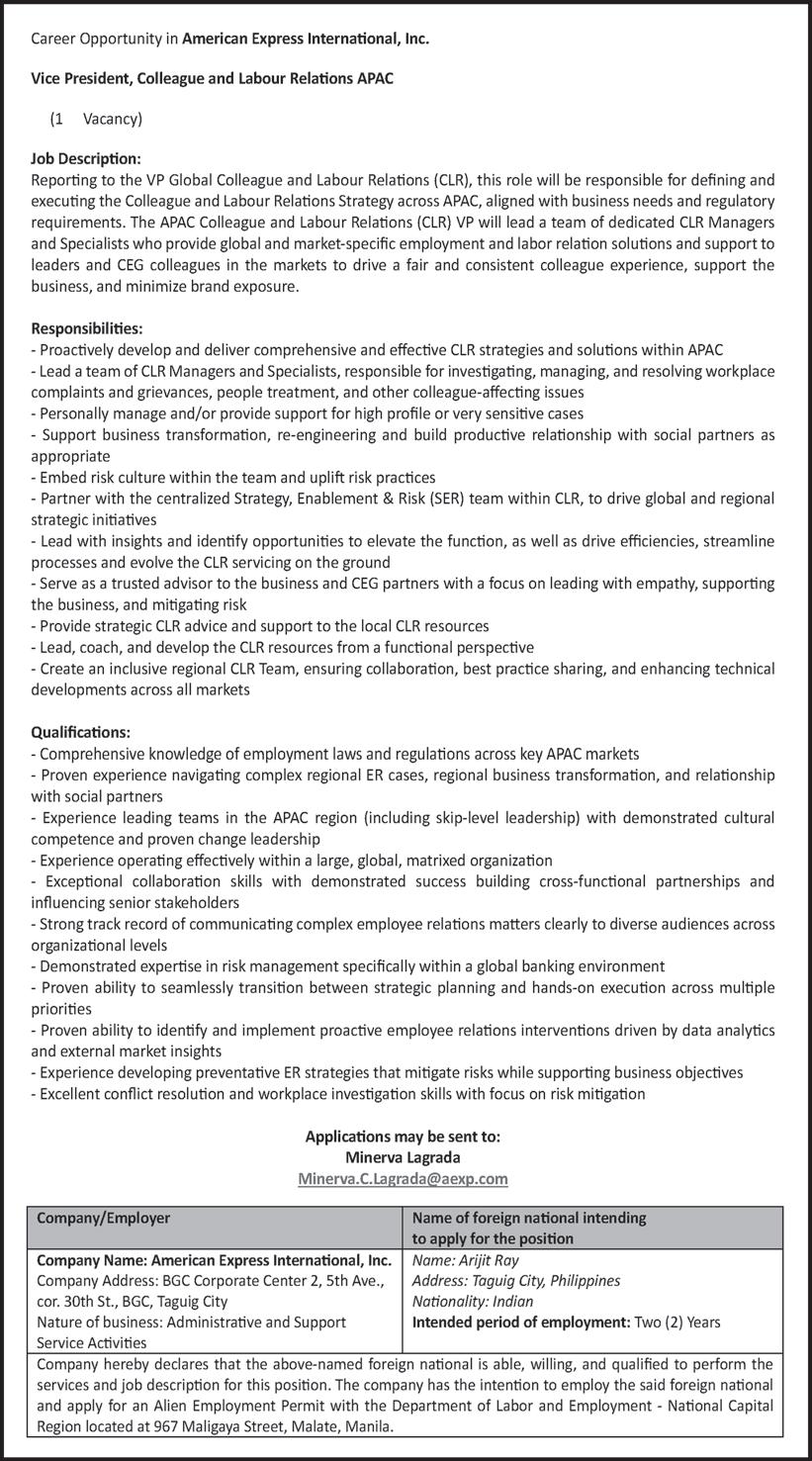
By Eileen Ng The Associated Press
UALA LUMPUR, Ma -
Klaysia—Malaysian Prime Minister Anwar Ibrahim warned Wednesday that global trade is being weaponized as Southeast Asia’s foreign ministers held annual talks ahead of the looming threat of US trade tariffs.
Concerns about US tariffs have jolted the Association of Southeast Asian Nations, a 10-member bloc that includes some of the world’s most trade-dependent economies.
Eight Asean members are among countries that could see duties on their exports to the US skyrocket on Aug. 1. Launching the group’s foreign ministers’ meeting, Anwar said the world is now witnessing an era where “power unsettles principle” and “tools once used to generate growth are now wielded to pressure, isolate and contain.”
Without mentioning the US by name, he again urged Asean to work together to respond to trade threats.
“Our cohesion must not end at declarations,” he said, calling for members to increase intra-Asean
trade, invest in regional integration, and reduce strategic dependencies on external powers. “This is no passing storm,” he said. “It is the new weather of our time.”
Trump first announced tariffs in April, but then delayed them for 90 days to allow for deals to be negotiated. On Monday and Wednesday, he announced new tariffs with rates of between 20 percent-40 percent on a list of countries, which will go into effect Aug. 1 unless new deals are struck. He also threatened to increase tariffs if any countries retaliate.
Many Asean members have launched bilateral talks with the US, but officials have said they plan to hold an Asean-US summit later this year to seek a common position. So far, only Vietnam has secured a deal, bringing down its tariffs from 46 percent to 20 percent. The lists threaten 36 percent tariffs for Thailand and Cambodia, 32 percent for Indonesia, 25 percent for Malaysia and Brunei, 20 percent for the Philippines, and 40 percent for Laos and war-torn Myanmar. Reacting to the economic headwinds, Malaysia’s central bank on
Wednesday cut its benchmark interest rate for the first time in five years.
Separately, Trade Minister Zafrul Aziz said Malaysia will continue tariff talks with the US but won’t compromise on issues impacting national interest and sovereignty. He referred to US requests on policy and laws in areas such as government procurement, halal certification, medical standards and digital tax, without giving details.
“It has to be fair...if the deal does not benefit Malaysia, we should not have a deal,” he said.
In addition to confronting trade fallout, the bloc faces mounting internal challenges including the ongoing civil war in Myanmar and a border dispute between Thailand and Cambodia.
The gathering in Malaysia will be immediately followed by a series of critical meetings with Asean’s major trade partners, including the US, China, Japan, Russia, India, and the European Union, scheduled for Thursday and Friday.
US Secretary of State Marco Rubio, who last week cancelled trips to Japan and South Korea, arrived Thursday for the talks as part of his first visit to Asia since taking office. Other visit -
ing foreign ministers include China’s Wang Yi and Sergei Lavrov of Russia.
Analysts said these talks will test Asean’s ability to assert its voice amid escalating geopolitical tensions.
The bloc hopes to reinforce its commitment to a rules-based trade order while resisting pressure to align exclusively with any one global power.
“Asean must be among those who choose to stand for rules, even when others choose retreat,” Anwar said. Officials said the premier will meet Rubio to discuss the tariff issue.
Analysts said Rubio’s presence signaled renewed US engagement in the region.
It will be a reminder to “the region that Washington remains its most vital economic and security partner,” said Collins Chong Yew Keat, a foreign affairs, strategy and security analyst with Universiti Malaya. But he said that US support may now come with clearer expectations.
“Trump’s administration, while still offering the strongest military deterrence and market access, expects Asean to stop exploiting this security umbrella while cozying up economically to China,” he said.
By Johnson Lai & Christopher Bodeen
The Associated Press
HSINCHU, Taiwan—Taiwan -
ese President Lai Ching-
te watched live-fire drills with US-made Abrams M1A2T tanks Thursday, as part of major annual exercises aimed at boosting the island’s ability to fend off threats from China.
Four of the tanks fired individually, in pairs and as a group at a testing ground south of Taipei on the second day of the Han Kuang exercises that this year are the longest ever at 10 days. The tanks fire both while on the move and in a stationary position and at both stationary and moving
targets, achieving 100% accuracy, according to the army.
Taiwan has contracted to buy 108 of the latest-model tanks from the US for $1.45 billion, allowing it to retire its aged tanks and significantly boosting defenses, especially for the northern part of the island, where most of its high-tech industries are based.
They are part of far-reaching upgrades to Taiwan’s arsenal and training practices, with F-16V jet fighters, HIMARS missile defenses and stealthy unmanned vehicles now entering use.
Lai said this year’s Han Kuang exercises were being conducted on the basis of “large-scale, realistic combat drills.”
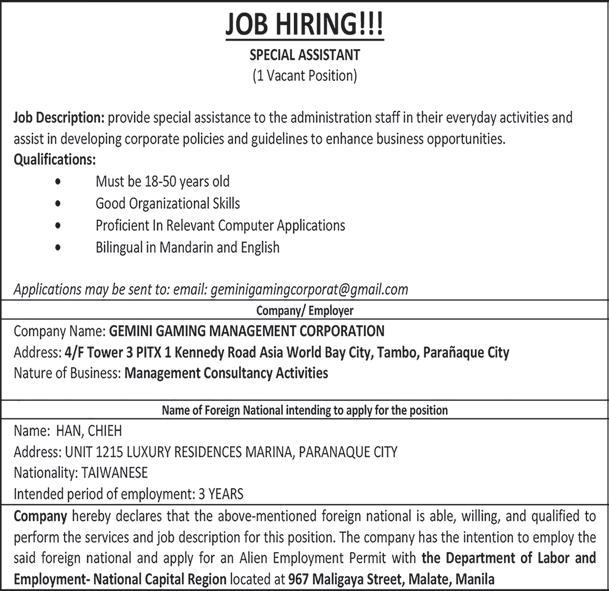

“When out military has greater strength, the nation, society, and people will be safer. Once our country becomes secure, the Indo-Pacific region will be more peaceful and stable,” the president told troops and reporters at the base in Hsinchu county.
China considers Taiwan a renegade province and threatens to use force to bring it under control. The ruling Communist Party’s military branch, the People’s Liberation Army, sends ships, balloons and military ships into waters near Taiwan on a near-daily basis.
The US is Taiwan’s largest supplier of imported defensive weaponry and is bound by law to consider threats to the island a matter of “major concern,” although it remains deliberately
unclear as to whether it would deploy forces to counter a Chinese attack.
Taiwan is also stepping up civilian participation in national defense and Thursday evacuated a food mart and moved customers to a bomb shelter equipped with medical and other facilities. Tanks were also dispatched to one of Taiwan’s international airports in the center of the capital Taipei to guard against an imaginary Chinese air landing operation.
In its unusual fashion, Beijing has derided the war exercises as a farce that will have no effect on its determination to take over the island, whose population overwhelmingly rejects unification with China.
Bodeen reported from Taipei, Taiwan.
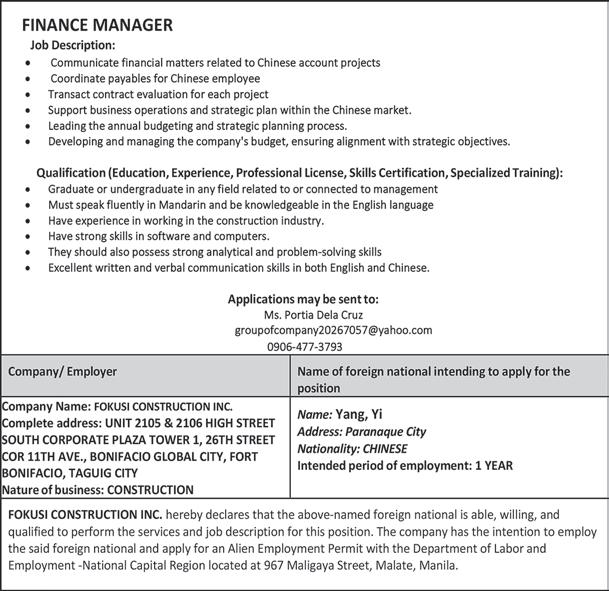

Rescuers search for missing crew from Red Sea attack as US says Yemen rebels may have them
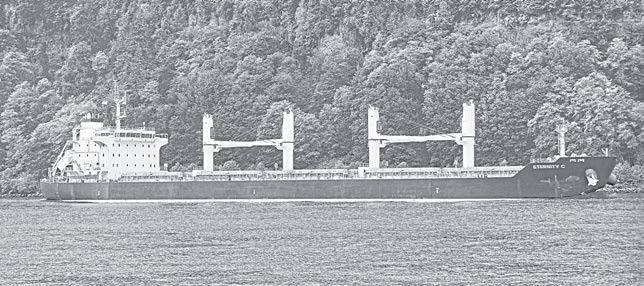
By Jon Gambrell The Associated Press
DUBAI, United Arab Emirates—Rescuers searched Thursday for more than a dozen crew members who went missing after Yemen’s Houthi rebels sank a ship in the Red Sea as the United States alleged the group may “have kidnapped” those on board.
The Houthis released dramatic footage of the sinking of the Liberian-flagged, Greekowned Eternity C, which the rebels targeted with gunfire and explosive drones for hours, killing at least three crew members.
The attack on the Eternity C, as well as the sinking of the bulk carrier Magic Seas after another attack Sunday, represent a new level of violence being employed by the Houthis after months of holding their fire in a campaign they tie back to the Israel-Hamas war in the Gaza Strip.
Meanwhile, a new possible ceasefire in that war—as well as the future of talks between the US and Iran over Tehran’s battered nuclear program—remain in the balance.
The Houthis claimed that it fired a missile at Israel on Thursday morning, which the Israeli military said that it intercepted.
US warns Houthis may have ‘kidnapped’ survivors
A STATEMENT from the European Union naval mission in the Red Sea said the crew of the Eternity C included 22 sailors, among them 21 Filipinos and one Russian, as well as a three-member security team. Rescuers on Wednesday recovered five Filipinos and one Indian.
Three people also were killed during the hourslong attack on the ship, the EU force said, and their nationalities weren’t immediately known.
In footage released by the Houthis, a rebel can be purportedly heard on a VHF ra -
dio transmission offering those on board the ability to flee the sinking vessel. However, it wasn’t clear if any more crew fled and what happened to them.
In a post late Wednesday on the X, the US Embassy in Yemen—which has operated from Saudi Arabia for about a decade now—alleged that the rebels may have taken some of the crew.
“After killing their shipmates, sinking their ship and hampering rescue efforts, the Houthi terrorists have kidnapped many surviving crew members of the Eternity C,” the embassy said. “We call for their immediate and unconditional safe release.”
The Houthis haven’t acknowledged taking any of the fleeing crew members and didn’t mention whether it had any of them in their custody. However, the rebels can take days at times before acknowledging attacks.
Attacks draw condemnation and support for sailors IN the Philippines, Migrant Workers Secretary Hans Cacdac said that he has been leading an effort to reach out to the families of the missing Filipino sailors to update them on the search and rescue efforts.
“It’s human nature that one should be terribly worried and distraught about the situation,” Cacdac told The Associated Press by telephone. “It’s our role in government to be there for them in their utmost hour of need to ensure that not just government services, but throughout this hand-holding process, we will provide the necessary support.”
The Eternity C, flagged out of Liberia but owned by a Greek firm, likely had been targeted like the Magic Seas over its firm doing business with Israel. Neither vessel apparently requested an escort from the EU force.
Jim Gomez contributed to this report from Manila, Philippines.
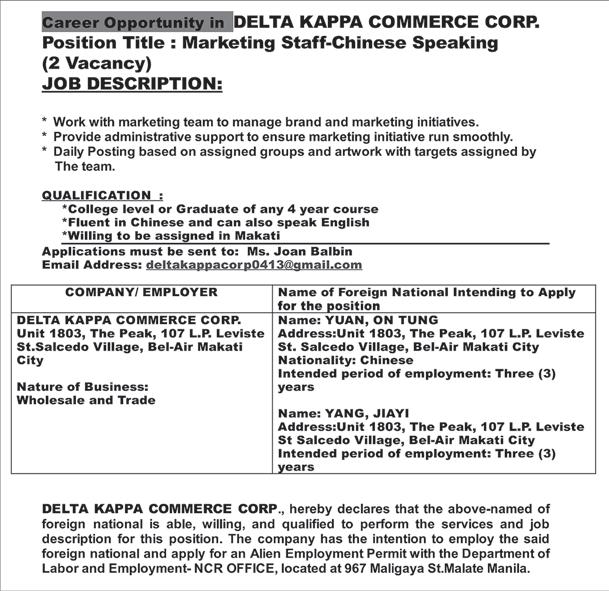

By Joumanna Bercetche, Fiona Macdonald & Grant Smith
ENIOR officials from three of
SOpec’s core producer nations— Saudi Arabia, the United Arab Emirates, and Kuwait—lined up on Wednesday to say that the super-sized addition of supply by the producer club at the weekend was needed by the global market.
Oil prices eked out gains this week, a sign that the market has largely shrugged off the larger-thanexpected output hike announced on Saturday by the Organization of the Petroleum Exporting Countries and allies. Despite the current tightness, forecasters are pointing out that supply growth is at risk of outpacing demand later in the year.
“You can see that even with the increase in several months, we haven’t seen a major buildup in the inventories, which means the market needed those barrels,” Suhail Al Mazrouei, the United Arab Emirates energy minister said on the sidelines of a conference that the group is holding in Vienna. His comments were echoed by officials at the state oil companies of Saudi Arabia and Kuwait.
Signs of a tight market include

crude oil stockpiles at the key US storage hub of Cushing, Oklahoma that are at their lowest seasonally since 2014, as well as a collapse in America’s diesel inventories. Timespreads point to tight supplyand-demand dynamics in the near term. Bloomberg News hasn’t received accreditation to cover the Opec seminar, despite multiple requests. No explanation has been given.
Healthy demand SAUDI ARAMCO, which hiked its key oil prices for customers in Asia a day after the weekend meeting, sees “healthy global oil demand,” despite
trade challenges, tariffs and their impact on the global economy, President and CEO Amin Nasser said at the Opec Seminar in Vienna, according to a video posted on the X platform.
In April, Opec+ announced—to the surprise of the market—the addition of 411,000 barrels a day of production to the global market, repeating the increase again in May and June. It went one step further on Saturday with a hike of 548,000 barrels a day.
Sheikh Nawaf Al-Sabah, chief executive officer of Kuwait Petroleum Corp., told Bloomberg TV in an interview on the sidelines of the seminar that the market is in good shape.
“We’re seeing some potential tightness in the market, which gives us an opportunity to capture market share in the future,” he said.
Bleaker later
STILL , Patrick Pouyanne, chief executive officer of French oil major TotalEnergies SE, said the lack of a bigger price rally during Israel’s recent conflict with Iran was suggestive of a market that’s well supplied.
“The market’s well supplied, by the way,” he said according to a video of his remarks posted on X. “Honestly, I was a bit surprised” by how little the market gained.
Still, the fate of the market beyond summer, when demand typically rises, is less certain.
“Right now, if you look out the window, the market is pretty tight,” Bob McNally, president and founder of Rapidan Energy Group and a former White House energy official, said in Vienna, adding that his assessment is that supply should start to outpace demand later this quarter when refineries will process less crude and the extra barrels start to hit the market.
With assistance from Ben Bartenstein, Salma El Wardany and Nayla Razzouk / Bloomberg
over transparency and press freedom
TBy Will Kennedy
HE Organization of the Petroleum Exporting Countries (Opec) has excluded five of the world’s leading news organizations from covering its biennial oil seminar in Vienna, attended by the group’s ministers and senior industry executives.
Opec did not accredit Bloomberg News, despite repeated requests, and offered no explanation for its decision.
The New York Times, the Financial Times, the Wall Street Journal, and Reuters were also excluded—widening a ban the organization imposed two years ago. Other news organizations were granted access to the conference, which runs Wednesday and Thursday.
“We believe that transparency and a free press serve readers, markets, and the public interest, and we object to this restriction on coverage,” a Reuters spokesperson said in a statement. Bloomberg, Reuters, and the Wall Street Journal were also excluded from the same event in 2023, as well as from a meeting of oil ministers earlier that year. Saudi Oil Minister Prince Abdulaziz bin Salman, Opec’s de facto leader, has publicly criticized journalists for their reporting on the
group. Most meetings are now held online, a move that’s deprived reporters of the traditional opportunity to question ministers before and after production decisions are made. This year’s seminar comes as the group fights to maintain control of the oil market narrative at a time when Wall Street is almost unanimously pessimistic about the prospects for oil prices in the second half of the year.
“We are once again very disappointed that Opec is excluding journalists, including from Bloomberg News, from its seminar,” a spokesperson for Bloomberg News said. “Market transparency is clearly in the public interest, and we continue to strongly advocate for Opec to allow journalists from relevant global news outlets to attend its events.” A spokesperson for the New York Times confirmed they had not been accredited for the event and had been given no reason for the decision. The Financial Times and Wall Street Journal declined to comment. Opec didn’t respond to requests for comment.
Along with Prince Abdulaziz and other Opec ministers, CEOs including the heads of Shell Plc, TotalEnergies SE, and BP Plc spoke at the seminar on its opening day. Bloomberg News
By Kim Tong-Hyung
SThe Associated Press
EOUL, South Korea—A South Korean court early Thursday approved the new arrest of former President Yoon Suk Yeol on charges related to his brief imposition of martial law in December, accepting a special prosecutor’s claim that he poses a risk of destroying evidence.
His criminal case is being handled by a team of investigators under special prosecutor Cho Eun-suk who are pursuing additional charges over Yoon’s authoritarian push, including obstructing official duties, abuse of power and falsifying official documents.
Cho’s team questioned him twice before submitting a request for his ar -
The arrest warrant issued by the Seoul Central District Court sent Yoon back to a detention center near the capital, four months after his release in March, when the same court overturned his January arrest and allowed him to stand trial for rebellion without being held in custody.
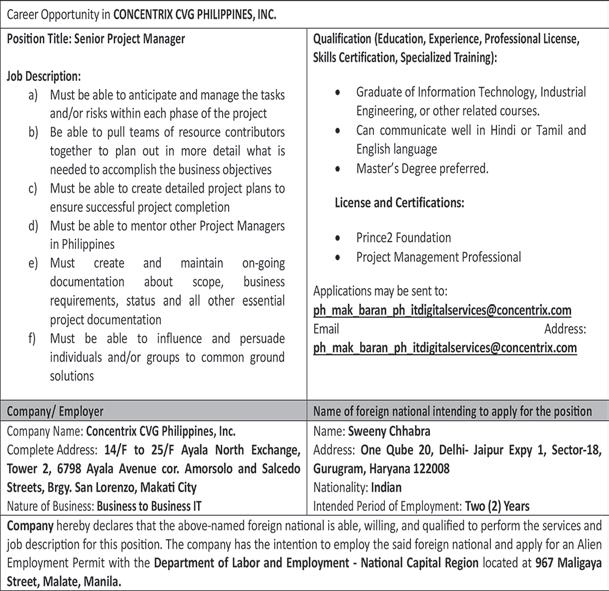
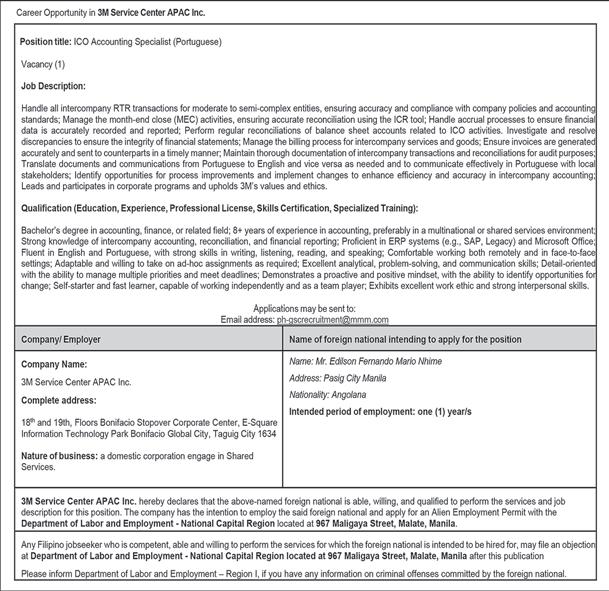
rest warrant to the court on Sunday.
Yoon’s lawyers had described the arrest request as excessive and unsubstantiated. They didn’t immediately react to the court’s decision to approve the arrest of Yoon , who was formally removed from office in April after the Constitutional Court upheld his impeachment.
Yoon didn’t respond to questions by reporters after arriving at the court on Wednesday afternoon for a hearing to review the special prosecutor’s request. After the hearing lasting about seven hours, Yoon was taken
to the detention center to await the court’s decision.
Yoon’s new arrest could mark the beginning of an extended period in custody, potentially lasting months or longer. Yoon can be initially detained at the center for up to 20 days, while the special prosecutor will aim to indict him on additional charges.
If Yoon is indicted on new charges, that could keep him under arrest for up to six months until an initial court ruling. If that court convicts him and issues a prison term, Yoon would serve that sentence as the case possibly
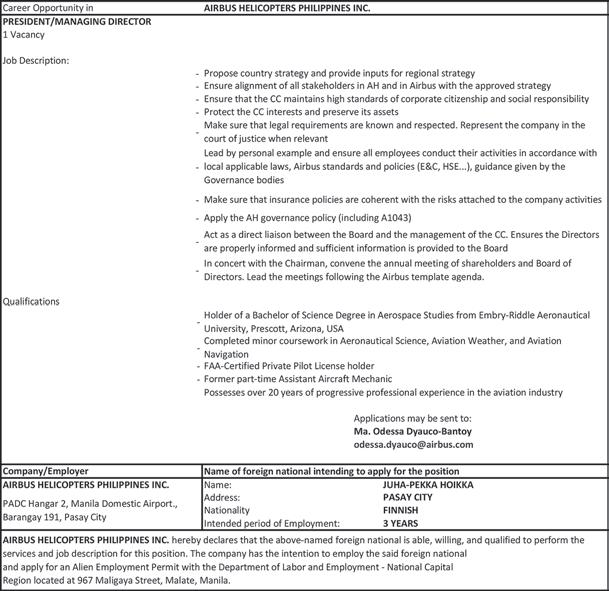

moves up to higher courts. Park Ji-young, a senior investigator on Cho’s team, said they plan to question Yoon again Friday. Yoon was absent from a Thursday hearing at the Seoul court over his earlier indictment on rebellion charges, and his lawyers offered no immediate explanation for his absence.
The former conservative leader described his martial law imposition on Dec. 3 as a necessary step to quash his “anti-state” liberal opponents, accusing them of using their legislative majority to obstruct his agenda. But
Yoon’s decree lasted only hours, after a quorum of lawmakers broke through a blockade of heavily armed soldiers at the National Assembly and voted to lift the measure. Yoon was impeached by lawmakers Dec. 14 and indicted Jan. 26 by public prosecutors who accused him of masterminding an attempted rebellion, describing his power grab as an illegal attempt to seize the legislature and election offices and detain political opponents. The charges are punishable by the death penalty or life imprisonment.

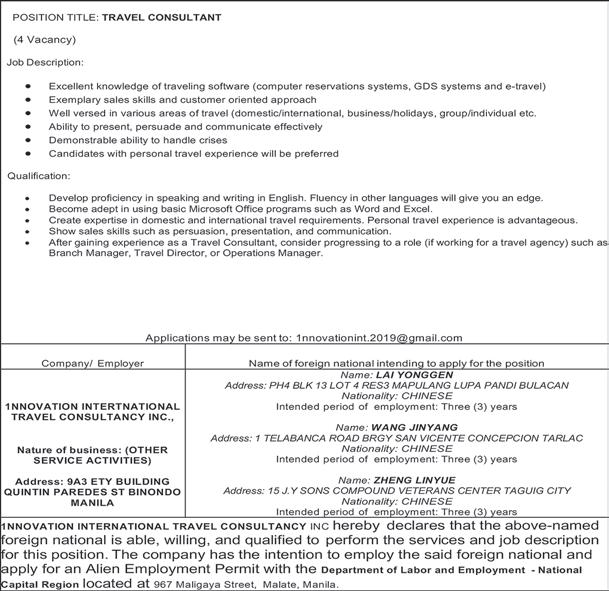
By Daniel Carvalho, Barbara Nascimento & Simone Iglesias
DONALD Trump’s threat to impose 50% tariffs on Brazilian goods sent the country’s currency plunging as the US leader sharply escalated a dispute with Latin America’s largest nation and leftist leader Luiz Inacio Lula da Silva.
In a letter posted to his social media account, Trump cited Jair Bolsonaro—the right-wing former president and Lula rival who is facing a trial on charges that he attempted a coup following his 2022 election defeat. Trump made a direct link to politics, saying he was making the change “due in part to Brazil’s insidious attacks on Free Elections, and the fundamental Free Speech Rights of Americans.”
The charges against Bolsonaro, a leader who mimicked Trump’s political style during his presidency, stem from an investigation into post-election riots in Brazil’s capital that have drawn comparisons to the Jan. 6, 2021 insurrection attempt in Washington.

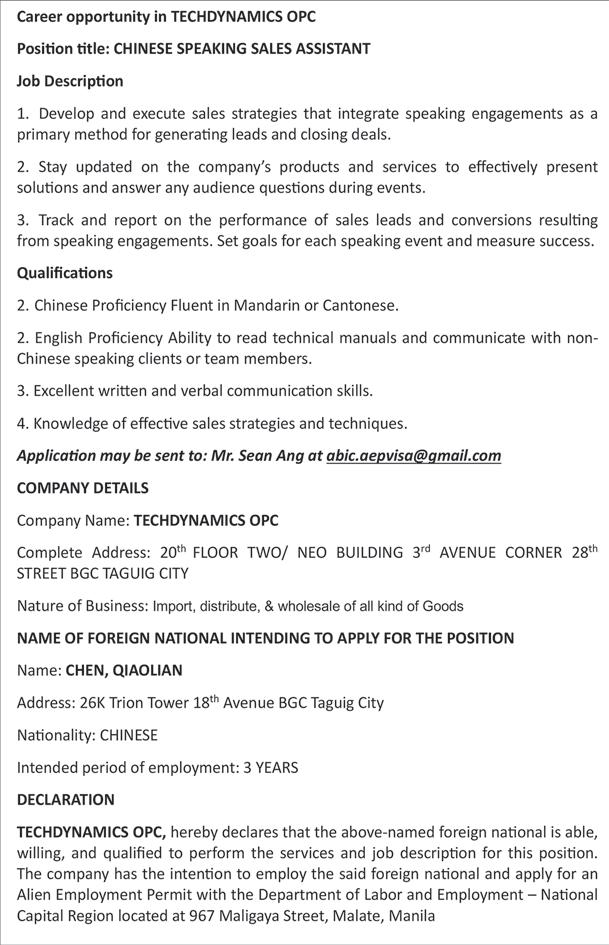
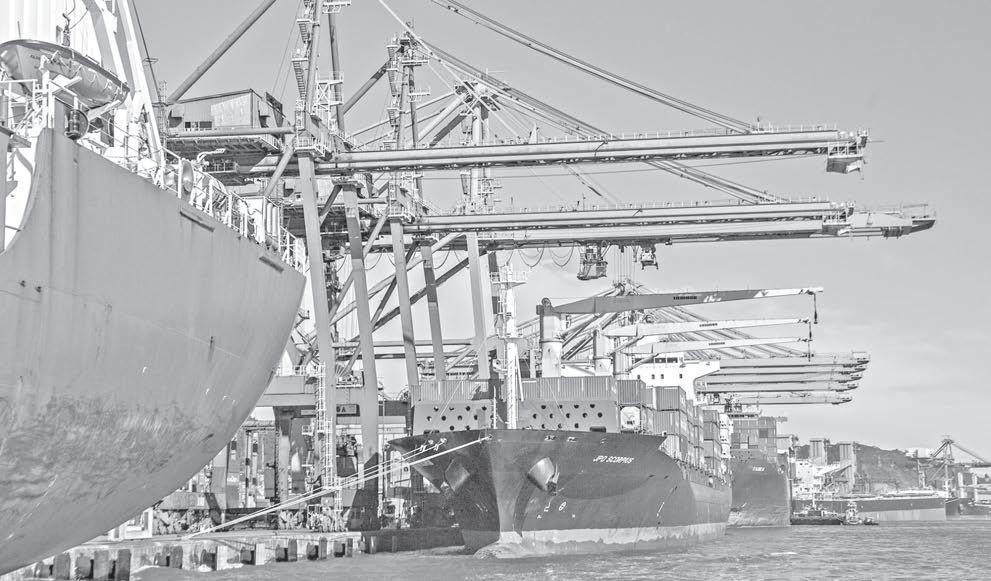
Bolsonaro has repeatedly appealed for Trump’s help as his legal woes mount.
The Brazilian real slumped nearly 3 percent against the US dollar on the back of the announcement, while the iShares MSCI Brazil ETF—the largest US-listed exchange-traded fund tracking the nation’s equities—was down almost 2 percent in post market trading.
Brazil had been set to face the minimum 10 percent levy under the so-called “reciprocal” tariffs Trump originally unveiled in April.
The letter, the latest of more than 20 posted by Trump in recent days, was the first substantial upward revision from previously announced rates. While it borrows language about “reciprocity” from the others, Brazil is the first receiver that does not run a goods trade surplus with the US—suggesting particular

frustration on the part of Trump.
Shortly after the announcement, Lula called top cabinet members— including Finance Minister Fernando Haddad, Foreign Minister Mauro Vieira, and Vice President Geraldo Alckmin, who also heads Brazil’s ministry of industry and trade—into a meeting at the presidential palace, according to two people with knowledge of the situation.
‘Reciprocity’
IN a social media post late on Wednesday, Lula said Brazil will not be “tutored” by anyone, adding the case against those who planned a coup is a matter solely for the country’s justice system and “not subject to interference or threat.”
“Any unilateral rate hikes will be responded to using Brazil’s economic reciprocity law,” Lula wrote. “The sovereignty, respect and intransigent defense of the Brazilian people’s interests are what guide our relations with the world.”
The US is Brazil’s second-largest trading partner, trailing only China, and such a high tariff could cause significant damage to some of the South American nation’s industries.
“Steel products, transportation equipment (mainly aircraft and aircraft parts), specialized machinery (such as civil engineering equipment), and non-metallic minerals account for a significant portion of Brazilian exports to the US,” said Fe -
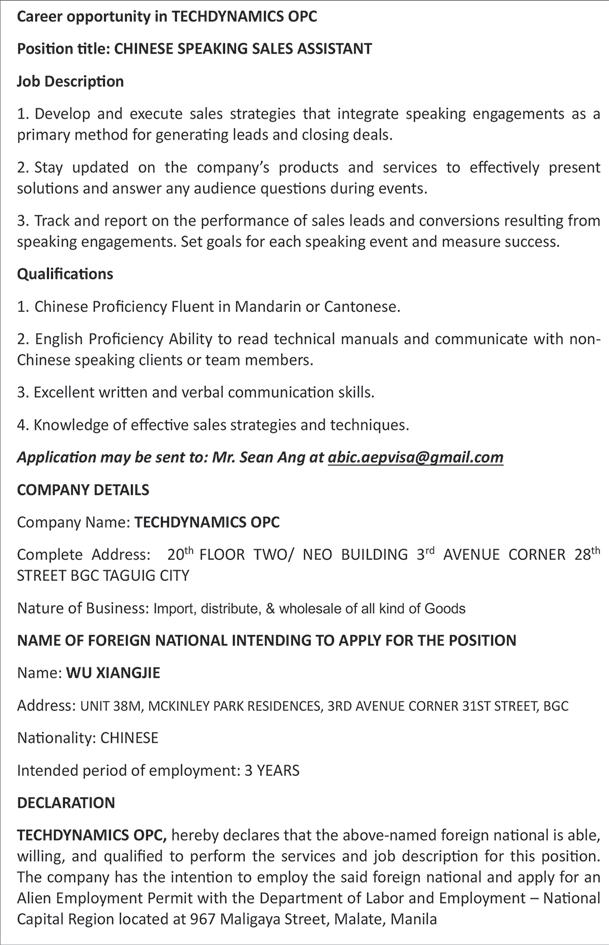
lipe Arslan, CEO at Morada Capital. Planemaker Embraer ADRs tumbled as much as 9 percent in afterhours trading on the news.
Beyond the economic repercussions, analysts expressed concerns about the political ramifications of the tariffs. The US and Brazil are historic partners that have long enjoyed strong relations even when led by presidents with ideological differences, a dynamic Trump’s announcement threatens to put at risk.
“It’s not just a matter of bilateral trade,” said Solange Srour, head of Brazil macroeconomics at UBS Global Wealth Management. “These tariffs are showing that our relations between countries as a whole, institutionally, are degraded and damaged. 50 percent is a tariff that, in many cases, can make exports unfeasible.”
Trump’s announcement came just days after he’d threatened to impose additional tariffs on members of the BRICS bloc of emerging market nations over its supposed “Anti-American policies.” BRICS leaders hosted by Lula in Rio de Janeiro this week had criticized trade-distorting tariff policies and military strikes on Iran in their official declaration, moves that put them at odds with Trump even as they shied away from direct challenges to the US.
After making little mention of Brazil over the initial months of his term, Trump also rushed to the defense of Bolsonaro on Monday, accusing the
South American nation of politically persecuting the former president. In the letter, Trump reiterated his call on authorities to drop charges against Bolsonaro over the alleged coup attempt.
“This Trial should not be taking place. It is a Witch Hunt that should end IMMEDIATELY!” Trump wrote. Trump also ordered US Trade Representative Jamieson Greer to launch a Section 301 probe of Brazil, citing what he said were the country’s “continued attacks on the Digital Trade activities of American Companies.” Such a probe, which are used to investigate potentially unfair trade practices, could lead to additional US penalties against Brazil. On Monday, Lula blasted Trump at the end of the BRICS summit, telling him to mind his own business and calling him “irresponsible for threatening tariffs on social media.” He also urged world leaders to find ways to reduce international trade’s reliance on the dollar.
A spokesperson for Brazil’s Supreme Court, which is overseeing Bolsonaro’s trial, declined to comment. Earlier Wednesday, Brazil’s foreign affairs ministry called the top US representative in the country to a meeting to explain statements about Bolsonaro.
US trade
BRAZIL is unusual among Trump’s most recent tariff targets because it runs a deficit in trade with the US, while almost all the others post large surpluses. In 2024 Brazil imported some $44 billion of American products, while US imports from Brazil were around $42 billion, according to the Census Bureau.
Brazil ranks among the top 20 US trading partners. Out of the other seven countries cited in Trump’s announcements Wednesday, only the Philippines—which sent some $14.1 billion of goods to the US last year— makes it into the top 50. Imports from the remaining six nations put together amounted to less than $15 billion last year, with Iraq— an exporter of crude oil—accounting for about half of that sum. Ahead of the announcement, Alckmin cited the trade surplus to argue that hiking the tariffs would be unfair and would hurt the US economy.
With assistance from Vinícius Andrade, Leda Alvim, Michael Hirtzer, Ilena Peng, Derek Wallbank, Josh Wingrove and Justin Sink / Bloomberg
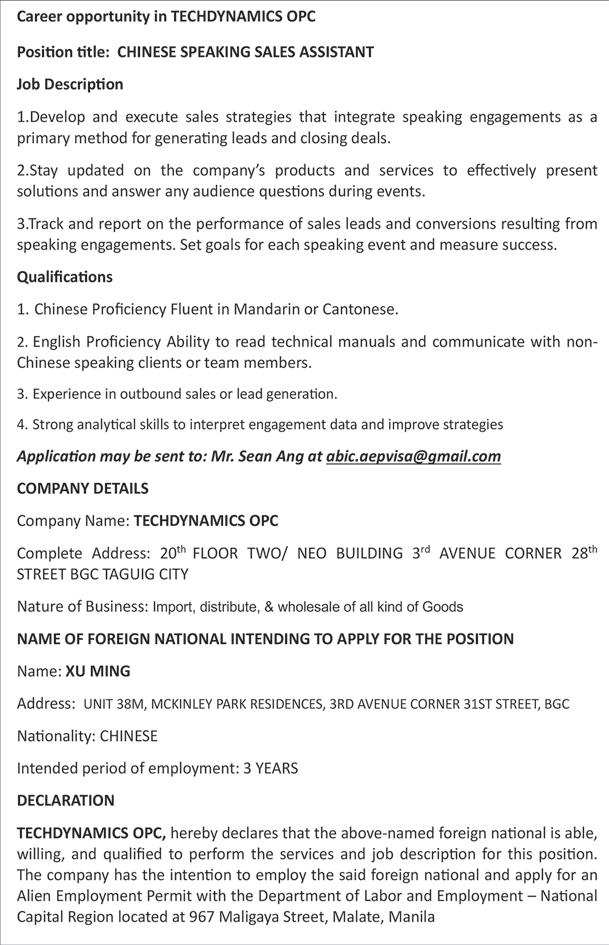
Editor: Angel R. Calso
By Tia Goldenberg The Associated Press
JERUSALEM—As Israel and Hamas move closer to a ceasefire agreement, Israel says it wants to maintain troops in a southern corridor of the Gaza Strip—a condition that could derail the talks.
An Israeli official said an outstanding issue in the negotiations was Israel’s desire to keep forces in the territory during a 60-day truce, including in the east-west axis that Israel calls the Morag corridor. The official spoke on condition of anonymity because they weren’t authorized to talk with the media about the negotiations.
Keeping a foothold in the Morag corridor is a key element in Israel’s plan to drive hundreds of thousands of Palestinians south toward a narrow swath of land along the border with Egypt, into what it has termed a “humanitarian city.”
Critics fear the move is a precursor to the coerced relocation of much of Gaza’s population of some 2 million people, and part of the Israeli government’s plans to maintain lasting control over the territory.
Hamas, which still holds dozens of hostages and refuses calls by Israel to surrender, wants Israel to withdraw all of its troops as part of any permanent truce. It is adamantly opposed to any lasting Israeli presence inside Gaza.
As part of the proposed truce, Israel and Hamas would hold fire for 60 days, during which time some hostages would be freed and more aid would enter Gaza.
Previous demands by Israel to maintain troops in a separate corridor stalled progress on a ceasefire
By Vasilisa Stepanenko & Hanna Arhirova
KThe Associated Press
YIV, Ukraine—Russia pounded Ukraine’s capital with another major missile and drone attack overnight into Thursday, causing fires in areas across the city and killing two people a day after the heaviest aerial attack of the three-year war so far, according to Ukrainian officials.
“These people were killed by the
deal for months.
The office of Prime Minister Benjamin Netanyahu declined to comment on how the Morag corridor was playing into ceasefire talks. Netanyahu was in Washington this week to discuss the ceasefire and other matters with US President Donald Trump, who has pushed both sides to bring an end to the war in Gaza.
Israel’s desire to keep troops in Gaza was among the ceasefire sticking points discussed Tuesday by senior officials from the US, Israel and Qatar, according to a White House official who spoke on condition of anonymity because they were not authorized to comment publicly.
“We want to have peace. We want to get the hostages back. And I think we’re close to doing it,” Trump said Wednesday in response to a question about the officials’ meeting.
Hamas said in a statement late Wednesday that Israeli troop withdrawal from Gaza was one of several remaining sticking points in the talks, without mentioning Morag specifically.
Morag corridor is one of three that carve up Gaza
During their 21-month campaign in Gaza, Israeli forces have seized wide swaths of land, including three east-west corridors that have carved up the Palestinian
enclave.
In April, Israel seized the Morag corridor—named after a Jewish settlement that existed in Gaza before Israel withdrew from the territory in 2005.
The corridor, located between Gaza’s southernmost city of Rafah and its second-largest city Khan Younis, stretches about 12 kilometers (7 miles) from Israel to the Mediterranean coast and is about 1 kilometer (half a mile) wide.
At the time, Netanyahu said it was part of a strategy of “increasing the pressure step by step” on Hamas.
Netanyahu called Morag a “second Philadelphi,” referring to another corridor that runs along Gaza’s border with Egypt. Israel has repeatedly insisted it must maintain control of Philadelphi to prevent cross-border arms smuggling. Egypt denies arms are moved through its territory.
Since the collapse of the last ceasefire in March, Israel has also reasserted control of the Netzarim corridor, which cuts off Gaza’s northern third from the rest of the territory and which it used to prevent Palestinians from returning to northern Gaza before the last truce.
It was not immediately clear how Israeli troops in the Netzarim and Philadelphi corridors factor into the ceasefire negotiations.
Morag allows Israel to set its population movement plan into motion
The foothold in Morag has effectively cut the Rafah area off from the rest of Gaza.
Rafah, once a city of tens of thousands of people, is currently all but flattened and emptied of its population following Israeli evacuation orders.
With those conditions in place, Israel says it seeks to turn the Rafah area into a “sterile zone” free of Hamas militants where it wants

to move hundreds of thousands of Palestinians into a “humanitarian city.”
Most of Gaza’s population has already been displaced multiple times throughout the war and squeezed into ever smaller pieces of land. Rights groups see the planned new push to get them to head south as forcible displacement.
Israel’s idea is to use Morag as a screening zone for Palestinians being moved south, to prevent Hamas from infiltrating the area, according to Kobi Michael, a senior researcher at two think tanks, the Institute for National Security Studies and Misgav. That would allow Israeli troops to operate further north without Palestinian civilians getting caught in the crossfire, he said.
A no-go for Hamas
MICHAEL said the move might allow Israel to ramp up the pressure on—and possibly defeat—Hamas in northern Gaza, where guerillastyle fighting continues to dog Israeli troops. And that, he added, could lay the groundwork for an end to the war, which Israel has vowed to continue until Hamas is destroyed.
But critics say the plan to move

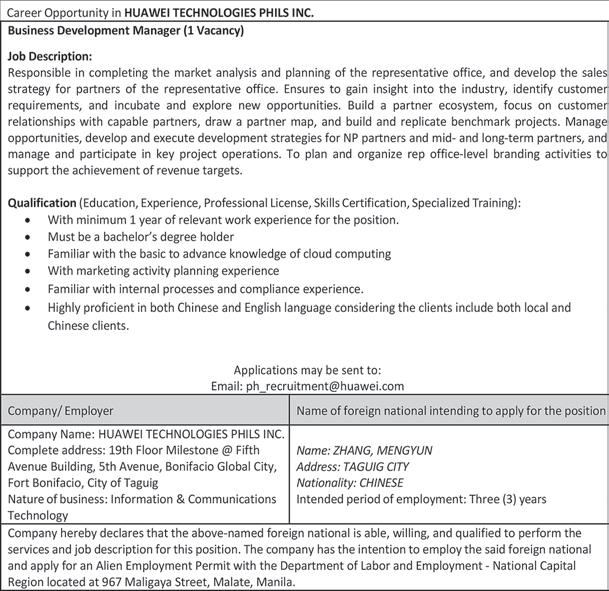
Russians. This is a terrible loss. My condolences to their families and loved ones,” said Tymur Tkachenko, head of the Kyiv Regional Administration.
He said at least 13 people were injured, and there were fires in at least five other districts at residential buildings, cars, warehouses, office and other non-residential structures.
In a post on the Telegram messaging app, Kyiv mayor Vitali
See “Kyiv,” A10
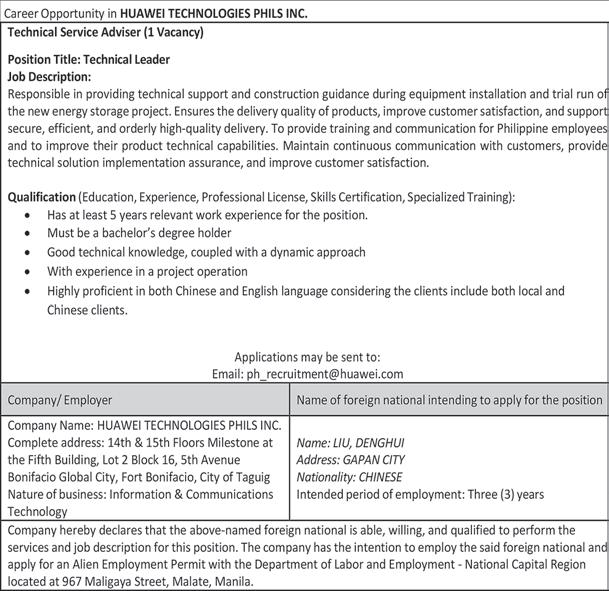
Palestinians south paves the way for the expulsion of Palestinians from the territory and for Israel to assert control over it, a priority for Netanyahu’s powerful far-right governing partners.
Netanyahu has said that any departures would be “voluntary.”
But Palestinians and human rights groups fear that concentrating the population in an area hard-hit by the war with little infrastructure would create catastrophic conditions that leave Palestinians no choice but to leave.
Michael Milshtein, an Israeli expert on Palestinian affairs and former military intelligence officer, called the plan to move Palestinians south through the Morag corridor a “crazy fantasy.” He said the current negotiations could crumble over the Israeli demand because it signaled to Hamas that Israel does not intend to withdraw forces after the ceasefire expires, something Hamas will not accept.
“For Hamas, it’s a no-go,” he said. “If those are the terms, I can’t see Hamas agreeing.”
The Associated Press writer Aamer Madhani in Washington contributed to this report.
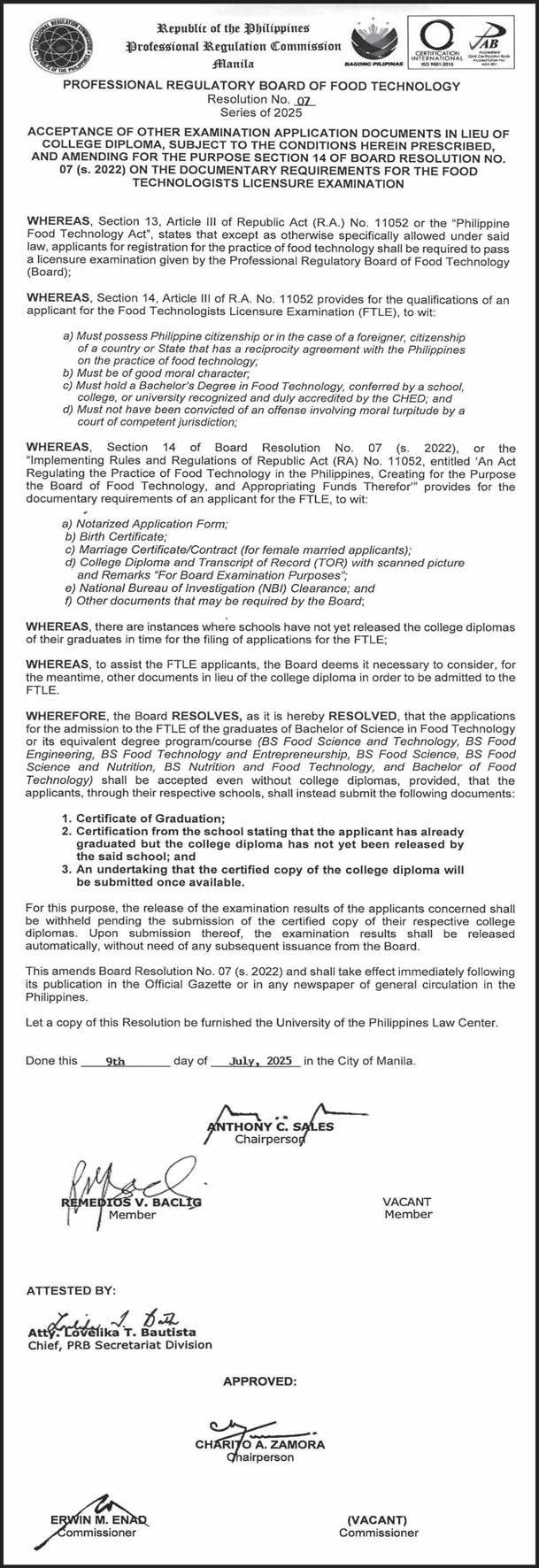
A10 Friday, July 11, 2025
By Sibi Arasu The Associated Press
year from June to September, a series of heavy rains known as monsoons sweep through the Indian subcontinent, providing relief from heat, irrigating the country’s farms and replenishing its rivers.
However, as global heat increases, the rain is becoming more erratic and intense, creating the conditions for deadly floods. Nearly 1,300 people died in India throughout 2024 due to heavy rain and floods. Hundreds of rain-related deaths have already occurred this year in the South Asian region, which includes India, Pakistan, Bangladesh, Bhutan, Sri Lanka, Afghanistan, Maldives and Nepal.
Climate experts say the high temperatures and heavy rain are also contributing to the melting of glaciers in the mountainous Himalayan region, causing catastrophic flooding and landslides.
Monsoon season becomes more dangerous
THE South Asian region has traditionally had two monsoon seasons. One typically lasts from June to September, with rains moving southwest to northeast. The other, from roughly October to December, moves in the opposite direction.
But with more planet-warming gases in the air, the rain now only loosely follows this pattern. This is because the warmer air can hold more moisture from the Indian Ocean, and that rain then tends to get dumped all at once. It means the monsoon is
punctuated with intense flooding and dry spells, rather than sustained rain throughout.
“We are witnessing a clear climatic shift in monsoon patterns across South Asia,” said Roxy Mathew Koll, a climate scientist at the Indian Institute of Tropical Meteorology in Pune and author of several United Nations climate reports.
Traditionally, people in India and neighboring countries excitedly awaited the monsoon rains, which would finally mean the end of summer heat. But attitudes are changing as disasters increase during the rainy seasons.
“The frequency and intensity of extreme rainfall events are increasing, often overwhelming drainage infrastructure in urban areas and triggering flash floods,” Koll said.
Higher temperatures and longer periods of drought are also making farming harder in South Asia, climate experts said.
“More than 60% of the people in South Asia are dependent on agriculture, and almost all of them are dependent on monsoon rainfall,” said Finu Shreshta, a climate scientist at Kathmandu, Nepal-based International Centre for Integrated Mountain Development.

Mountain regions are seeing more glacial lakes overflowing A 2023 report by Shreshta’s organization found that glaciers are melting at unprecedented rates across the Hindu Kush and Himalayan mountain ranges. The study found that at least 200 of the more than 2,000 glacial lakes in the region are at risk of overflowing, which can cause catastrophic damage downstream. Heavy monsoon rains can exacerbate the problem.
“A lot of the mountain areas tend to have more warming than the global average, resulting in more glaciers melting,” said Miriam Jackson, glaciologist at the International Cryosphere Climate Initiative.
An October 2023 glacial lake
EU chief von der Leyen faces confidence vote; Hungary’s leader says she must go
BBy Lorne Cook The Associated Press
RUSSELS—European Union
lawmakers will hold a confidence vote Thursday on the head of the bloc’s powerful executive arm, Ursula von der Leyen, with Hungarian Prime Minister Viktor Orbán leading calls for her to be ousted. The censure motion, the first at the European Parliament in over a decade, was brought against the European Commission president by a group of hard-right lawmakers. To pass, it requires a twothirds majority vote in favor. Von der Leyen could be forced to resign if she loses, but she is virtually guaranteed to win as most of the political groups in the assembly have signaled they would vote against the motion. She is not expected to attend the vote in Strasbourg, France.
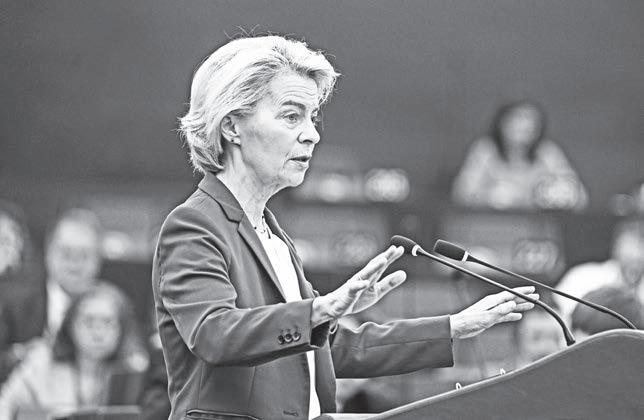
The motion contains a mix of allegations against von der Leyen including text messaging privately with the boss of Covid-19 vaccine maker Pfizer, misuse of EU funds and interference in elections in Germany and Romania. Orbán said on Facebook that the vote “will be the moment of truth: on one side the imperial elite in Brussels, on the other patriots and common sense. There is no getting out of it, it is essential to make a choice.”
vaccines for around 450 million citizens during the pandemic— and her European People’s Party, which is the largest political family in the assembly.
They’re accused of cozying up to the hard right to push through their agenda. The EU parliament shifted perceptibly to the political right after Europe-wide elections a year ago.
The second biggest group, the Socialists and Democrats, has said that the censure motion was a result “of the EPP’s irresponsibility and the double games.”
overflow in the Indian state of Sikkim triggered flooding that killed 55 people and damaged bridges, buildings and a hydropower dam that was under construction.
Heavy rainfall and increasing heat are leading to snow and ice avalanches, rockfalls and other events that can trigger the lakes to breach or overflow, Shreshta said.
“Even small glacial lakes are now breaching and causing damage,” she said.
Early warning systems and long-term planning can help
Installing early warning systems and building in less risky areas can help reduce damage from heavy rains, climate experts say.
“If you know a flood is com -
ing, then people can get to higher ground and there could be a sort of standard early warning system along a river that sends out a siren,” Jackson said, adding that social media and messaging applications can help people spread warnings to those downstream.
Koll, the Pune-based scientist, said that rapid urbanization, shrinking floodplains and loss of natural drainage also exacerbate damage from heavy rains. Koll said that most government response currently comes after disasters, and there is a lack of long-term planning.
“In the future monsoon, extreme rains are projected to intensify further, in addition to sporadic water shortages. Hence, we need proactive, long-term strategies that combine science, policy, and community engagement,” he said. Jackson said the biggest issue, however, is to try to reduce emissions of planet-heating gases because there are limits to adapting to extreme weather.
“If we continue with, you know, business as usual, and we have the same kind of emissions, then the world is going to keep on getting warmer and there will be more intense rain and floods. At some point, we could go beyond the limits of adaptation,” she said.
By Jill Lawless The Associated Press
LONDON—After the bonhomie and banquets of a formal state visit, Prime Minister Keir Starmer and President Emmanuel Macron are turning to a topic that has stymied successive British and French governments: how to stop migrants from crossing the English Channel in small boats.
At a UK-France summit on Thursday that caps Macron’s three-day stay, senior officials from the two countries will try to seal deals on economic growth, defense cooperation and—perhaps trickiest of all—unauthorized migration.
Klitschko said rescue workers were working at a residential building in Shevchenkivskyi District, after falling debris caused a fire on the top floor of an apartment building.
He said three of the injured had shrapnel wounds.
Karyna Holf, 23, was in the living room near the window when she heard a whistling sound from the incoming weapon. Moment later, little was left of the room but debris.
“After such a shock, when you know from your own experience what it’s like to lose everything,” she said. “I don’t even know what
He posted: “Madam President, the essence of leadership is responsibility. Time to go!” Von der Leyen’s commission has frequently clashed with Orbán over his staunchly nationalist government’s moves to roll back democracy. The commission has frozen Hungary’s access to billions of euros in EU funds.
comes next. All I have now is a backpack, a phone, a winter coat — that’s it. This is my whole life now.”
Holf said she was grateful to have her parents to turn to, but added, “There are people who have no one at all.”
Russia has recently sought to overwhelm Ukraine’s air defenses with major attacks that include increasing numbers of decoy drones. The previous night, it fired more than 700 attack and decoy drones, topping previous nightly barrages for the third time in two weeks.
More people are seeking shelter during attacks, spending nights in metro stations and underground parking lots. One Kyiv station worker said more than a thousand
The vote has been a lightning rod for criticism of Von der Leyen—who led the EU drive to find
people, including 70 children, took refuge there last night as Russian strikes intensified. One of them was 32-year-old Kyiv resident Alina Kalyna.
“The drone attacks a year ago were one thing, and now they’re a completely different thing. We’re exhausted,” she said. “I sleep poorly, I recover poorly, in fact I no longer recover, I am just somehow on a reserve of energy, of which I have a little left, I just somehow live and exist,” said Kalyna.
US President Donald Trump said Tuesday that he was “not happy” with Russian President Vladimir Putin, who hasn’t budged from his ceasefire and peace demands since Trump took
During debate on Monday, S&D leader Iratxe García Pérez said to the EPP: “Who do you want to govern with? Do you want to govern with those that want to destroy Europe, or those of us who fight every day to build it?”
The EPP has notably worked with the hard right to fix the agenda for hearing von der Leyen’s new commissioners when they were questioned for their suitability for their posts last year, and to reject an ethics body meant to combat corruption.
office in January and began to push for a settlement.
Trump said Monday that the US would have to send more weapons to Ukraine, just days after Washington paused critical weapons deliveries to Kyiv.
On Wednesday, the US resumed deliveries of certain weapons, including 155 mm munitions and precision-guided rockets known as GMLRS, two US officials told The Associated Press on condition of anonymity so they could provide details that hadn’t been announced publicly. It’s unclear exactly when the weapons started moving.
The Associated Press reporter Tara Copp in Washington contributed.
Macron and Starmer also will visit a military base and dial in to a planning meeting of the “ coalition of the willing, “ a UK- and France-backed plan for an international force to guarantee a future ceasefire in Ukraine.
During a meeting inside 10 Downing St. on Wednesday, the two leaders agreed that tackling small boat crossings “is a shared priority that requires shared solutions, including a new deterrent to break the business model” of people-smuggling gangs, Starmer’s office said.
It said they would aim for “concrete progress” on Thursday.
Channel crossings are a longstanding challenge
BRITAIN receives fewer asylum-seekers than Mediterranean European countries, but sees thousands of very visible arrivals each year as migrants cross the 20-mile (32 kilometer) channel from northern France in small, overcrowded boats.
About 37,000 people were detected crossing the channel in 2024, and more than 20,000 made the crossing in the first six months of 2025, up by about 50% from the same period last year. Dozens of people have died trying to reach the English coast.
Britain and France agree the dangerous and unregulated crossings are a problem, but have long differed on how to address it.
The UK wants France to do more to stop boats leaving the beaches, and has paid the Paris government hundreds of millions of pounds (dollars, euros) to increase patrols and share intelligence in an attempt to disrupt the smuggling gangs.
“We share information to a much greater extent than was the case before,” Starmer told lawmakers in the House of Commons on Wednesday. “We’ve got a new specialist intelligence unit in Dunkirk and we’re the first government to persuade the French to review their laws and tactics on the north coast to take more effective action.”
Macron says Britain must address “pull factors” like the perception it is easy for unauthorized migrants to find work in the U.K. Many migrants also want to reach Britain because they have friends or family there, or because they speak English.
Solutions have proved elusive AS far back as 2001, the two countries were discussing ways to stop migrants stowing away on trains and trucks using the tunnel under the channel.
Over the following years, French authorities cleared out camps near Calais where thousands of migrants gathered before trying to reach Britain. Beefed up security sharply reduced the number of vehicle stowaways, but from about 2018 people-smugglers offered migrants a new route by sea.
“You see that pattern again and again, where smuggling gangs and migrants try to find new ways to cross from France to the U.K.,” said Mihnea Cuibus, a researcher at the University of Oxford’s Migration Observatory. “The authorities crack down on that, and then gradually you see migrants and gangs try to adapt to that. And it becomes a bit of a game of cat and mouse.”
Cooperation on stopping the boats stalled after Britain’s acrimonious split from the European Union in 2020, but in the past few years the countries have struck several agreements that saw the U.K. pay France to increase police and drone patrols of the coast.
Britain’s previous Conservative government came up with a contentious plan in 2022 to deport asylum-seekers arriving by boat to Rwanda. Critics called it unworkable and unethical, and it was scrapped by Starmer soon after he took office in July 2024.
Britain hopes for a returns deal with France STARMER is staking success on closer cooperation with France and with countries further up the migrants’ routes from Africa and the Middle East.
British officials have been pushing for French police to intervene more forcefully to stop boats once they have left the shore, and welcomed the sight of officers slashing rubber dinghies with knives in recent days. France is also considering a UK proposal for a “one-in, one-out” deal that would see France take back some migrants who reached Britain, in return for the UK accepting migrants seeking to join relatives in Britain.
Continued from A2
Echoing these concerns, Federation of Free Workers (FFW) President Sonny Matula stressed that the United States remains the Philippines’ single largest export destination, accounting for 16.6 percent of total shipments.
He warned that the tariff increase would likely hit key export categories— electronics and semiconductors, garments and textiles, and agro-industrial products such as coconut oil, canned tuna, and bananas.
Matula warned the effects may ripple beyond goods.
While the business process outsourcing (BPO) sector does not export physical products, it remains, he noted, closely tied to US corporate spending and could be affected by shifts in investor sentiment and tightening budgets in the face of economic uncertainty.
“Given this increasingly protectionist global trade climate, FFW urges the Philippine government to...protect and support domestic industries, especially in manufacturing, agribusiness, and services, through strategic subsidies, upskilling programs, and robust job creation policies,” he said.
Economists earlier told this newspaper that escalating trade wars could drive up both unemployment and underemployment, particularly in export-reliant economies like the Philippines.
According to Ateneo de Manila University (ADMU) economics professor Fernando T. Aldaba, should a global recession arise from mounting trade tensions, more Filipinos could be pushed into joblessness or forced to take shorter working hours.
If trade tensions escalate, Philippine exports could suffer from weakening global demand, while higher tariffs may drive up input costs—squeezing margins and
worth the effort, it is worth looking into.”
“We don’t want to leave any stone unturned. This is not only about a claim of one person but this has been corroborated by several informants,” he added.
The divers, Clavano said, will likely focus on the lake bed since based on the information
law, digital infra needed to tax online gambling–Arsi
ride on a bus going to Digos City, Davao del Sur.
She told her parents to call her when they were near or at the bus terminal to ensure that they would not be tricked
Continued from A4
In September 2023, the President Marcos signed the Trabaho Para Bayan (TPB) Act that will pave the way for the creation of a national master plan to address unemployment, underemployment and youth unemployment.
slowing production in sectors dependent on foreign-sourced components,” he said.
Recent PSA data show the country’s total external trade in goods reached USD17.87 billion in May 2025—a 2.7-percentage points increase from the same month last year.
At least 59.2 percent (USD 10.58 million) of these were imported goods, while the remaining 40.8 percent (USD 7.29 million) were exported goods.
Despite growing concern, the Department of Labor and Employment (DOLE) maintained that current government policies are adequate to cushion the blow. (Related: https://businessmirror. com.ph/2025/04/30/dole-to-lean-onexisting-nets-vs-trade-war-job-cuts/)
It said the country remains “competitive” in terms of labor and ease of doing business, and that these advantages will help protect Filipino workers from large-scale job losses.
Trade dependence under scrutiny MEANWHILE , in a separate statement, Trade Justice Pilipinas co-convenor Joseph Purugganan called on Southeast Asian governments to reevaluate their exportdriven development strategies.
“Today’s tariff hike is not just a trade issue; it exposes the deep flaws of an export-dependent development strategy that leaves our economy at the mercy of global markets and the political whims of foreign leaders. It’s time to rethink,” he said.
Purugganan also sought deeper Asean economic integration, more balanced trade relationships with countries that respect sovereign development goals, and a pivot toward domestic-led growth.
“We need a development path that prioritizes resilience over dependency, and sovereignty over subservience. This is not just about tariffs. It’s about reclaiming control over our future,” he said.
the bodies were tied to sandbags to keep them from floating.
The search and retrieval operation was launched after Julie Patidongan, alias Totoy, one of six accused in the kidnapping and serious illegal detention case filed in connection with the missing sabungeros case, decided to cooperate with authorities and disclosed information about those who orchestrated the crime.
Patidongan claimed that the bodies of
of the fare. She was surprised, however, that her parents had already got out of the taxi after paying P2,970. Her father said he protested about the high fare and had earlier called on the driver about the fast meter charge. He said he was only told by the driver that they not do anything about it.
Her post the following day later sparked
By Reine Juvierre S. Alberto @reine_alberto

WHILE taxation could be an option to help curb the social risks of online gambling, the country’s chief economist flagged the lack of legal and digital infrastructure needed to effectively impose and collect such levies.
Speaking to reporters during a seminar on Wednesday, Department of Economy, Planning and Development (DepDev) Secretary Arsenio M. Balisacan said the government must levy a tax on online gambling “at the very least” amid growing calls for its total ban.
“Gambling is a social issue, but we need to regulate them effectively, just like we regulate smoking and sugar, you know, that affects health,” Balisacan said
However, Balisacan said that a new or updated law is needed to tax online gambling, as the government lacks the necessary tools and infrastructure to do so.
“It’s also evolving. That industry has evolved, especially with, I suppose, [artificial intelligence] too, and all these advanced technologies. Regulating it becomes a challenge,” Balisacan said.
Since many gamblers use e-wallets, such as GCash, to place their bets or receive their winnings, Balisacan said these platforms could be “appropriate vehicles” for tracking and collecting taxes.
Over the past years, online gambling has been steadily on the rise and is now the leading
the missing sabungeros were dumped in a fishpond area within the lake.
He also tagged businessman Charlie “Atong” Ang as the mastermind behind the disappearance of the cockfighting enthusiast.
Ang has denied Patidongan’s accusations and accused the latter of trying to extort P300 million from him in exchange of not dragging his name on the case of missing sabungeros. With Rex Anthony Naval
a furor in the city, recalling of a similar incident that outraged then Mayor Rodrigo Duterte more than a decade ago after a passenger complained that she was forced to pay P3,000 flat rate for a ride from the airport to downtown. Duterte then issued a stern warning to all contracting vehicles at the airport and the airport police to “shape up or be shipped out.”
revenue generator in the country’s gaming industry.
Data from the Philippine Amusement and Gaming Corporation (Pagcor) showed revenues from electronic games (e-games), such as bingo, casino and sports betting, doubled year-on-year to P51.39 billion in the first quarter of 2025.
Pagcor credited this growth to consumers shifting to digital platforms and greater access to mobile technology.
This has become more evident as Filipinos can easily tap their e-wallets and super apps to place their bets and gamble away.
However, due to the ease of access to various e-games, more so since celebrities and influencers openly advertise online gambling, this could lead to addiction and financial difficulties.
Balisacan said the country’s economic managers are already discussing the issue of online gambling, and although DepDev has not come up yet with a position on it, Balisacan said they would eventually, “because it’s becoming a concern.”
Finance Secretary Ralph G. Recto said the Department of Finance (DOF) will propose an online gaming tax not just to shore up revenues for the government but to help Filipinos escape from the gambling trap.
President Ferdinand R. Marcos Jr. is also open to taxing online gambling and will not oppose the
proposal as long as there is sufficient study, according to Palace Press Officer Claire Castro.
Right now, online games are not taxed by the government, but digital service providers are levied a 12-percent valueadded tax.
Meanwhile, Senator Ana Theresia “Risa” N. Hontiveros has filed a bill to ban online gambling access in e-wallets, while Senator Juan Miguel “Migz” Zubiri wants a total ban on online gambling in the country.
Pagcor Chairman and Chief Executive Officer Alejandro H. Tengco said that the regulator is in favor of a stricter regulation instead of a total ban.
Tengco noted that the government reaps more than P100 billion from online gambling.
Licensed online gaming operators in the country backed Tengco’s stance, saying that an outright ban would drive players into the black market, where players would lose protection.
The rise of online gaming since 2022 enabled Pagcor to collect license fees from P12.3 billion to P54 billion in 2024.
Last year, Pagcor’s total revenues hit P112 billion, with online gaming contributing nearly half at P48.79 billion.
The online gaming sector employs more than 50,000 Filipinos in roles across technology, cybersecurity, creative design and artificial intelligence.
Continued from
Meanwhile, University of Asia and the Pacific economist Victor A. Abola told BusinessMirror the government should focus on improving the ease of doing business.
Firms, Abola
Under that law, an inter-agency council (IAC) from national government agencies, as well as representatives from employers and labor organizations, marginalized sector, and informal sectors will be tasked to formulate and monitor the implementation of the TPB plan.
Kabigting said. “A healthy forest cover is also essential to the country’s climate and disaster resilience agenda as it mitigates climate change and conserves biodiversity critical for ecosystem resilience and agricultural productivity,” he added.
Meanwhile, DENR-Calabarzon (Cavite, Laguna, Batangas, Rizal and Quezon)
Regional Executive Director Nilo Tamoria disclosed that since 2021, 45 companies and organizations have partnered with DENR and local People’s Organizations to adopt 743 hectares of National Greening Program (NGP) graduated sites in the UMRBPL. “A key strategy involved private sector participation through the adoption of graduated plantations—previously established sites for the NGP,” he said.
The council will conduct a comprehensive analysis of the employment situation and labor market to prepare the plan. (See: https://businessmirror. com.ph/2023/09/28/employmentgeneration-pbbm-signs-trabaho-parasa-bayan-act/)
Tamoria attributes the improvements in UMRBPL’s forest cover to the NGP that began in 2011, coinciding with UMRBPL’s proclamation as a protected area. This was further supported by Executive Order 23 in 2011, which established a moratorium on timber cutting and harvesting in natural and residual forests. Rehabilitation efforts intensified in 2015 when Executive Order 193, Expanding the Coverage of the National Greening Program, accelerated restoration of unproductive, denuded, and degraded forestlands within the UMRBPL, giving way to the growth of 3,984,600 trees in 2015 alone, and an additional 1,337,839 trees between 2021 and 2025 with a survival rate of 75 percent. The UMRBPL Management Plan 20202030 has also designated the forested areas in the northern portion as a Strict Protection Zone, prohibiting human activities except for scientific studies and ceremonial or religious use by Indigenous Peoples.
and repeated requirements.
That ends today,” he said.
DICT Secretary Henry Aguda added that the online renewal is the latest initiative in the government’s push to make services more accessible via the eGov PH Super App.
“We are tasked by the President to roll out a new feature every week,” he said.
He said the agency is also “working with” the Technical Education and Skills Development Authority, Commission on Higher Education, Bureau of Internal Revenue, and the Philippine Health Insurance Corp., “to bring more services online soon.”
Dizon noted that the agency will launch “next” a new feature in the eGov SuperApp that will allow Filipinos to renew the registration for their motor vehicles, followed bydigital processes for new licenses and registrations.
The eGov SuperApp is the government’s flagship digital platform designed to unify public services in a single mobile application.

AS artificial intelligence (AI) moves from a futuristic idea to a significant force transforming labor markets around the world, the Philippines finds itself at a pivotal moment. A recent forum at the University of the Philippines highlighted pressing concerns from experts like Professor Emmanuel Lallana, Dr. William Emmanuel Yu, and UP President Angelo Jimenez who underscored the urgent need to retool the workforce to stave off potential job losses. The stakes could not be higher; failure to adapt may not only erode national competitiveness but jeopardize the livelihoods of millions. (Read the BusinessMirror story: “AI disrupts Philippine labor market as experts warn of ‘existential’ job crisis,” July 6, 2025).
AI’s impact is no longer hypothetical. With 33 percent of Philippine jobs highly exposed to AI, the potential for automation to eliminate up to 14 percent of the workforce is alarming. Entry-level roles across various sectors, from legal to creative fields, are already feeling the brunt of this transformation. The BPO industry, a cornerstone of our economy, faces unprecedented challenges as AI tools automate tasks once performed by human agents. Predictions of a net loss of 300,000 jobs in this sector over the next five years paint a grim picture for workers who have relied on these positions for stable employment.
The gig economy, which has empowered over 2 million Filipinos, also faces upheaval. While AI has lowered barriers for freelancers, it has simultaneously triggered a “race to the bottom” in wages. As international clients flock to platforms that allow them to hire the cheapest labor, Filipino workers find their earning potential squeezed.
Despite the bleak outlook, not all sectors are doomed. Roles that demand emotional intelligence, critical thinking, and creativity are likely to endure, as AI lacks the capacity to replicate these human traits. Management positions, healthcare roles, and jobs that require complex social interactions will remain invaluable, even as AI reshapes the landscape.
The speakers at the UP forum highlighted the structural weaknesses that increase the country’s susceptibility to AI disruption. With a workforce primarily trained for menial tasks, the country lags behind in preparing for a future where cognitive and adaptive skills are paramount. Nations like South Korea and Singapore are investing heavily in AI and workforce readiness, leaving the Philippines in a precarious position.
To address these challenges, urgent interventions are necessary. Upskilling programs, AI literacy initiatives, and partnerships between educational institutions and tech firms are critical in preparing Filipinos for the evolving job market. The Philippines has a demographic advantage—a young, trainable population—but time is of the essence. Without proactive measures, the opportunity to harness this potential could slip away, leaving the country to grapple with the fallout of an unprepared workforce.
As the AI wave continues to rise, the Philippines faces both daunting challenges and unique opportunities. The conversations initiated at the recent forum must not remain confined to academic discussions; they must catalyze action. The AI tsunami is not coming; it is already here. The future of the Philippine workforce—and the nation’s prosperity—depends on how quickly and boldly we respond.

Greenpeace: ‘No Pride in Delay, No Justice until Polluters Pay’

‘No Pride in Delay, No Justice until Polluters Pay’
ASTATEMENT printed in a gown’s long train worn by a Greenpeace Philippines volunteer during the recent “Lov3Laban” Pride Festival held at the University of the Philippines Diliman Campus.
It underscores the intersection of queer rights and climate justice and a protest against the lack of accountability for those who contribute most to climate disasters: giant oil and gas corporations.
“Climate justice is queer justice. Our fight must go beyond the usual ‘green’; rather, it should be multiperspective and multi-colored. At the end of the day, we all deserve to live on an Earth we can be proud of, where we don’t have to wait for the rain just to see the rainbow,” Greenpeace said in a statement during the 2022 pride festival.
Pride Month commemorates the 1969 Stonewall riots in Manhattan, New York, where individuals protested against police harassment and persecution commonly experienced by the Lesbian, Gay, Bisexual, Transgender, and Queer (LGBTQ+)
Antonio L. Cabangon Chua
community.
Climate change is driven by factors such as changes in the atmospheric concentration of greenhouse gases and aerosols, land cover and radiation, and their combinations, which then result in what is called radiative forcing (warming and cooling effect).
The Philippines is least responsible for the greenhouse gas emissions causing climate change, but Filipinos suffer the most from the climate crisis.
The National Inquiry on Climate Change Report traced emissions from the 90 largest carbon producers and found that it contributed roughly 57 percent of the observed rise in atmospheric carbon dioxide, nearly 50 percent of the rise in global average temperature, and around 30 percent of global sea level rise since
Provincial changes in
Due to growth,

Pto 36. E-mail: news.businessmirror@gmail.com www.businessmirror.com.ph


“Climate justice is queer justice. Our fight must go beyond the usual ‘green’; rather, it should be multi-perspective and multicolored. At the end of the day, we all deserve to live on an Earth we can be proud of, where we don’t have to wait for the rain just to see the rainbow,” Greenpeace said in a statement during the 2022 pride festival.
the late 1800s.
Emissions linked to Carbon Majors in general were also responsible for roughly 16 percent of the global average temperature increase and around 11 percent of the global sea level rise within the same time frame. Carbon majors are investorowned corporations responsible for the largest oil production of fossil fuels globally.
As the Philippines is the third most vulnerable country to climate change, according to the 2017 world risk report, impacts are immense, including: annual losses in gross domestic product (GDP), changes in rainfall patterns and distribution, droughts, threats to biodiversity and food security, sea level rise, public health risks, and endangerment of vulnerable groups such as women and indigenous people
The Philippines is already in the path of major weather disturbances that damage property and critical
OVERTY incidence among families is officially defined in the Philippines as the percent of families whose annual per capita income is less than the province-level annual per capita poverty threshold computed by the Philippine Statistics Authority (PSA).
Information on incomes of families are collected through the Family Income and Expenditure Survey (FIES), which was regularly conducted by the PSA (formerly by the National Statistics Office) every three years from 1985 to 2021, and every two years thereafter. The latest available FIES was for 2023.
Starting in 2018, the PSA redesigned the FIES to provide more reliable estimates at the province
level. This involved, among other things, increasing the sample size of the survey from around 40,000 households prior to 2018, to about 150,000 households beginning with the 2018 FIES.
Mathematically, the change in poverty incidence could be broken down into two main causes: (1) growth in real per capita income and (2) redistribution of income.
To illustrate, imagine a highly
Policies for growth and redistribution can sometimes be in conflict. Finding the right balance will be the key to swiftly achieving the Philippine Development Plan goal of reducing poverty incidence to single-digits within the next few years.
simplified country consisting of only three provinces (A, B, and C), with each province having only a one-member household. Suppose at Year 1, province A has an income of P70K, province B has P20K, and province C has P10K. Under this scenario, province A has 70 percent of the total income of the country, province B has 20 percent, and province C has 10%. The per capita income of the country is P33.3K. If the per capita poverty threshold was the same at P25K for all provinces, then province B and province C would both be poor and
infrastructure.
Climate change is expected to lead to more intense typhoons, higher sea levels, and storm surges.
The Philippines is a typhoonprone country, with approximately 20 tropical cyclones entering its area of responsibility per year.
Typhoon Yolanda is the deadliest typhoon to have affected the country in recorded history, killing more than 6,300 people in November 2013. Storm surges are projected to affect about 14 percent of the population and 42 percent of coastal populations. These weather patterns frequently jeopardize the welfare of communities in high-risk areas. Despite this, oil, gas, and coal companies that contribute the most emissions continue to expand their operations, accelerating climate change even more.
The Fund for Responding to Loss and Damage (FLRD) was created to help developing countries, including the Philippines, cope with the worst impacts of climate change. But while these countries lose around US$400 billion every year, rich countries have only pledged US$700 million—just 0.2 percent of what’s truly needed. While our communities suffer, the countries and big companies most responsible for the crisis continue to profit and still haven’t paid for the damage they’ve caused. In its online petition dubbed
the poverty incidence would be equal to 66.7 percent. Now, suppose at Year 2, province A has an income of P60K, province B has P30K, and province C has P10K. If the per capita poverty threshold was the same at P25K for all provinces, then only province C would be poor and the poverty incidence would be equal to 33.3 percent. Note that the per capita income of the country in Year 2 is the same as in Year 1 at P33.3K. The distribution of income is different, however, and more equal, with province A now having just 60 percent of the

CORRUPTION has the power to bring down a politician—or even an entire government. History repeatedly shows that when public officials misuse government funds, they erode public trust, often triggering widespread unrest and political downfall. Some of the most shocking examples are tied not just to the politicians themselves, but to the extravagant lifestyles of their spouses or partners.
Marie Antoinette of France is often cited as a historical symbol of royal excess, but a more modern parallel might be Rosmah Mansor—known for her perceived extravagance and influence as the wife of Malaysia’s former Prime Minister, Najib Razak. Her husband served as Malaysia’s Prime Minister from 2009 to 2018. Najib was convicted in 2020 for his role in the massive 1MDB scandal—a global financial controversy that exposed the misuse of billions in public funds. Rosmah was also charged with corruption for allegedly soliciting bribes from companies seeking government contracts.
Rosmah’s excesses are not congruent with her and her husband’s income, which is primarily from Najib Razak’s role as Prime Minister. This disparity prompted a corruption investigation that led to police raids on several properties linked to them.
The magnitude of what was discovered during the raids infuriated Malaysians and shocked the world: 12,000 pieces of jewelry, 575 designer handbags (including 272 Hermès bags), and cash amounting to US$273 million (around P15 billion). The size and audacity of the stash is nextlevel: that amount in cold cash reeks of anomaly and is guaranteed dirty.
The Malaysian remarked that the volume of luxury items was so overwhelming that they “couldn’t do the counting at the premises because the numbers were too huge.” It’s almost unimaginable how police officers—earning modest public servant salaries—must have felt as they took inventory of the extravagant haul.
The obvious question follows: Where did Rosmah get the money? Her husband’s salary as Prime Minister could not support such opulence, nor did she inherit wealth or come from a privileged background. Born in 1951 to educator parents, Rosmah’s roots were modest.
Rosmah married Najib in 1987. Scandals overshadowed his leadership of Malaysia from 2009 to 2018. Investigations revealed that approximately US$731 million (P41 billion) from the 1MDB fund was transferred into Najib’s personal account. With that kind of illicit wealth, it’s no wonder Rosmah’s shopping sprees bordered on the vulgar—more than 500 handbags and 12,000 jewelry items signal un-
from A12
this scenario, the shares of the provinces in total income is unchanged from Year 1. However, the income of each province doubled. If the poverty threshold was unchanged at P25K, then the poverty incidence in this alternative Year 2 is also 33.3 percent. But this time the change in poverty incidence was due to income growth as the distribution of income was unchanged.
In practice, both the average income and the distribution of income can change at the same time. What has accounted for the

WOKE up one very early morning to numerous missed calls in my mobile phones. It was from Beth, my sister-in-law. It was rare for her to call me without any message first on my phone. I responded.
Manong, si Carlo… ibanan mo ako. Nasa Ticao siya ngonyan. Sa San Fernando.
She was speaking in Bicol Naga. But how could Carlo be in the island of Ticao without passing by Naga. What was he doing there?
He could not be there, I immedi ately told Beth.
explained wealth. In 2022, at age 71, she was convicted of corruption related to a Sarawak school electricity project. But she was only the First Lady, you would ask. How could she possibly be involved?
Businessman Deepak Jaikishan, once a close ally, publicly revealed how Rosmah wielded significant behind-the-scenes influence and power.
In an interview with Al Jazeera, Jaikishan described a shockingly direct method of corruption. Jewelry sellers, Rosmah, and businessmen seeking government contracts would meet—often in Rosmah’s home. The businessmen would fund her purchases in exchange for project approvals.
Said Jaikishan: “Rosmah would ask us to come to the house and she’d introduce us to the jeweler. She says, ‘I just bought this. Not much. Two million US dollars. Can you make sure he gets the money by Friday?”
According to Jaikishan, Najib was fully aware of these shady transactions but chose to look the other way. Any principled husband—especially one holding the highest office in government—would have been outraged by the circus unfolding under his own roof. But not Razak. He let Rosmah run the show, turning a blind eye to her wheeling and dealing. That silence would come back to haunt him—big time.
The bribes extended beyond luxury goods—contractors reportedly gifted the couple “real estate, luxury vehicles, and large sums of cash, both in Malaysia and abroad.” Despite their denials and claims that the wealth came from “gifts” or “savings,” the volume of assets and lack of discretion suggested otherwise. It was just plain vulgar and extremely difficult to ignore.
Najib was eventually ousted from office, and Rosmah gained infamy for her role in one of the biggest corruption scandals in Malaysian history. Can you imagine having them as parents and carrying a name associated with the biggest corruption scandals in history?
There is a lesson here for peasants like us: if you suspect a public servant of corruption, take a close look at their spouse’s lifestyle. It often reveals more than any official document ever could.
changes in the poverty incidences of provinces and highly urbanized cities (PHUCs) from 2018 to 2023? The FIES identifies 87 such PHUCs. Of the 87 PHUCs, 33 experienced a decline in poverty incidence over the 5-year period, while 54 suffered an increase in poverty incidence. The period 2018-2023 is interesting because poverty thresholds, on average, increased more than nominal per capita income during the period. This means average real per capita income, when using poverty thresholds to compute the deflator, actually declined overall. Of the 87 PHUCs, only 37 increased their average real per
It was not clear how Carlo was able to call anyone from his fam ily. As far as I know—and as they know—he was in London, work ing. Without any notification at all, what would bring my younger brother to the island of our birth. Our hometown.
In sketchy information, Car lo was supposed to be there in our cousin’s home, Manoy Roger. He was in his clinic. This made Beth frantic: Carlo was sick. Very sick. But why go to a small-town hospital? On a far-flung island. I called up my cousin. It took a while before he responded and when he replied, he was even more surprised than us. There was no Carlo in his clinic. I called up an aunt and another cousin to inquire if there was any Carlo sighting on the island. None.
As coincidence would allow it, there on the other side of the phone was a male nurse also working in London and he was the son of a family friend. He knew Carlo. He was
there. He could see the fishermen hauling their fresh catch for the day. It was good to be home, he assured me. There was no need for me to dissuade him from thinking otherwise.
Carlo’s son would receive more clarifications: it was common for patients to experience the so-called postoperative delirium, described as a state of extended confusion following surgery and anaesthesia.
In that situation, Carlo was not in London anymore; he found himself in a place that meant home to him.
This was on the island of Ticao, where the sea was always calm and the skies were a blue solace.
Carlo would later be able to come home to Naga and this episode was

Mik, Carlo’s son, began his frantic calls to London. He was not in his home. They decided to track all the hospitals around the vicinity.
Soon, I was able to get through and talk to Carlo. He was lucid talking to me. He was indeed in London, not in Ticao, but he was describing to me the blue sea from the window of the vacation home of our doctor-cousin. It was facing the sea and Carlo was
never brought up. He, however, repeated his long-time dream to be able to go home to the island of our childhood memories. He also repeated his grand plan of bringing all of the members of our family who were
not born anymore in Ticao. Sensing perhaps how difficult yet this plan was, he crafted this design to hold a storytelling session. We would be the storytellers—the youngest in the family, my sister, he himself, and I included—narrating how one day our parents opted to leave the island. We need to remember, he would always tell me, how our father created this direction to traverse the length of the island, going first to the southwestern shore of Batuan, in Ticao. Then we crossed the narrow sea to reach the capital of Masbate. From there we took a small plane to Legazpi, from which we transferred to a train that finally brought us to Naga City. To Carlo, this trip was an odyssey albeit an amusing one. He saw the journey as something to treasure and talk about. This series of tales he saw as preceding our actual visit to the island.
In 2024, Carlo was home for good. In November of that year, he suffered a stroke from which he never really recovered. He made repeated trips to the hospital. On July 10, 2025, he passed on surrounded by his family. He was not able to make the return trip to Ticao with this generation, the one that should have completed in full the memories of that long journey made in 1964. On the last night of his wake, I partly fulfilled his dream of creating a story about the brave voyage we undertook one summer a long time ago. He had made that trip already alone, years back, when he stood outside the window of our ancestral home, gazing at the wide expanse of Ticao Pass. He must be wondering why we were not there at all as he gazed at the waves, the chill of England lost in the warmth of the only island he loved and loved him back.
E-mail: titovaliente@yahoo.com
By Nao Sano
corporate pension funds have over half a trillion dollars parked in global financial assets, but they’ve been called “silent investors” due to their tendency to passively follow managers’ investment decisions. That looks about to change.
Pensions are becoming more active in monitoring how their funds are invested by asset managers, in an effort to boost returns. That can be seen in a group formed last August now representing 226 company pension plans to watch over asset managers, called the Corporate Pension Funds Stewardship Initiative. Its members include blue-chip firms like semiconductorequipment maker Tokyo Electron Ltd. and convenience store operator Seven & i Holdings Co., recently a buyout target.
“The power of a single corporate
. . continued from A12
“Courage for Climate,” Greenpeace Philippines is urging the national government and legislators to speed up the passage of the Climate Accountability (CLIMA) Bill that seeks to exact accountability
capita income, while 50 actually lowered their real per capita income. For the country as a whole, real per capita income declined by 6.1 percent. Meanwhile 70 of the 87 PHUCs had improved income distribution, while 17 had income distributions that deteriorated. For the country as a whole, the Gini ratio improved from 44.4 to 42.4 (more equal).
The PHUCs that experienced the 10 largest percentage-point declines in poverty incidence are Sulu, Lanao del Sur, Basilan, Isabela City, Surigao del Norte, Eastern Samar, Sarangani, Masbate, Davao Occidental, and Compostela Valley. Except for Sulu, all these provinces experienced both
pension fund is small,” but as a group they should be able to examine asset managers and seek adequate information to make profitable investments, said Akihiro Nakamura, chief investment officer of Japan’s Pension Fund Association, in an interview. His industry group helped set up the initiative. Having more say is key for corporate pension funds who have had to accept poor performance by their asset managers. Nearly all of them outsource domestic equity investments, and many funds are run by a small staff, giving them little heft
from carbon majors.
The CLIMA Bill seeks to institutionalize a Climate Change Reparation Fund, which allows victims and survivors of climate change to seek redress or compensation for the loss and damage they may have sustained from extreme weather events.
It also provides for rehabilitation
increased real per capita income (per capita income deflated by the rise in poverty threshold) and improved income distribution as measured by the Gini index. Sulu’s Gini index actually deteriorated but its real per capita income more than doubled in the 5-year period.
The PHUCs that experienced the 10 largest percentage-point increases in poverty incidence are Tawi-Tawi, Catanduanes, Sorsogon, Negros Occidental, Palawan, Oriental Mindoro, Capiz, Lanao del Norte, Negros Oriental, and Occidental Mindoro. Except for Palawan, all these PHUCs experienced reduced real per capita income and 6 of the 10 experienced increased inequality.
in dealing with asset management companies individually.
Japan’s about 11,700 retirement funds working as a group would carry a lot of weight, with ¥84 trillion ($575 billion) of total assets, according to a survey by the Life Insurance Association of Japan and others.
The pension initiative has been questioning asset management firms about their voting at shareholder meetings and whether they’ve had sufficient dialogue with companies that are investment targets, among other topics.
Shareholder meetings in Japan were largely a formality in past decades, with company-sponsored proposals typically gaining nearunanimous approval and those by shareholders being routinely rejected. That’s changing though, with activist investors submitting record numbers of proposals, and some of
or the development of measures for increased protection, sustainability, and resiliency of communities.
The objective of the provision is for the Fund to be more easily accessible for members of marginalized or disadvantaged groups that are more vulnerable to the climate crisis.
“You will become an integral part in bringing about a new era of
them have even got the green light.
At a shareholder meeting convened by Kobayashi Pharmaceutical Co. in February this year, Nomura Asset Management voted in favor of board candidates proposed by activist fund Oasis Management, though the plan was rejected. In a more dramatic development at Taiyo Holdings Co.’s annual general meeting in June, the reappointment of then-President Eiji Sato as a director was voted down, an almost unheard of outcome in the past.
“Given that the proportion of Japanese equities held by asset managers is rising, their voting power carries increasing weight,” said Naoki Ieiri, chief ESG strategist at Daiwa Securities Co. “It is therefore critically important for asset owners— who sit upstream in the investment chain—to monitor how their voting rights are exercised.” Bloomberg
accountability where people hold corporations to account, and communities are visible and heard,” the petition said.
Peyups is the moniker of University of the Philippines. Atty. Dennis R. Gorecho heads the seafarers’ division of the Sapalo Velez Bundang Bulilan law offices. For comments, e-mail info@sapalovelez.com, or call 0917-5025808.
There are PHUCs that experienced substantial declines in poverty incidence (by at least 5 percentagepoints) despite lower average real per capita income, such as Zamboanga Sibugay, Surigao del Sur, Agusan del Sur, and Mountain Province because of improved income distribution. Similarly, PHUCs like Camiguin, Siquijor, and Davao del Norte (apart from Sulu) managed to reduce poverty incidence despite higher inequality because of higher real per capita income. These simply illustrate that both income growth and redistribution have mattered for poverty reduction. Income redistribution can occur not just through government transfers but also through the quality of growth, whether it creates better employment opportunities for members of lower-income and presumably lower-skilled households. Policies for growth and redistribution can sometimes be in conflict. Finding the right balance will be the key to swiftly achieving the Philippine Development Plan goal of reducing poverty incidence to single-digits within the next few years.
By Cai U. Ordinario @caiordinario
HE Marcos Administra-
Ttion intends to focus on health, education, food security and mass transportation in the last three years of the President’s term, according to the Department of Economy, Planning, and Development (DEPDev).
DepDev Secretary Arsenio M. Balisacan recently told reporters that the focus on these areas will be outlined in the midterm update of the Philippine Development Plan (PDP).
B alisacan said the midterm update of the PDP, the country’s socioeconomic planning blueprint, will be presented to the President next week.
We are submitting to the cabinet and to the president our assessment of the first three years and our implementation of the PDP and our priorities,” Balisacan said.
“And in that presentation we will also recommend measures and realignment, certain refocusing of our priorities given the lessons we have learned from the first three years and the achievements,” he added.
B alisacan said based on their assessment, the country remains
to struggle with addressing deficiencies in education, particularly learning poverty.
He also noted that learning challenges persist from the closure of schools, which the National Economic and Development Authority, which is now DepDev, estimated to cost trillions.
In the 2021 estimate, human capital investment and returns, the losses are P11.025 trillion in education investments and P4.503 trillion in health for Covid-19 and non-Covid-19 diseases. (See: https://businessmirror.com.ph/2021/09/25/ neda-pandemic-to-cost-phl-economy-p41-4-trillion-in-total-lossesover-next-40-years/).
The learning challenges resulting from the long closure of schools during the Covid and we are feeling the effects of this now. And all these backlogs in classrooms, hiring of teachers, it’s going to require a lot of resources. So we need to give more focus on that,” Balisacan said.
In terms of health, Balisacan said the government received data that the country’s current health concerns indicate high incidence of malnutrition and lack of access to basic health services.
Balisacan also said the latest data showed a need for the government to address the resurgence of
certain communicable diseases like tuberculosis, malaria, HIV.
I n order to focus on these, Balisacan said the government intends to continue its drive to improve agriculture production in order to attain food security.
The high prices of food that we experienced in the last two years, three years, have obviously impacted not just on the sector and our people directly through the prices of food that they pay [for] but also economically through the macro sector because of this high inflation,” Balisacan said.
In terms of connectivity, Balisacan said, the administration will focus on speeding up the implementation of transportation projects as well as addressing causes of delay.
He noted that one major tool in this effort is the recent passage of the amendment to the right-of -way law that makes it easier for the government to expropriate land for various projects like railways and roads.
Th ese efforts, Balisacan said, will also include digitalization— considered a game changer for education, health and various aspects of Filipinos social life.
Apart from these, the country’s Chief Economist said the government will include priority bills that they would like to be prioritized, in-
By Bless Aubrey Ogerio
cluding in this year’s State of the Nation Address (Sona).
B alisacan said the list will include those pieces of legislation that were not passed in the 19th Congress such as the Department of Water and the amendments to the Electric Power Industry Reform Act (Epira) of 2021.
We’ll have to review what was not completed in the 19th Congress. Because there are a lot of those. And there are, of course, many other priorities that we have,” Balisacan said.
A s to the possibility that the impeachment will delay the passage of these reforms, Balisacan said the administration will continue to push for these measures and “see how things will go.”
L ast month, around 40 measures under the Common Legislative Agenda (CLA) of the LegislativeExecutive Development Advisory Council (Ledac) were passed by the 19th Congress, the DepDev reported on Wednesday.
Th is marks the highest number of CLA measures enacted since Ledac’s establishment in 1992. Of the 40 measures, seven were ratified just before Congress adjourned sine die on June 11. (See: https://businessmirror.com.ph/2025/06/25/ depdev-19th-congress-passed40-ledac-bills-the-most-ever/).
million sqm are located in Metro Manila, while 615,000 sqm are in provincial areas.
Bonifacio Global City (BGC) registered the highest vacancy among major business hubs in the capital, with 218,000 sqm of available space— though this was down by 10 percent from the previous quarter. In the provinces, Cebu posted the largest vacancy at 238,000 sqm, down 15 percent quarter-on-quarter.
Leechiu also identified 918,000 sqm of contiguous office space, or buildings that can offer 5,000 sqm or

Editor: Jennifer A. Ng
‘Meralco

By Lenie Lectura @llectura
THE Manila Electric Co. (Meralco) may have to procure more power from the Wholesale Electricity Spot Market (WESM) if there are further delays in the issuance of the certifications of conformity (CoC) for three competitive biddings involving 1,250 megawatts (MW).
“The delayed certification from the DOE [Department of Energy] will correspondingly delay the commencement of the affected CSPs [competitive selection process]. In turn, this may delay the signing and submission to ERC [Energy Regulatory Commission] of any PSA [power supply agreement] arising from the CSPs. Such delays increase the possibility of Meralco having to resort to the WESM while waiting
for regulatory approval of PSAs,” said Meralco economics utility head Lawrence Fernandez.
Since WESM prices could not be known ahead of the trading, Fernandez said “exposure to more volatile WESM charges” are possible if the PSAs are delayed.
“Further, because one proposed CSP is for RPS [Renewable Portfolio Standards] compliance, then a delay may affect Meralco’s ability to comply with
the RPS mandate.”
RPS requires power distribution utilities (DUs) and electric cooperatives (ECs) to partly source their requirements from renewable energy (RE). This is meant to encourage greater use of RE.
The CSPs involved are the of 200-MW RE baseload, for supply starting January 26, 2026; 600MW baseload, for supply starting February 26, 2028; and 450-MW mid-merit power requirements.
According to DOE Assistant Secretary Mario Marasigan, Meralco has voluntarily submitted the three CSPs to the PCC. To date, the PCC has concluded its review on one of the three CSPs. “We don’t want to issue CoCs and then PCC might challenge it.”
Normally, he said, clearance from the DOE and the ERC are needed before the CSP can commence.
“If there is no PCC then only the DOE and the ERC are involved. Our response to Meralco is clear. Meralco has voluntarily submit -
THE Philippine Coconut Authority has approved CropGuard, a locally developed organic pesticide, as a frontline solution against the devastating coconut scale insect or Cocolisap, according to a unit of D&L Industries Inc.
Chemrez Technologies Inc., the developer of the insecticide, said the PCA’s go signal represents “a significant step forward” in promoting sustainable agriculture and safeguarding the country’s coconut industry.
CropGuard is part of the company’s crop science portfolio.
By integrating organic options like CropGuard into its official integrated pest management framework, the PCA empowers farmers with safer, more accessible solutions that protect both livelihoods and ecosystems, the company said.
“We commend the PCA for its bold, science-driven stance in support of organic and environmentally
responsible farming practices,” Dean A. Lao Jr., Chemrez president, said. Prior to the adoption of organic spray oils, trunk injection of systemic pesticides, particularly neonicotinoids, had been employed in response to severe outbreaks. While effective in the short term, trunk injection entails significant risks, including long-term tree damage, disruption of beneficial insects and potential chemical residues in coconut products.
The use of trunk-injected synthetic pesticides may invalidate the organic certification of coconut farms. This not only disqualifies farmers from accessing the premium organic market but also jeopardizes livelihoods and disrupts entire rural economies that depend on organic coconut production for income, sustenance, and export revenue.
CropGuard, Chemrez said, presents a non-invasive, residue-free
alternative that facilitates farmers’ compliance with organic standards while safeguarding both their crops and communities.
In tests conducted in collaboration with the PCA and UP Los Baños, it is recommended to spray CropGuard twice, 15 days apart. This approach renders the insect vulnerable to environmental factors and dehydration, blocks its breathing organs leading to suffocation, and forms a barrier that kills its eggs.
CropGuard also acts as an insect repellent, discouraging feeding and egg deposition of insects.
“Over 3.5 million Filipinos rely on coconut farming as their primary source of livelihood. The PCA’s endorsement of CropGuard as a primary treatment option for earlystage infestations can effectively prevent the spread of Cocolisap prior to the necessity of severe interventions.” VG Cabuag

ted their CSP to the PCC. And, at the same time, we are requesting an update from the ERC.
We told Meralco that we are waiting for the comments of the PCC as well as the ERC. Our certificate of conformity will be aligned to the findings of the PCC and ERC. We want to make sure that the ERC, PCC and DOE are aligned,” Marasigan said.
According to the DOE’s CSP policy, a CoC should be issued by the DOE before a CSP can commence.
“We will write to DOE containing our responses to the observations of PCC, and we will seek DOE’s guidance on next steps,” said Meralco Senior Vice President and Regulatory Affairs head Jose Ronald Valles.
Meralco had explained that the CSP is meant to secure long-term PSAs, aiming to find the lowestcost power sources to meet its customers’ needs. It is designed to ensure transparency and fairness in the selection of power suppliers.
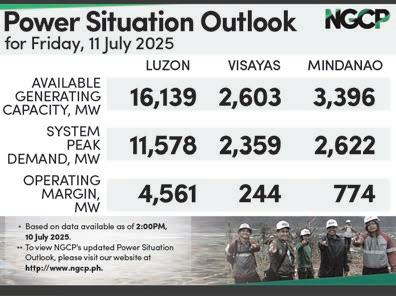
SM Offices trains sights on regional growth centers
SM Prime Holdings Inc., the property development arm of the Sy family, on Thursday said it launched The Core Tower Three, its 15th office development outside Metro Manila.
“The Core Towers reflects the growing demand for future-ready office spaces in regional growth centers like Sta. Rosa,” Alexis Ortiga, vice president and head of SM Offices, said.
“We are seeing sustained interest from companies looking for scalable locations that combine operational efficiency with strong local talent pools.”
Located within the SM City Sta. Rosa complex, the P1.6 billion three-tower development brings over 27,000 square meters of prime office space to the South Luzon market.
This brings SM Offices total leasable footprint to more than 1 million square meters, with over a fifth located across key regional growth corridors.
The Core Towers is positioned to serve a growing base of business process outsourcing, technology and professional services firms seeking high-quality workspaces in Calabarzon.
The office development offers
flexible fit-out options, 24/7 building management and high-speed telecom connectivity--key requirements for mission-critical operations. It was designed by Architect Albert Yu of ASYA Design Partner, a BCI Asia Top 10 architectural firm with a portfolio spanning major Philippine cities and key markets in China, including Shanghai, Chengdu and Suzhou. Each tower is equipped with 100 percent backup power, modern building systems and direct connectivity to major transport corridors including the South Luzon Expressway, Cavite-Laguna Expressway and the Old National Highway. Tenants also benefit from integrated access to retail, dining and public transit options within the mall complex. Leasing activity is underway, with several firms already in operation and early tenants citing location, workforce availability and infrastructure readiness as key drivers for expansion.
The Core Towers is expected to generate over 6,000 local jobs through tenant operations and building services, further contributing to Sta. Rosa’s emergence as a business and employment center, the company said. VG Cabuag

TBy Ada Pelonia
HE Philippine Chamber of Agriculture and Food Inc.
(PCAFI) is urging the government to transfer the Agriculture Guarantee Fund Pool (AGFP) to the Department of Agriculture (DA).
PCAFI President Danilo V. Fausto said the transfer of the pool, which is currently under the Department of Finance (DOF), would “provide easy access to cheap credit for our farmers.”
According to Fausto, such move would be similar to government’s decision to return the Philippine Crop Insurance Corp. to the DA from the DOF to make it more “agile” in responding to the needs of the farm sector.
Fausto said the Chamber believes the lack of credit access by farmers and fishermen hobbles any move to further improve the agriculture sector.
Through the AGFP, at least 85 percent of the unsecured loans extended by financial institutions to small farmer borrowers are covered by state guarantee.
This would provide confidence to financial institutions to lend to even the smallholder agricultural players, Fausto added.
The AGFP has a total fund of P10.7 billion at the end of 2021, according to a Commission on Audit report.
“This amount is enough to guarantee P32-billion worth of unsecured agricultural loans under BSP Circular 750,” Fausto said. “However, the loans guaranteed by the AGFP as of 2021 to farmers showed only P4.7 billion.”
Cash pooled into the AGFP comes from the penalties of banks under Republic Act 10000 (Agriculture and Fisheries Modernization Act of 1997), along with contributions of state-run firms and government financial institutions as stipulated under Administrative Order 225-A. Logistics project
THE PCAFI is also proposing a container logistics project that, the organization said, could solve the supply bottlenecks due to repair works on the San Juanico bridge. The project,
➔ Insurer bags two awards
the traders noted, must also provide long-term solutions to the “fragmented” supply chain in the island provinces.
According to the Chamber, the government should consider investing in the construction of container or reefer barge terminals in underutilized ports of key food-producing islands in the country.
This would ensure smooth flow of commodities and lower food prices between islands and in key metro areas of the Philippines, Fausto said. He noted that about 10 of the 15 biggest islands of the country have difficult access to modern container logistics. These islands are Samar, Palawan, Mindoro, Leyte, Bohol, Masbate, Catanduanes, Basilan, Marinduque, and Busuanga.
Fausto said using container barges or landing craft tanks (LCT) have made the establishment of container logistics more affordable and costefficient.
The government can pilot the project in Samar to address the current logistics crisis caused by the load limits of the San Juanico bridge, he said.
Furthermore, he noted that the underutilized San Isidro Ferry Port of the Philippine Ports Authority in Northern Samar serves as an ideal location for the project.
“The project will relieve pressure on roll-on, roll-off operations (roro) in the island province. The project will only cost a maximum of P100 million to reconfigure the port and equip it with a combination of forklifts and reach stackers that could move 20-foot containers to and from the LCTs,” Fausto said.
At a throughput of 100 twentyfoot equivalent units (TEUs) in and 100 TEUs out per day, the container logistics project will take out up to 200 truck movements per day from the congested Matnog and Amandayehan sea crossings, according to the PCAFI.
Earlier, a group of hog farmers said the repair and rehabilitation of San Juanico Bridge, as well as existing load restrictions, are disrupting the delivery of swine across regions and could put pressure on the retail prices of pork.
THE Manufacturers Life Insurance Co. (Phils.) Inc. , the local arm of international financial services provider Manulife, announced last it received two citations at the “Insurance Asia Awards 2025” held in Singapore. The insurer was given the “Mobile App of the Year” and the “Marketing Initiative of the Year” awards. “These recognitions underscore Manulife’s commitment to making decisions easier and lives better for its customers through digital innovation and authentic engagement,” read a statement issued by the insurer. Manulife’s self-service insurance mobile app, give customers the ability to manage and access their policies anytime, it added. According to the insurer, the app features biometric login via Touch or Face ID, push notifications for policy updates and promotions, online premium payments via major credit and debit cards, digital access to policy documents and statements, real-time fund valuation for Variable Unit-Linked policies, and contact information updates. VG Cabuag ➔ Pagcor donates emergency vehicles
THE Philippine Amusement and Gaming Corp. (Pagcor) announced it turned over emergency vehicles to the municipality of Benito Soliven in Isabela, San Pedro City in Laguna, the Polytechnic University of the Philippines, Ospital ng Parañaque and the Joint Task Force Unit Ilocos headquarters. Pagcor Chairman and CEO Alejandro H. Tengco was quoted in a statement as saying the donation aims to strengthen the medical and disaster-response capabilities of LGUs, public institutions and security forces. Since the program’s launch last February, the Pagcor has already donated 35 PTVs to LGUs, hospitals, and frontline agencies. One of the LGU recipients said the vehicle will significantly enhance the city’s emergency response, particularly for low-income communities. At PUP, where thousands of students attend daily classes, the donated vehicle is seen as an essential addition.
THE trust and investment arm of the Rizal Commercial Banking Corp. (RCBC) reported a double-digit increase in their assets under management (AUM) at the end of March this year. A statement issued by RCBC Trust Corp. read its AUMs reached P186 billion, representing a 14-percent year-on-year increase. This was “despite a quarter-on-quarter decline due to e-wallet outflows and a bearish equity market.”

By Cai U. Ordinario @caiordinario
THE World Bank Group is introducing new financing products that combine elements of project and policy loans for the Philippines, according to the chief of the Department of Economy, Planning and Development (DEPDev).
DepDev Secretary Arsenio M. Balisacan recently told reporters that this was the subject of a recent meeting with the Washington-based lender. He said the World Bank described these “hybrid loans” as “cheaper.”
Balisacan said World Bank executives also said that other countries are already using these new “products” to finance their project and policy needs.
“They say it’s cheaper. It has certain advantages that we needed to understand; and that’s why we had that meeting,” Balisacan said. However, in order for the country to take advantage of these hy-
brid financial products, the DepDev chief said the government needs to address differences in terms of approval process.
Balisacan said currently, two inter-agency committees under DepDev are approving these loans: the Investment Coordination Committee (ICC) for project loans and the Development Budget Coordination Committee (DBCC) for policy loans.
“Both [the] ADB (Asian Development Bank) and World Bank have been developing and marketing new products that fall in between these two and we don’t have an existing mechanism for reviewing that. We
ALAWMAKER has filed a resolution urging a congressional inquiry into the government’s failure to settle unpaid claims with several private hospitals—an issue that has compelled many facilities to suspend the acceptance of guarantee letters under the “Medical Assistance for Indigent and Financially Incapacitated Patients,” or Maifip,” program of the Department of Health.
House Resolution 46, filed by Mamamayang Liberal (ML) Partylist Rep. Leila M. de Lima comes in the wake of revelations from the Private Hospitals Association of the Philippines Inc. (PHAPI) that 43 hospitals in Batangas alone are owed more than P530 million. One hospital in the province awaits payment of as much as P94 million.
“This has been a perennial issue that should urgently be addressed once and for all. It burdens patients and their families with additional fear if they could get assistance from the government in medical expenses. Now, they also fear whether the government can help them with their medical bills,” said De Lima.
“We need to get to the bottom of this to protect the rights of patients and their families and ensure that the government fulfills its duty to pay its obligation to hospitals and clinics over unsettled bills,” she added.
De Lima stressed that the government must establish clear and efficient mechanisms for promptly settling hospital claims to prevent
RCBC Trust President and CEO Robert B. Ramos said the firm’s AUMs stood at P195 billion by December 2024.
“E-wallets are quite volatile. The funds come in and out often,” Ramos explained. E-wallets are accounts from electronic money issuers. For the whole year, the RCBC Trust said it is looking to grow its AUMs by 10 percent to 15 percent on the back of expansion efforts that are focused on high net-worth
individuals, institutional accounts, and services like estate planning and investment advisory.
RCBC Trust is pushing ahead with its digital transformation, making unit investment trust fund (UITF) usage easy and accessible through the RCBC Pulz app, with a continued thrust to drive a seamless unified experience for UITF and investment management onboarding.
“Clients want intuitive and seamless access,” Ramos said. “We
service disruptions. She warned that unresolved claims compromise the ability of hospitals to provide quality healthcare, leading some to stop honoring guarantee letters for indigent patients—or worse, shut down.
The resolution aims to determine the availability and effectiveness of existing government programs and funds in assisting financially incapacitated patients. It also seeks to clarify the rights of healthcare institutions in recovering unpaid claims and assess current government policies related to the reimbursement process.
De Lima also pointed to past instances involving the Philippine Health Insurance Corporation (PhilHealth), which reportedly failed to settle hospital claims despite having hundreds of billions in available funds—resulting in hospital closures and reduced services.
“These unpaid debts affect hospitals’ financial stability and operating expenses, including salaries for healthcare professionals and staff. It’s deeply concerning. How can we fully realize the goals of the Universal Health Care Law if this problem continues to persist?” she asked.
“Filipinos’ right to access urgent medical care should not be denied just because they cannot afford to pay hospital bills or because of the lack of trust of private hospitals that the government will pay them,” she added.
The 2025 National Budget allocates P41.15 billion for the Maifip program.
are creating a digital investment boutique, whether you want corporate bonds, government securities, or time deposits, it should all be in one space.” Meanwhile, RCBC Trust’s net earnings in the first three months of 2025 rose by 82-percent yearon-year, attributed to service upgrades, institutional mandates, and digital investment tools.
just clarified that; so that we can also respond appropriately in the executive branch,” the government’s chief economist explained.
“They are coming up with a way to handle that so that it will go through the usual rigor of approval and review and approval by the appropriate committees of government,” he added.
Loans are part of the country’s tools to finance development projects, particularly for big-ticket infrastructure projects.
Balisacan stressed that the aim of the government is to spend 5 percent to 6 percent of the country’s GDP on infrastructure. This is the ideal level that should be kept to attain the government’s development goals.
“The PPP [Public Private Partnership] is also picking up. And I think there are many projects that are lined up already between LGUs and private sector, national government and private sector. So there [are] a lot of things there,” he added.
Last month, the PPP Center said the national government now has over P2trillion worth of projects in the pipeline for partnership with the private sector. (See: https://businessmirror.com.ph/2025/06/24/ppp-pipeline-now-has-260-projects-worth-
%E2%82%B12-6-trillion/).
The PPP Center said that as of June 18, there are 230 projects in their pipeline amounting to P2.61 trillion. This is higher than the April 11 report that included 187 projects worth P2.64 trillion.
This means some 53 projects were added to the list, including 51 national projects and two local projects. A total of nine projects, however, were delisted including three national projects and six local projects.
In April, the Department of Budget and Management (DBM) said the government ramped up its infrastructure spending year-on-year in 2024, going beyond the full-year program.
The government’s infrastructure spending and other capital outlays amounted to P1.545 trillion from January to December 2024, an 8.9-percent increase from the P1.419 trillion spent in 2023.
This also exceeded the government’s infrastructure disbursement program of P1.473 trillion by 4.9 percent, based on the DBM data.
(See: https://businessmirror.com. ph/2025/04/04/infra-spend-for2024-exceeds-p1-5-trillion-or-89-more-dpwh-spending-cited/).
IFIRST heard the phrase “with a flourish” from my school superintendentuncle who wrote my high school valedictory speech at the request of my grandmother.
The phrase “with a flourish” means doing something in a dramatic, expressive, or enthusiastic manner; often with a touch of style or flair that leaves a lasting impression.
In the context of association leadership, “leading with flourish” is not about theatrics or superficiality. Rather, it is about infusing purpose-driven actions with creativity, energy, and humanity to inspire members, enhance engagement, and amplify the impact of the organization.
Associations are, at their core, communities of people united by shared goals, whether professional, civic, social, or cause-based. While strategic plans, governance models, and operational efficiency are critical, they are not enough to spark deep member loyalty or sustained momentum. That is where “leading with flourish” comes in. It’s the art of adding meaning, memory, and emotion to leadership practices in ways that uplift and motivate.
Consider the tone set by an association leader during a major event. Opening remarks could simply check the boxes or they could begin with a compelling story, a heartfelt reflection, or a well-crafted video montage celebrating members’ achievements. That flourish—an intentional and creative gesture—can transform a routine welcome into a moment of shared pride and inspiration.
Similarly, recognition and member appreciation are ripe opportunities for flourish. Rather than relying solely on plaques or certificates, association leaders can highlight personal stories, spotlight members in creative formats, or organize themed recognition events. These gestures may seem small, but they contribute significantly to a culture of value and belonging. They say, “We see you, and we appreciate you” in ways that resonate more deeply. Flourish also plays a role in communications. Whether in newsletters, social media posts, or annual reports, leaders can move
The RCBC unit said its revenues rose 24 percent, driven largely by rigorous investment management accounts (IMA) and retirement fund mandates. Return on equity improved to 54 percent, from 41 percent in the previous year, and operating profit margin climbed to 29 percent, up from 21 percent. Ramos said the performance surge was likewise attributed to improved client service, particularly in the


beyond basic updates and inject warmth, humor, visual storytelling, and member voices. These personal touches not only capture attention but also humanize the association’s work and reinforce its identity. Even in strategy and governance, flourish has a place. Facilitating board retreats with interactive methods, opening planning sessions with a visioning exercise, or ending meetings with gratitude rituals all bring color and vitality to otherwise procedural tasks. When done with intention, such flourishes make leadership more engaging and inclusive. More importantly, “leading with flourish” is not about extravagance or ego. It’s about authenticity, intentionality, and a willingness to elevate everyday moments into meaningful experiences. It means understanding the emotional currents that run through an association’s life and responding with imagination and empathy. In a time when digital overload, transactional interactions, and burnout challenge many associations, leaders who embrace flourish offer something refreshing: humanity with purpose. They remind members not just of what the association does but also why it matters. By leading with flourish, association executives and volunteer leaders don’t merely manage; they inspire. They create a sense of occasion, pride, and community. And in doing so, they position their associations not only to succeed but to thrive distinctively, memorably, and meaningfully.
Octavio Peralta is founder and volunteer CEO of the Philippine Council of Associations and Association Executives (PCAAE), the “association of associations.” The PCAAE will hold its 13th Annual Associations Summit on November 6, 2025 at the Clark Freeport Zone. The views he expressed herein do not necessarily reflect those of the BusinessMirror . E-mail: bobby@pcaae.org.

Eugenia Last


THE 150-strong Hotel Sales and Marketing Association (HSMA) recently held its third summit and one of the featured topics was on Empowering Sales and Marketing Teams into the Future
With guest panelists ranging from hotel general managers, sales and marketing executives, and even human resource experts, much was learned by summit participants, including me even if I’m not in the hospitality business. But as a journalist, I too am in the business of building relationships, with new sources, officials, the public, and readers, so I found the insights shared as helpful in my profession as well.
Pat Puyat, cluster general manager of Crowne Plaza Manila Galleria and Holiday Inn Manila Galleria, spoke on how the property has re-imagined its sales and marketing strategies in the face of changing guest expectations. “Each sales and marketing professional should be ambassadors....
There are a lot of vulnerable stories that are happening in your hotels, and clients should know about it. So for me, I always tell my team that storytelling is so important. Experiential marketing is what takes your beautiful properties to the next level. Remember, a room is a room, a ballroom is a ballroom, beautiful chandeliers are beautiful chandeliers, it can be copied, it can be duplicated, but the stories you see, as individual sales professionals, are your own. Make them unique, and that makes the difference between transactional and experiential [marketing].”
Still, AI is here and cannot be igonerd, so how is it changing the way hotels do their sales and marketing?
Conrad Manila general manager Fabio Berto cited a recent youth travel trend report which showed that 78 percent of this market want to be free to make their own plans. “So the whole game is around how you build on that ability, and provide that freedom to
the customers to plan the trip and organize the trip accordingly. So the integration of technology is key, I think, particularly for the sales and marketing force.”
In other words, according to moderator Agnes Pacis, HSMA director for education and vice president-commercial of the SM Hotels and Conventions Corp., AI can help a hotel “hypersonalize” guest experiences. “It gives us the data for us to be able to understand what type of guests we have, what type of experiences they actually want, and what type of packages we should put together or curate for them.”
Part of empowering sales and marketing teams is to hire the right talent. However, the hospitality industry is currently facing a manpower shortage as workers have either gone abroad, or have joined other industries during the pandemic. What can properties do to retain their good employees?
Wilma Estaura, director of human resources for Lanson Place Manila, said the days of dissatisfied general managers throwing reports (and staplers!) at their staff are now long gone. She continues to interview potential applicants face to face, and she has found that most of them, the Millennials and Gen-Z workers, are “very much into a purpose-driven organization. They would like to see wellness in terms of the priority of the organization. They would also like to ensure that they will join people who are true, authentic leaders.”
She added, “They know who you are, they know your vision, mission and values and philosophy in your respective organizations. Again, you can’t hide this. You can no longer be a dictator. You can no longer be autocratic. You should always ensure that you are participative. You should ensure that you are engaging and truly know, giving the authentic hospitality.”
In the case of her properties, Puyat said, for instance, they had celebrated “Service Week” by making available manicures and pedicures for the female staff, as well as haircuts and massages for the male employees, “just to thank them.” She had also proposed that June be called a Gratitude Month, “because I think a lot of leaders forget that just saying a simple ‘thank you’ means the world to any single person. Gratitude is a radical act.”
Being empathetic properties means work-fromhome (WFH) will not be returning anytime soon as was the practice during the pandemic. This will make the workplace unfair for its employees. Carmela Bocanegra, vice president for sales and marketing of Chroma Hospitality, said: “You can’t be working from

home, and then your property people, the service people are in their property, servicing the guests. So fair is fair. Being in the hospitality business, it’s really facing our guests.”
Beyond the revenue-driven key performance indicators (KPIs), what other metrics are being used by hotels today to measure sales and marketing performance? In the case of Holiday Inn and Crowne Plaza Manila Galleria, Puyat said they use direct bookings as a metric, as well. Trying not to offend the online travel agents (OTA) who were also present at the summit, she explained, “We just need to make sure that the ratio is acceptable [versus OTA bookings]. This goes to the bottomline of our owners.”
For Conrad Manila, customer satisfaction is also KPI, said Berto: “When we sell an event, there needs to be a seamless connection to the operations, because a happy customer will be another sale again, right?” The property also has post-event surveys to find out the customer’s experience.
Bayview Park Hotel general manager Eugene Yap advised the young summit participants, “While revenue generation is good, customer generation is as important.”
With sustainability and DEI (Diversity, Equity, Inclusion) being bandied about by many in the hospitality business, how do the individual properties actually ensure they accomplish this?
“The IHG [InterContinental Hotels Group] ‘Journey to Tomorrow’ is something that we’re very serious about, and this is a commitment that we have given the world because that is our job, to take care of the community in which we operate. So it’s very important now for us to be halal-certified, to be eco-friendly, [and] to ensure that we are sustainable. As much as we have DEI for our colleagues, we also have DEI for guests. So we should operate an inclusive hospitality business.”
If there is any one thing that properties learned uring the pandemic, it is to listen to their sales and marketing staff, as in the case of Bayview’s Yap. “I wanted to close the hotel. Everyone was afraid of Covid, but, you know, my sales and marketing [staff] came to me, and they said, ‘We can be a quarantine hotel.’ So we opened, and generated revenues that we were able to generate revenues to fix, improve the hotel.”
As Pacis placed it succintly, “Have more faith in your sales and marketing teams.”
Congratulations to the HSMA for another successful summit!
VIRGO (Aug. 23-Sept. 22): Listen carefully. Refuse to let changes others make tempt you to follow. Gather information, watch their progress and learn from their pitfalls and failures. Attend functions that connect you to people who can offer insight into something you want to pursue. ★★★★★
LIBRA (Sept. 23-Oct. 22): Emotional energy will require direction. Motivate yourself to tidy up or move things around at home to encourage a healthier routine and schedule. Keeping your eye on expenditures and essentials will help you make better choices. Too much of anything will require adjustments. ★★
SCORPIO (Oct. 23-Nov. 21): Conversations that bring about change may not be easy, but the results will enhance your life. Line up your preferences and set a course that can carry you to victory. Attend events that allow you to converse with people with experience, and you’ll find shortcuts that help you reach your goals.
SAGITTARIUS (Nov. 22-Dec. 21): If you move too quickly, you’ll face unexpected pitfalls that delay your timing. A positive attitude will draw attention. Be careful not to let anyone take advantage of your willingness to please. Tuck your money in a safe place and refuse to pay for someone else’s mistakes. ★★★★
CAPRICORN (Dec. 22-Jan. 19): Question everything when money and work are the topics of your conversation. It’s essential to know your worth and to market yourself accordingly. Reset your plans, review your investments and


‘
HOW would you begin discussing this film in class?” It was Jason Tan Liwag with his opening salvo of a question for our session that was technically closing the two-day conference billed as “Training the Teachers.”
The question was terse and simple. Just the kind of erudition that opened a whole vista of perspectives and into that dense universe of theoretical underpinnings.
It was a good beginning and from there, the afternoon brought the two of us—Patrick Campos and I—with Jason (despite and because he was moderating) to the classroom.
It was our assumption that the participants, all classroom teachers, would listen and find our experiences not only familiar but resonating as well with their own past and present intellectual engagement with films.
For our session, there was an assignment and that was to view Justine Triet’s Anatomy of a Fall. The film had received many awards, foremost among these was the 2023 Palme D’Or from the 76th Cannes Film Festival. It also received from the Academy several nominations, namely, Best Picture, Best Director, Best Actress and Best Screenplay. It would win for the last category (written by Triet and Arthur Harari) although Sandra Huller’s performance had been acclaimed in other festivals.
The subject film was what you may call “loaded.” It came with its own biography and social geography. Its reputation preceded itself.
For that session, something was greater than the analysis of the film. There was the population of viewers (or students, as the exercise purported to be). In fact, as the discussion progressed, we realized how it was not easy using films as artefacts. There was the question of classification and with it came the issue of ethics and social responsibility.
What can I show to my class? What can I not show in class?
For Patrick, he mentioned two considerations: the interiority of film and its exteriority. If I may, he was pointing to the immediate objective meaning of a film—what are its contents and how a film scholar can break them down and raise their meanings for everyone to appraise. It’s an almost artificial and self-conscious process, mostly heuristic. And there are the external elements: What is this film in the social nexus of our surroundings? What can this film offer us by way of crystallizing truths that may not even be there onscreen that is “white,” “female” and “European.”
Going back to the film, what is it all about?
It’s a story of a woman living with her husband in a snowbound mountain chalet somewhere in southeastern France. One senses a cold isolation all over the place. The scene opens with a young girl interviewing a writer (Sandra) when from somewhere (the two characters respond to the diegetic percussive

sound) a music ensues. It seems to keep getting louder till the music suffuses the two characters. The older woman, Sandra, opts to reset the interview as the noise could not make any conversation possible.
The next scene unfolds so quickly, with the husband figuring in an accident. He falls off the high window and dies. The wife becomes the main suspect.
The son who is visually impaired is a witness.
A new character enters the frame. He is the friend who will stand as her lawyer. Does he like her?
Immaterial perhaps but it makes you think. What begins as an isolation turns into a reconnection as Sandra is seen as one who could not speak French properly.
Language turns into a core element of the narrative: Sandra is German who relocates to France in order to support the dreams (and plans) of her husband. Both are writers but, for some reason, the
wife gets to write more while her man whines about being lost. He even accuses his wife of stealing his ideas even as the wife talks of being inspired by certain ideas of her husband. To create balance, the wife uses English as the language for mediation, but this is seen by the husband as her way of creating a neutral and non-committal way of maintaining relationships. With the way their marriage is beginning to crumble, the question has turned to the wife as the murderer of her own husband.
As it turns out, the film is not necessarily a whodunit.
In my case, to the question of Jason, I confessed one of the most immediate acts that drove me toward film analysis—my irritation at one primal scene. Whether this was part of a personal quirk, it was the best answer for the moment. How do I begin to talk about a film? In the case of Anatomy of a Fall, I shared
the annoying situation created by the music. From that moment on, I sensed the narrative as a series of stops and starts, of jolts and pauses that did not make sense but rather interrupted the story. For each rupture (a disturbing glance, a long withered look, and tentative gestures), we the viewers are urged to interpret, to find significance in gestures and nuanced movements.
This makes cinema terrifically gripping: There is a world or worlds beyond the so-called film language. No one can ever stop the film student from talking outside the screen.
The Training the Teachers conference was organized on July 4 and 5, 2025, by the Academic Film Society of the Film Development Council of the Philippines (FDCP) in partnership with the Philippine Association of Communication Educators (PACE), in
By Patrick Villanueva
CELEBRATING 11 years in the music industry, Star Music artist Darren Espanto finally released his latest album, titled Ikaw Pa Rin. With fans flocking during his announcement, Darren set foot onstage and performed a few songs from the album, which the audience relentlessly cheered.
The LP consists of 13 tracks, five of which were penned by Darren himself. These titles include “Bibitaw Na,” “Hanggang Kailan,” “Ilang Beses,” “Iyo” and “Paano Kung Tayo na Lang?,” which he co-wrote with Angela Ken. In the title track “Ikaw Pa Rin,” Darren collaborated with DJ M.O.D. to create
KARA PATRIA CONSTANTINO DAVID, whose name means “Beloved Homeland,” has devoted the past three decades of her career to unearthing and telling powerful stories across the Philippines.
On July 8, 2025, in celebration of her 30th year in the industry, Kara renewed her ties with GMA Network. The ceremonial contract-signing gathered network executives, colleagues, and individuals whose lives Kara has touched through her work.
In attendance were GMA president and CEO Gilberto R. Duavit Jr., GMA executive vice president and chief financial officer Felipe S. Yalong, and senior vice president for Public Affairs and executive vice president for GMA Pictures Nessa Valdellon.
In his video message, GMA Network chairman Atty. Felipe L. Gozon congratulated Kara on her 30 years of being with the network.
“Ang mga istoryang inihahatid mo, lalo na sa iyong mga dokumentaryo, ay tumatatak sa puso at isip ng mga Pilipino. Masaya kami na patuloy kang magiging bahagi ng GMA Network at GMA Public Affairs. Ang ibig sabihin nito ay marami ka pang award-winning na kuwentong
a unique yet complementing blend of the two performer’s different style. The album also featured PBB: Celebrity Collab Edition eviction theme song “Paalam Muna Sandali,” which he joked that he went straight to recording after a flight because he thought his best friend AC Bonifacio will be the first one to get evicted. Minadali ko po talagang ni-record kasi sabi ko ‘ay parang siya talaga,’” he joked. Still, he was amazed by how positive the reaction was for this song from the public.
“Hindi po namin in-expect na magiging ganun ‘yung reception ng tao sa Paalam Muna Sandali,” he claimed. During his album launch, the music video for “ANNAB” was also revealed, featuring Ashley Del Mundo. It is now out on the ABS-CBN Star

maihahatid at magmumulat sa kamalayan at makapagpapabuti ng buhay ng ating mga manonood. Maraming salamat sa iyong malasakit at dedikasyon,” said Gozon. Duavit, likewise, lauded Kara’s contribution to GMA Network.
“The contribution of Kara cannot be measured. She has worked before behind the camera. Lahat ng kontribusyon niya sa mga programa, sa mga isip at diwa ng ating
manonood at ating mga Kapuso, hindi natin masusukat. We are privileged, honored, happy, na si Kara ay isang Kapuso at mananatili pang Kapuso,” said Duavit. “Kara, thank you very much for your continued trust and support and for being Kara David. You are a credit to all of us. Ginagalang at minamahal ka naming lahat,” he added.
Yalong also thanked Kara’s dedication
Music’s YouTube page. Also included in the album is a reimagined version of the classic song “Dati,” with Darren performing it with Belle Mariano.
Completing the album are “Di Makaramdam,” “Miss,” “Duyan” and the Chinese-Tagalog version of “Iyo.”
When asked to whom this album is dedicated, with each song tackling different themes of love and heartbreak, he mentioned that this is for Darrenatics, especially those who have been supporting him throughout his career.
You can stream the whole track on several music streaming platforms, with a physical album copy bound for release soon.

to her craft: “Salamat that you continue to be with us. And I hope that you will come up with more documentaries that are very meaningful and very timely for the situation that we have right now.”
Overflowing with gratitude, Kara shared how she looks forward to continuing her meaningful journey with GMA.
“Thank you, GMA, for giving me a chance. I will be forever grateful to you for taking a chance on me when nobody else wanted to. Thank you for giving me this platform. Thank you for allowing me to tell stories and for allowing me to use these stories to help more people in the Philippines. ‘Yun naman yung tatak ng Serbisyong Totoo—ginagawa natin ang istoryang ito hindi para sa sarili pero para sa mas marami. At iyon ang itinuro sa akin ng GMA,” said David. Also celebrating Kara’s milestone were Public Affairs vice president Arlene Carnay, assistant vice presidents Jonathan Tam and Joy Madrigal, senior program managers Sherilyn Bruan and Joseph Conrad Rubio, and program manager Maharlika Corullo. Present as well was assistant vice president for corporate communications Jojo Aquio.
Kara’s television career began with on-the-job training on Super Show before officially joining GMA in 1995 as a production assistant. She quickly transitioned into writing roles for Brigada Siete and Emergency, and later became a reporter for Brigada Siete and i-Witness. Her extensive career includes anchoring News to Go and hosting Power House, Brigada, Case Unclosed, OFW Diaries, and Pinas Sarap. She remains one of the pioneering hosts of i-Witness, which celebrated its 25th year in 2024. During the contract renewal, GMA Public Affairs honored Kara with a surprise tribute: a live storybook presentation chronicling her journey and the many lives she has touched on and off camera.
The signing event also marked the official launch of Kara’s newest project— GMA Public Affairs’ latest podcast I-Listen. Featuring heartfelt conversations that truly resonate with listeners, each episode tells the unique stories of Filipinos, showcasing raw, relatable experiences that will touch your heart and spark meaningful reflection. It will soon be available on GMA Public Affairs’ social media platforms, Spotify, and Apple Podcasts.
Pepsi-Cola Products Philippines, Inc. (PCPPI) marked a year of growth and progress in 2024, fueled by a bold transformation roadmap and an unwavering commitment to agility, innovation, and sustainability.
During its recently concluded 2024 Annual Stockholders’ Meeting, presided by Chairman Oscar M. Reyes, PCPPI President and CEO Phyo Phyu Noe highlighted the company’s strong performance amid a dynamic business environment. “The wins of 2024 are proof that the spirit of transformation is alive and well at PCPPI. We have moved from laying the groundwork to strengthening our foundations: transforming not only how we operate but how we lead, decide, and grow,” she said. Throughout the year, PCPPI continued to grow its footprint across key channels and sectors. The company welcomed Timezone as its newest partner, serving as the exclusive beverage provider. It also renewed its long-standing partnership with Max’s Group Inc., a relationship that spans over two decades.
Expanding further into the casual and fast-dining segments, PCPPI forged partnerships with a diverse range of restaurant brands, including Ramen Kuroda, Samgyupsalamat, Frankie’s NY

Buffalo Wings, Yoshimeatsu, and Wallace Chicken.
PCPPI also broadened its Alcohol Beverage portfolio with the launch of new offerings such as Saero soju, Starlight Chungha, Rose Chungha, and Hard Mountain Dew, demonstrating its commitment to innovation and evolving consumer preferences.
Underscoring its dedication to Environmental, Social, and Governance (ESG) goals, the company made continued progress on its sustainability initiatives. These efforts reflect a deeper integration of responsible business practices within its day-to-day operations. Its sustainability commitments
yielded measurable results, including: 13,000 metric tons of post-consumer plastic collected under the EPR law; Reduction of 237 million liters in water usage; and a 44% drop in inventory losses due to smarter supply planning.
As PCPPI enters the next phase of its transformation journey in 2025, the company is poised to scale its progress, further embedding a culture of innovation, performance, and accountability. “This transformation is no longer just a program. It is a movement within PCPPI. We are building a future-ready organization, powered by courageous people and world-class systems,” Phyo affirmed.
Sun Life Philippines champions Filipinos’ active lifestyle with expanded Hoops + Health program

+ Health Program handover ceremony at Taguig Integrated School.
LEADING international financial services organization Sun Life Philippines recently announced the expansion of its Hoops + Health program, a community initiative focused on promoting healthy living among the Filipino youth.
With the positive outcome of the program last year and in celebration of its 130th anniversary in the country, Sun Life reinforced its commitment to fostering healthier lifestyles among Filipinos, particularly the youth, by donating basketball equipment and gear to 130 schools across Metro Manila.
“We are thrilled to continue the Hoops + Health program as this embodies our mission to be a partner in the Filipinos’ journey towards a healthier life,” said Carla Gonzales-Chong, Chief Client Experience and Marketing Officer of Sun Life Philippines. Rooted on the immense popularity of basketball in the
country, Sun Life began to bring their advocacy to life by targeting the schools.
In collaboration with global sport-for-social-change organization Beyond Sport, Hoops + Health Program aims to contribute to the development of the sport and its potential to encourage physical activities by providing schools with necessary tools to further engage the students to be more active.
“Last year, we saw firsthand the enthusiasm and positive impact this initiative had on young people,” Gonzales-Chong mentioned. “By equipping more schools with quality basketball gear, we aim to inspire even more youth to embrace an active lifestyle, learn valuable life skills through sports, and build a healthier future for themselves.”
This year, the program is further expanding its
reach and impact to encourage young people to adopt an active lifestyle by partnering with organizations like Gawad Kalinga and Tigers Basketball to offer extensive free weekly basketball sessions. These sessions are designed for 120 youth between the ages of seven and 16, providing them with over 200 hours of training across six months.
The program’s delivery points have also grown considerably from just Laguna in 2024 to Laguna, GK Sanrose, Kapitolyo, Pasig City, and Mandaluyong City this 2025. Furthermore, the initiative recently hosted virtual workshops for 51 Filipino basketball coaches, equipping them to educate an estimated 3,460 young people on important health and wellness topics.
As part of the Hoop + Health initiative, Sun Life officially conducted a handover ceremony of basketball equipment to Taguig Integrated School last June 17. Known basketball players like Ella Fajardo, JD Cagulangan, and Ice Danting together with Basketball Skills Trainer Nicolo Chua were present during the event to provide a training session among the students of the school.
“I think it’s incredible [to have initiatives like this] because since its grassroots, it means a lot. It plants the seeds in these young women and men that there are people who cared for them,” Fajardo mentioned, highlighting the importance of investing in the young talents of Filipinos. “Programs like this give them a chance, a voice, an opportunity to learn outside of the classroom.”
To ensure widespread participation, each participating school will receive a donation package which includes essential basketball equipment such as basketballs, hoops, nets, and various other training tools—guaranteeing that communities have the necessary resources to actively engage in sports. VPR
Abaca Tea Co. Debuts Premium Teas at All Abaca Baking Company Stores

ABACA Baking Company (ABC) in Cebu City is delighted to welcome back a guest favorite: Abaca Tea Co.(ATC), which returned to all ABC cafés for dine-in service starting June 16.
Curated for both tea lovers and the tea-curious, this collection showcases an array of thoughtfully sourced teas and botanicals. Each one is selected for its clean flavor, consistency, and character. Whether you’re easing into your morning or winding down in the afternoon, there’s a blend to suit every moment.
Guests can choose from a range of caffeine-free infusions, perfect for any time of day: Hibiscus – Bright, tart, and naturally uplifting
Chamomile – Gentle and soothing, ideal for calm moments
Peppermint – Cool and refreshing with a crisp finish
For those looking for a gentle lift, the selection of caffeinated teas include: English Breakfast – Bold, balanced, and familiar Sweet Peach & Citrus – Fruity and fragrant, with a hint of zest Organic Sencha – Lightly grassy, smooth, and restorative Have your tea moment for a pause, a comfort, and a small joy, served with the same warmth and attention to detail that define every Abaca

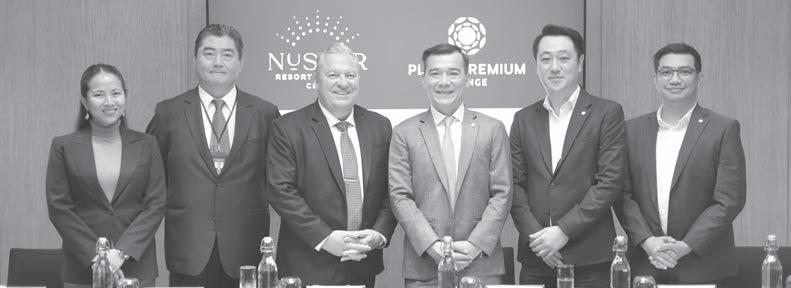
NUSTAR Resort & Casino Cebu has officially entered a strategic partnership with Plaza Premium Group (PPG), the global leader in integrated,
airport hospitality experiences and passenger service solutions, to provide exclusive travel privileges for NUSTAR Rewards members and VIP guests.
NUSTAR Rewards is the official loyalty program of NUSTAR, offering free membership with tiered benefits, allowing members to earn and redeem points on gaming, dining, retail,
by NUSTAR executives,
AS a gesture of appreciation for outstanding contributions to the company, Foundever® in the Philippines has awarded its top 2024 referrer a brand-new Suzuki Jimny through its employee referral program (ERP).
This year, Elynn, a coach from Foundever, received recognition and compensation for her exceptional contribution in referring new talent to the company. Foundever has been upholding its tradition of rewarding top-performing employees through its ERP. For 2025, the company is raising the stakes, with the top referrer set to receive P1 million in cash, along with additional rewards, including brand-new gadgets and a brand-new motorcycle.
“At Foundever, we are committed to fostering talent and offering genuine opportunities for growth. Our initiatives embody our mission to enhance employee engagement and contribute to a more diverse and culturally aligned workforce,” said Lena Madrid, Senior Marketing Manager at Foundever in the Philippines.
A global leader in the customer experience (CX) industry, Foundever continues to invest in its talent development through its ERP. By rewarding employees who bring in new talent, the company empowers its workforce to act as brand ambassadors. This approach has positively impacted the organization by improving retention rates, boosting employee engagement, expanding the diversity of the talent pool, and enhancing cultural fit within teams.

Foundever
and

www.businessmirror.com.ph • Editor: Tet Andolong
Story & photos by Randy S. Peregrino
BYD Cars Philippines, a subsidiary of ACMobility, recently brought in a new addition to its growing PHEV lineup—the Sealion 5 DM-i. BYD claims this bold subcompact SUV is poised to redefine entry-level mobility by combining cutting-edge electrified technology with practical design and affordability.
“The BYD Sealion 5 DM-i delivers exceptional value—combining advanced technology, everyday functionality, and a size advantage that’s perfect for first-time buyers,” said Bob Palanca, Managing Director of BYD Cars Philippines.
“Powered by BYD’s proven Super DM-i technology, the Sealion 5 offers more of what matters to cost-conscious and practical car owners - a reliable and sustainable long-range driving companion. As more Filipinos adopt electrified mobility, the Sealion 5 DM-i will serve as the gateway to BYD and ACMobility’s vision of a greener Philippines,” he added.
BYD DNA
EXTERIOR-WISE , the silhouette, with its clean lines, is indicative of its EV sibling, the Atto 3. The fascia features a pronounced grille with a familiar horizontal bar with sleek-looking full LED lighting. Other design features include heated and power-adjustable mirrors, integrated puddle lamps, stylish roof rails, and 18inch alloy wheels. Dimensionwise, the vehicle measures 4,738 mm in length, 1,860 mm in width, and 1,710 mm in height. Inside, premium, soft-to-touch materials are combined with intuitive design elements. Highlighted in the center dash is BYD’s signature 10.1-inch rotating touchscreen, featuring wireless Apple CarPlay and Android Auto, to ensure comfort and connectivity. The seats are leather-wrapped, and the vehicle features dualzone climate control. Moreover, a host of new and fun applications, such as Stingray Karaoke, a web browser, popular music stream -

ing services, navigation apps, and more, are downloadable from the embedded BYD Store in the infotainment system. Other standard features include NFC card smart entry, pushstart ignition, multiple USB ports, and BYD Cloud Service, which offers over-the-air updates, to round out a tech-forward interior.
Of course, there is the BYD App, a mobile phone interface allowing remote control of the vehicle’s security and comfort.
Super DM-I technology MOTIVATION comes from the brand’s advanced Super DM-i system. This electric-first powertrain

seamlessly combines electrified propulsion with a high-efficiency generator, enabling long-distance driving. With a combined output of 194 hp and 300 N-m of torque, it takes only 8.3 seconds to reach a speed of 100 km/h. Selectable drive modes available are Economy, Normal, and Sport. Electric juice is provided by a 12.96-kWh ultra-safe Lithium Iron Phosphate Blade Battery rated for up to 71 km of pure electric driving range, based on the New European Driving Cycle (NEDC) standard. The total range is over 1,000 kilometers.
Plugged in, the BYD DM-i system supports up to 3.3 kW of AC charging, allowing the Blade Battery to reach a full charge from 15 percent in approximately 4.5 hours.
For added versatility, Vehicle-toLoad (V2L) functionality enables the Sealion 5 DM-i to power external devices and appliances, making it ideal for outdoor and on-the-go use, as well as for emergencies when electricity is needed.
Proven efficiency
IN a recent efficiency run supervised by the Automobile Association Philippines, expert drivers George and Louis Ramirez drove the BYD Sealion 5 DM-i around the famed Luzon Loop with a full charge of the BYD Blade Battery and a full tank of fuel.
Reaching as far north as Pagudpud, Ilocos Norte, and past the South Luzon Expressway and CAVITEX on their way back to Manila, the Sealion 5 DM-i managed to complete a total distance of 1,409.7 km over three days of driving. Driving along urban, highway, mountain, and countryside roads,
the efficiency run achieved a result of 25.273 km/liter, surpassing the estimated range.
Safety and convenience
THE Sealion 5 DM-i is equipped with a comprehensive suite of features, including cruise control, a rear camera with radar sensors, Electronic Stability Control, and Traction Control, providing added grip and stability. Moreover, the vehicle features Hill Hold and Hill Descent Control, as well as a Tire Pressure Monitoring System (TPMS). Other standard features include six airbags, ISOFIX child seat anchors, and advanced safety technologies, such as ABS, EBD, and anti-rollover protection.
Pricing, warranty, and color options
THE BYD Sealion 5 DM-i retails at P1.248 million. Customers may also avail themselves of the lowdown payment of P88,000. For cash buyers, the price even lowers to P1.198 million. Available colors are Arctic White, Harbour Grey,
Cosmos Black, and Deep Sea Blue. Each color option is paired with a luxurious two-tone interior featuring beige and brown accents. Moreover, BYD’s comprehensive warranty coverage, which includes 8 years or 160,000 kilometers for the Blade Battery, 8 years or 150,000 kilometers for the electric motor and control systems, and 6 years or 150,000 kilometers for the new vehicle warranty, offers long-term confidence and peace of mind for every owner.
“The Sealion 5 DM-i is yet another proof of how easy and convenient it is to switch to electrified mobility with BYD. With the strength of BYD Super DM-i technology and our growing lineup of electric vehicles, we continue to offer Filipinos a worry-free electric mobility experience for their every need,” said Adam Hu, BYD Philippines Country Head. “And as we expand the BYD lineup, we remain focused on giving Filipinos more choices to go electric and more compelling reasons to make the switch,” he concluded.
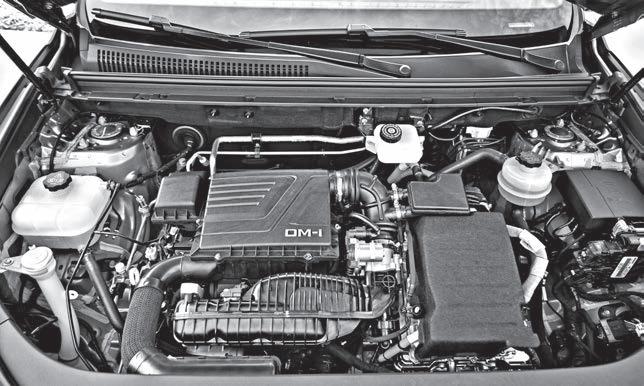

MITSUBISHI Motors Philippines Corp. (MMPC) has launched its firstever Prepaid Maintenance Parts Package (PMP Package), for hassle-free car care today and for a worry-free drive tomorrow.
Here is Nelda Castro:
“As part of its Mitsubishi Motors Cares Program, the PMP Package is introduced to give Mitsubishi vehicle owners enhanced peace of mind, value and convenience by allowing them to pay for their vehicle’s maintenance and other aftersales needs in advance at a
discounted price.
“This initiative further proves MMPC’s dedication to delivering high-quality and thoughtful aftersales solutions, while supporting customers in effectively managing their maintenance expenses.
“Customers buying Mitsubishi vehicles starting July 1, 2025, may also avail of the PMP Package during the point of sale.
“Alternately, customers may also purchase the PMP Package during their vehicle’s first periodic maintenance service up to the next 10,000 Km PMS. Beyond the discount, customers get to also enjoy the following benefits:
n Price Protect Advantage –Shields customers from future increases in parts prices and service costs.
n Uphold Resale Value –Ensures a complete maintenance record of the vehicle
contributing to better resale value over time.
“With customer convenience in mind, the PMP Package together with the Mitsubishi Motors 360 Connect App, offers hassle-free maintenance since parts are prepared and made ready in advance for every scheduled servicing. It ensures access to Mitsubishi Motors Genuine Parts, guaranteeing original, high-quality parts for the vehicle’s optimal performance and safety. Customers may conveniently claim their PMP Packages in any authorized Mitsubishi Motors service centers nationwide.
“To know more about the program, visit www.mitsubishi-motors. com.ph or contact your nearest dealership.”
Isuzu Valenzuela ISUZU Philippines Corp. (IPC), together with long-time dealer
partner Industrial and Transport Equipment, Inc. (INTECO), has unveiled its newest dealership in Valenzuela City, aiming to accommodate growing demands in the NCR market.
The occasion was graced by Valenzuela Mayor Wesley Gatchalian, IPC Executive Vice President Yasuhiko Oyama, and INTECO President Raymond Jarina, marking a milestone in Isuzu’s ‘Road to 50’ program, an initiative to expand the brand’s reach across the country.
“Strategically located here in the ‘Northern Gateway’ of Metro Manila, Isuzu Valenzuela is set to play a key role in expanding our reach and serving more customers in this vibrant part of NCR,” said Oyama. “Isuzu Valenzuela aims to deliver seamless and elevated customer experience from our Sales to Aftersales operations –from its spacious showroom and customer lounge to our well-lit
and well-ventilated service shop, this new dealership design has our customers on top of our mind.”
Located along MacArthur Highway, the 1,955-sq.m dealership includes a 140-sq.m showroom that can display up to three light commercial vehicles and one commercial vehicle. The 950-square-meter service area features nine service bays—four for light commercial vehicles and five for trucks— serving both individual and fleet customers.
The new Valenzuela branch marks INTECO Group’s seventh dealership nationwide, reflecting its long-standing commitment to quality service since introducing Isuzu to the country in the 1960s via its EDSA branch.
“We are thankful to the unwavering support of customers who trusted Isuzu and INTECO for decades,” said Jarina. “With this new Valenzuela location, we are excited to showcase to the
Valenzuela market why INTECO is ‘The Dealer That Knows Isuzu Best’ and continue to deliver outstanding customer service to our growing network.”
In addition to this grand opening, INTECO has also modernized its existing dealerships nationwide, namely those in Quezon Avenue, Pampanga, Dagupan, Urdaneta, Baguio and the EDSA Balintawak. Through these efforts, Isuzu and INTECO continuously showcase their commitment to optimizing customer experience, delivering the Isuzu Advantage of excellent aftersales to the Valenzuela market and beyond.
PEE STOP Happy birthday to the three great women playing crucial roles for the longest time in the life of Valentin
LONDON—At least Novak
Djokovic could laugh about it immediately afterward.
Yes, he took what he called a “nasty” and “awkward” fall on his second match point at Wimbledon on Wednesday.
Yes, he slid into the splits and ended up face-down on the Centre Court grass.
A nd, yes, those sorts of things aren’t ideal for a 38-year-old seeking an unprecedented 25th Grand Slam title.
S till, Djokovic dusted himself off and took the next two points, reaching the semifinals at the All England Club for a men’s-record 14th time with a 6-7 (6), 6-2, 7-5, 6-4 victory over No. 22 seed Flavio Cobolli to set up a showdown against No. 1 Jannik Sinner
“Obviously, [my] body is not the same today like it was before,” Djokovic said at his news conference, “so I guess the real impact or effect of what happened, I will feel tomorrow. So let’s see. I’m hoping in the next 24, 48 hours, that the severity of...what happened is not too bad, that I’ll be able to play at my best and free of pain in two days.”
That’s when he will take on threetime major champion Sinner, who didn’t play like someone dealing with an injured right elbow while using terrific serving and his usual booming forehand to beat 10th-seeded Ben Shelton, 7-6 (2), 6-4, 6-4.
“It’s going to take the best of me at the moment to beat Jannik. I mean, I know that,” said Djokovic, who has lost his last four meetings with Sinner, including in the French Open semifinals last month.
Djokovic is 2-0 against Sinner at Wimbledon, eliminating him in the 2023 semifinals and 2022 quarterfinals.
Against Cobolli—like Sinner, a 23-year-old from Italy—the latematch tumble was not the only thing that was far from smooth for Djokovic. He served for the opening set at 5-3 but got broken at love. He later was a point from owning that set before first-time major quarterfinalist Cobolli came through. Djokovic did stretches and breathing exercises at changeovers. He whacked his shoe with his racket after one miss in the fourth set. He seemed bothered at times by the bright sun above Centre Court.
H e also showed off all of his considerable skills, accumulating 13 aces, holding in 19 of 21 service games, using a drop-shot-lobdrop-shot combination to take one point and limiting his unforced errors to 22—
Chalf as many as Cobolli.
On Friday, Djokovic will try to reach his seventh consecutive final at the All England Club and get closer to equaling Roger Federer’s men’s mark of eight trophies there. The other men’s semifinal is two-time defending champion Carlos Alcaraz, who defeated Djokovic in the 2023 and 2024 finals, against Taylor Fritz.
The women’s semifinals Thursday are Aryna Sabalenka against Amanda Anisimova and Iga Swiatek against Belinda Bencic.
Against Shelton at No. 1 Court, Sinner wore a white sleeve on his right arm with strips of tape visible underneath—one above the elbow, one below it—after he was hurt when he fell in the opening game of his fourth-round match against Grigor Dimitrov on Monday. AP

By Aldrin Quinto
ITY of Candon—Volleyball fans here got treated to some of the other offensive schemes Alas Pilipinas has been testing in training camps with Eco Adajar running the plays with skill and intuition and Leo Ordiales dominating with brute force.
A tan dem during training, Adajar and Ordiales got to showcase their strengths for a full match instead of the cameos in recent outings as the Philippines showcased its well-stocked lineup ahead of the FIVB Volleyball Men’s World Championship this September.
With the duo taking charge, Alas Pilipinas notched a 25-17, 25-23, 25-19 victory against Vietnam in the Southeast Asian V.League on Wednesday at the Candon City Arena on Wednesday night.
He needed no pep talk, Adajar said, when coaches informed him that he was getting the start and likely the full match.
We’ve been training hard for these situations. No nerves, I was ready. We’re all always ready,” Adajar said.
The Philippines had to reveal its other aces when Joshua Retamar fell ill just hours before the match, which looked to be a huge blow to a team that was already missing Marck Espejo due to an ankle injury and Louie Ramirez, another reliable hitter, had to skip the opening match to attend to his graduation ceremony at the University of Perpetual Help. R amirez, a former National Collegiate Athletic Association Most Valuable Player, was back for Thursday’s match against Thailand. Retamar attended practice Thursday noon but team officials decided to hold him out as Alas Pilipinas battled the double gold medalists.
“I t’s the same game plan, whoever is called,” Adajar said. “There was not
much adjustment for us, especially since I have been working closely with Leo in training.”
“I also keep in mind that the reason coaches call your number is that they expect you to deliver,” he said. “And we are always prepared to deliver, not just me, it’s the whole squad.”
The Philippines is looking to move up the podium after earning two bronze medals last season, while going for earn ranking points as part of the preparations for the FIVB Volleyball Men’s World Championship Philippines 2025 with tickets available via the official website https://www. philippineswch2025.com/.
The 23-year-old Adajar played the full three sets with hardly any relief—his longest outing with the Philippine team.
A perfectly-timed substitution in the third period saw opposite hitter Steve Rotter come up with a couple of big hits for Alas Pilipinas in the brief moment Adajar had to sit for a few instructions from Argentine assistant coach Alejandro Andres Aldana. Nguyen Ngoc Thuan led Vietnam with 13 points, while Van Hiep Pham and Tran Duy Tuyen scored seven each. Vietnam bounced back on Thursday with a 25-23, 25-20, 25-21 victory over Cambodia in the tournament backed by PNVF official partners PLDT, Mwell, Meralco, Rebisco, Akari and Nuvali, PNVF official suppliers Asics, Senoh and Mikasa, official television partner Cignal, and supported by the Philippine Sports Commission, Philippine Olympic Committee and the City of Candon.
Vietnam had 11 blocks against only five by Cambodia in the one-hour and 27-minute match.
After taking on Thailand, the Philippines takes a break on Friday before facing Cambodia on Saturday and Indonesia on Sunday.









Evenepoel displays what he does best in Tour’s time trial 5th stage
CAEN, France—Race-againstthe-clock specialist Remco
Evenepoel produced a stunning display of power to win the first time trial of the Tour de France on Wednesday and defending champion Tadej Pogačar cemented his favorite status by grabbing the yellow jersey.
Evenepoel, the reigning Olympic and world champion in the event, was expected to win the stage in the absence of time trial specialists—Filippo Ganna and Stefan Bissegger, who both crashed and exited the race on the first day of the Tour last week.
The mainly flat 33-kilometer Stage 5 in Normandy favored powerful riders like Evenepoel, who already had won a time trial in a similar fashion last year, when the Belgian rider finished third overall in the general classification.
Evenepoel, who has fully recovered from multiple injuries sustained in a big crash last year, was 16 seconds faster than Pogačar. Edoardo Affini, the European time trial champion, was third, 33 seconds off the pace.
Tucked on his bike in a perfect aerodynamic position, Evenepoel was in a class of his own as he made the most of the back wind in the second half of the race, reaching the finish at an average speed of more than 54 kph.
“I didn’t really feel like I could go any faster,” Evenepoel said.
But the day’s big winner was Pogačar, who was back in the yellow jersey a day after taking his 100th career win.
T he three-time Tour winner opened a big gap on his main rival
LJonas Vingegaard, who endured a bad day and lost more than one minute to his rival from Slovenia. Pogačar, the UAE Team EmiratesXRG leader, blasted off the starting ramp and set up a very high tempo from the start but could not match Evenepoel’s performance yet his strong challenge put him at the top of the overall standings, with a 42-second lead over Evenepoel. Fr enchman Kévin Vauquelin was in third place overall, 59 seconds off the pace.
To be 16 seconds behind the world champion, Olympic champion, the best time trialist probably right now in the world, I’m super, super happy,” Pogačar said. “I lost a little bit to Remco but gained on the others, it’s a very good day.” Pogačar found himself holding the yellow jersey, the green jersey for best sprinter and the polka dot jersey for best climber. It’s unclear whether Pogačar will want to defend the yellow jersey so early in the race before the big mountain stages.
“The most important is the yellow, and to have it on the Champs-Elysees on the finish line in Paris,” Pogačar said. E venepoel was satisfied that he moved up to second place overall, yet downplayed his chances of winning the Tour.
“It’s a big step towards the podium but there’s still a long way to go,” Evenepoel said. “Everybody knows what’s coming next week and the week after. One year, I will come to win the Tour but it’s a bit too early this year.” AP

ORD CEDRIC MASCARIÑAS tries to again capitalize on his superb cycling prowess as he aims for back-to-back victories in the men’s division of the Sunrise Sprint (S2)—a sub-category of the centerpiece Sun Life 5150 Bohol—on Sunday at scenic Panglao Island.

Mascariñas dominated last year’s edition of the short-distance race with a powerful bike leg to clinch the overall title in the 750-meter
Editor: Francine Medina | Project Manager: Rodel A Suarez
The anniversary comes on the heels of the agency’s strongest financial year on record, with the PPA posting significant gains in both revenue and port activity in 2024 and sustaining growth in 2025
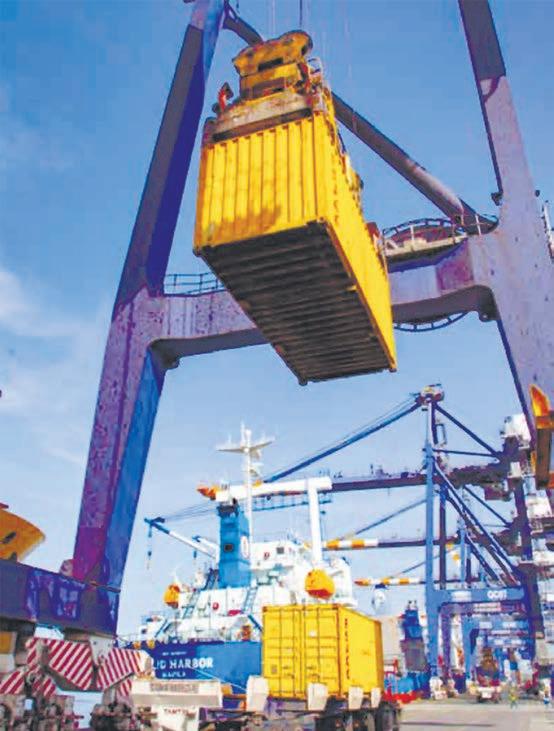
By John Eiron R. Francisco
AS it celebrates 51 years of operations, the Philippine Ports Authority (PPA) renews its commitment to port modernization and service excellence, while promoting workforce unity and well-being to sustain its legacy in nation-building.
“ This milestone is more than just a number, it is a testament to over five decades of commitment, innovation, and nationbuilding through efficient and inclusive port management,” PPA General Manager Jay Santiago said during the anniversary kickoff held on Monday, July 7, at the PPA Head Office in Manila.
Santiago extended his gratitude to port managers from various Port Management Offices (PMOs), as well as department heads and employees, for their active participation in the anniversary celebration themed “Sustaining the Legacy, Strengthening the Nation.”
I n line with the celebration, the authority has lined up a series of activities aimed at fostering camaraderie, promoting employee wellness, and advancing social responsibility.
A mong these are the Anniversary Bazaar at the Head Office grounds from July 7 to 11, featuring local products for employees and guests; a bloodletting drive in partnership with the Philippine Children’s Medical Center on July 7; and the Annual Medical and Physical Examination (AMPE) for Head Office personnel on July 8 and 9.
O n July 10, a donation drive was being held at the Golden Reception
and Action Center for the Elderly and Other Special Cases (GRACES) in Quezon City, under the PPA’s Corporate Social Responsibility initiative, alongside wellness day activities for employees.
The celebration culminates on July 11 with several key events including the PPA FUNtaRUN, the “Tanghalan sa Pantalan” talent showcase, and the conferment of employee awards to honor individuals who exemplify dedication and excellence in public service.
These activities, Santiago said, reflect the agency’s commitment not only to operational excellence but also to cultivating a supportive and service-driven workplace culture.
Sailing strong Meanwhile, the anniversary comes on the heels of the agency’s strongest financial year on record, with the PPA posting significant gains in both revenue and port activity in 2024 and sustaining growth in 2025. I n 2024, the PPA recorded its highest annual revenue to date at P27.637 billion and remitted P5.203 billion in dividends to the national government.
P reliminary figures for this year show that the government-owned and -controlled corporation earned P14.67 billion in

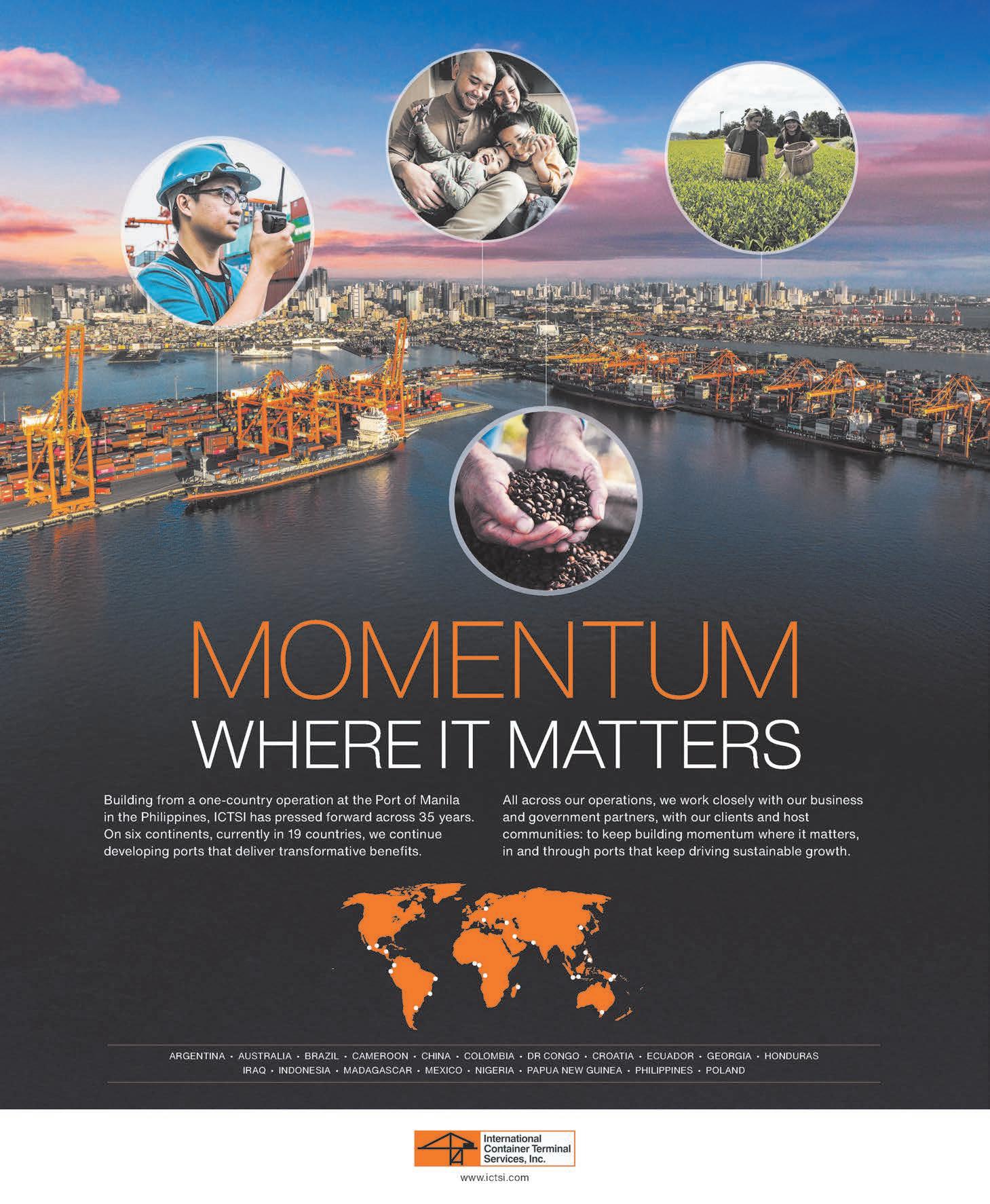
C2 Friday, July 11, 2025 | www.businessmirror.com.ph
Besides the impressive operational and financial figures, the PPA has vigorously pursued port development and maintenance across the Philippines.
By Vincent Peter Rivera
J
UST a year after marking its significant golden milestone, the Philippine Ports Authority (PPA) proudly moves forward with an unyielding momentum. It continues to show significant leaps in operational efficiency and service delivery, solidifying its triumphant stride in continually raising the bar for the nation’s maritime industry—an accolade that’s truly fitting as it celebrates its 51st anniversary.
Established in 1975, the PPA was created with a clear mandate: to centralize and streamline port planning, development, operations, and regulation nationwide. This crucial role positions the PPA as a vital facilitator of waterborne commerce, a key driver of regional development, and a significant force in fostering both inter-island and foreign trade.
The agency is financially autonomous, allowing it to undertake port construction projects that were once the responsibility of other government bodies.
For this year’s marking, the agency is not just looking back at five decades of service but is firmly focused on a remarkably successful first half of 2025. The PPA’s latest Mid-Year Report, as of June 2025, unveils significant growth across key operational and financial metrics, underscoring its pivotal role in the nation’s economic progress.
Operational Performance
The PPA has demonstrated a better performance in operational aspects, showcasing substantial increases compared to the same period in 2024.

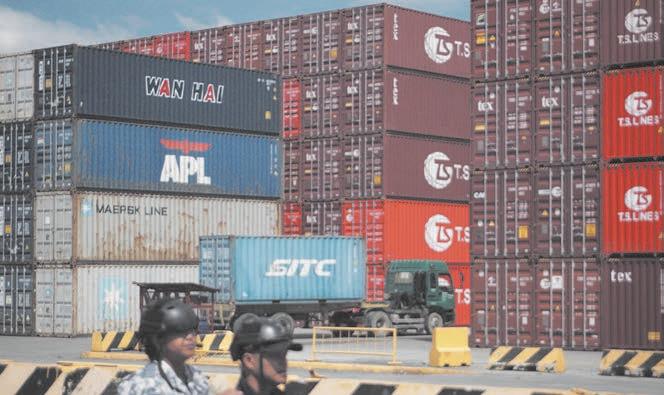
management of its increased activity has been very efficient. Even during peak periods, including holidays and the Chinese New Year in the first half of the year, which typically see elevated trade volumes, the PPA has maintained optimal yard utilization rates. This has been crucial in ensuring unimpeded trade flow and preventing delays. Beyond cargo, passenger traffic has also seen a healthy rebound, experiencing a 10.25%
uptick to reach 45,988,942 passengers by June 2025, a notable increase from 41,712,274 in 2024. Within this segment, cruise passengers have shown a particularly remarkable jump, soaring by a staggering 91.25% to 143,149 in 2025, compared to 74,849 in the previous year—a clear sign of renewed confidence in sea travel. Ship calls also increased by 8.81%, totaling 340,494, and RoRo (Roll-on/Roll-off) traffic grew by 9.36% to 6,396,264 units. These figures reflect the PPA’s continuous efforts to optimize port utilization and enhance connectivity, as seen in recent developments like the 24/7 operation of the Port of Amandayehan, improving cargo and passenger movement, particularly for RoRo vessels.

PPA also continues to underscore its robust financial health, consistently ranking among the top Government-Owned and Controlled Corporation (GOCC) dividend contributors. In another news release from ppa.com.ph, this commitment to fiscal responsibility was recently highlighted by a historic approval from its Board of Directors: a record-breaking P5.20 billion contribution to the national treasury for 2024.
Approved on March 3, 2025, this impressive remittance of P5,203,203,998 represents 54% of PPA’s net earnings, as reflected in its Calendar Year 2024 Unaudited Financial Statements. This achievement not only surpasses the P5.06 billion dividend remitted in 2023 and the P4.4 billion in 2022 but also marks another significant milestone in the agency’s consistently strong fiscal performance.
It also comfortably exceeds the mandate of Republic Act 7656, known as the Dividends Law, which requires GOCCs to remit at least 50% of their annual net earnings as cash dividends to the national government.
As of May 15, 2025, the Department of Finance (DOF) had already secured over PHP 76 billion in dividend remittances from various GOCCs, according to a report from the Philippine Information Agency.
F inance Secretary Ralph G. Recto commended these efforts, stating, “This shows that our GOCCs are continuously operating efficiently and generating substantial prof-
its, enabling them to contribute more to the National Treasury.”
Looking at current figures, the PPA’s financial momentum shows no signs of slowing. As of June 2025, the agency’s total revenue reached P14.67 billion, marking a significant 13.65% increase from the P12.91 billion reported in June 2024.
Beyond the impressive operational and financial figures, the PPA has vigorously pursued port development and maintenance across the Philippines. The initial six months of 2025 saw the implementation of 90 locally funded projects, with 38 concentrated in Luzon, 30 in Visayas, and 22 in Mindanao.
These initiatives are pivotal to the PPA’s strategic aim: a modern and extensively connected port system. In an exclusive interview with Maritime Fairtrade (maritimefairtrade. org), PPA General Manager Jay Santiago underscored the agency’s substantial investment in these major infrastructure endeavors, affirming their alignment with President Ferdinand Romualdez Marcos Jr.’s “BuildBetter-More” program and the national Philippine Development Plan.
T hese dredging efforts are a fundamental aspect of port efficiency, as highlighted by a PortCalls Asia report, on the Amandayehan Port expansion, where a P100 million allocation specifically targeted dredging works to
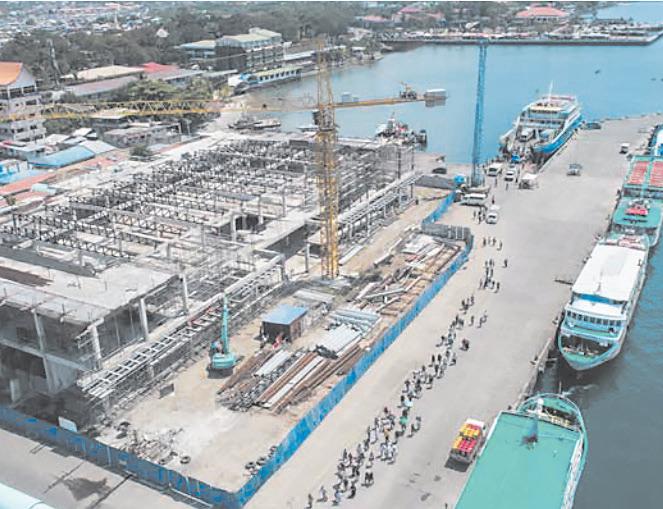
Environmental Initiatives
The PPA’s dedication to environmental sustainability is equally evident through its proactive initiatives. Its flagship Mandatory Tree Planting Program has resulted in the planting of over 12.3 million trees as of January 2025, a figure that continues to grow and significantly contributes to carbon sequestration and ecosystem restoration.
Aside from reforestation, the PPA actively tackles marine pollution. Significant amounts of plastic waste and general refuse are regularly collected from all PPA ports through yearly clean-up drives. These efforts underscore the PPA’s broader dedication to fostering sustainable and eco-friendly port operations, guided by its comprehensive Green Code and Decarbonization Initiatives.
This deep commitment, according to a news release by PPA on its online site, aligns directly with the Philippines’ Nationally Determined Contribution (NDC) to the United Nations Framework Convention on Climate Change (UNFCCC). As per a PPA news release, the agency’s initiatives support the national goal of achieving a 75% reduction in greenhouse gas (GHG) emissions from 2020 to 2030.
Reinforcing this dedication on an international stage, PPA Assistant General Manager for Finance, Legal, and Administrative Services Elmer Nonnatus Cadano recently presented “Decarbonization and Sustainability in Port Operations” at the 11th Spain-Philippines Forum. This significant event, organized by Casa Asia and the Philippines-Spain Business Council, convened international experts in Madrid from March 19 to 20, 2025, and in Cuenca on March 21, 2025, to discuss critical issues in climate action and sustainability within global trade and infrastructure.
As the Philippine Ports Authority moves into the second half of its 51st year, its mid-year achievements for 2025 clearly demonstrate a robust trajectory of growth, efficiency, and significant contributions to the nation’s maritime infrastructure and economy.

PPA marks 51st year, renews push for port modernization and workforce wellness
The government-owned and -controlled corporation earned P14.67 billion in the first half, marking a 13.65 percent increase from the P12.91 billion posted in the same period last year.
Meanwhile, passenger traffic declined by 2.29 percent in the first quarter of 2025, totaling 18.41 million, while roll-on/rolloff (RORO) traffic dropped by 6.96 percent to 2.59 million units. According to the PPA, the decrease reflects changing travel behavior and short-term fluctuations in transport demand.
I n contrast, cruise tourism continued its post-pandemic rebound. The PPA recorded 52 cruise ship calls and 131,687 cruise passengers during the same period, indicating
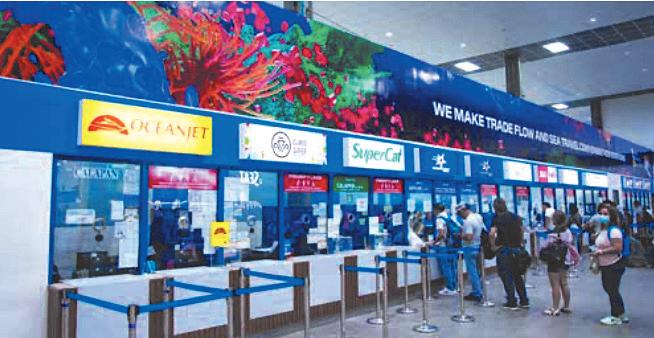
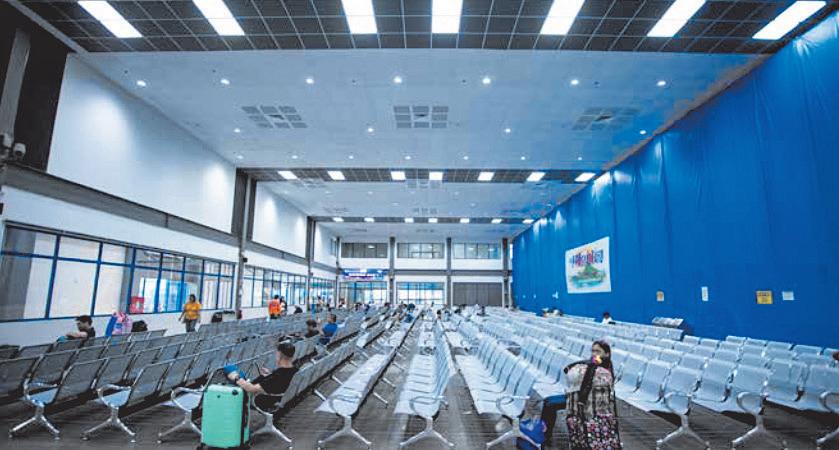


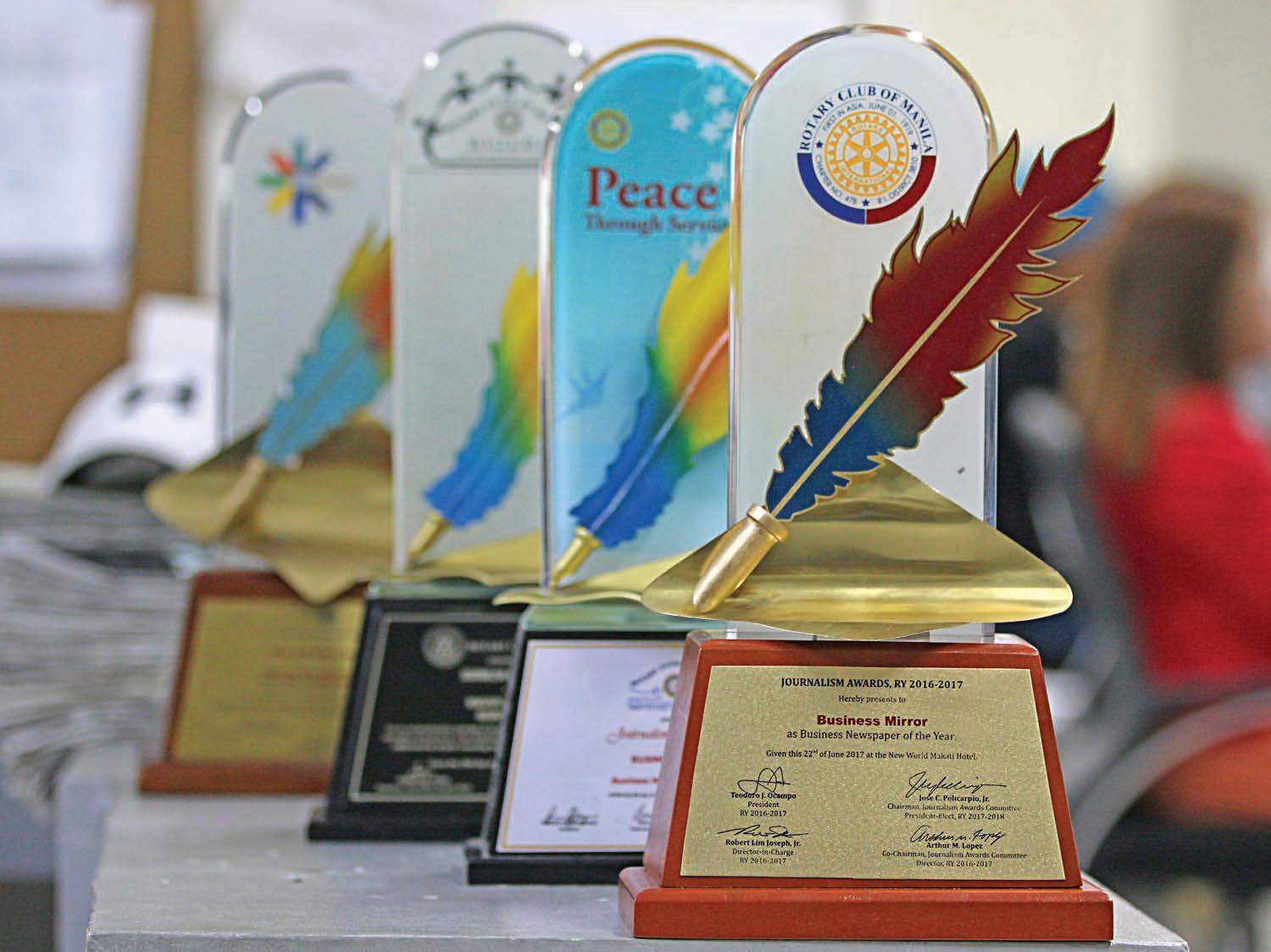

THE pandemic tested the media industry, forcing newsrooms around the world to overhaul the way they do their job while following strict health protocols in order to survive a deadly infection.
The BusinessMirror, the country’s premier national business daily, was tested like everyone else, and survived, even continuing to live up to its promise to provide a broader look at today’s business.
In November 2021, the business broadsheet was recognized as the “Business News Source of the Year” for 2020 by the Economic Journalists Association of the Philippines (Ejap), the country’s premier organization of business reporters, editors and wire agencies. It was a 4-peat for BM, having gotten the same honors for the years 2017, 2018 and 2019.
And, as in the past Ejap awards, it also swept half of the individual categories, with its seasoned reporters adjudged as best in their respective coverages.
Earlier in 2021, the BusinessMirror was given the Pro Patria Award by the Rotary Club of Manila, for “its commitment of valuable resources for the protection of free expression and its resilience in disseminating fair and truthful information resulting in an informed and enlightened citizenry.”


It was just the latest recognition from the prestigious Rotary Club, which named it “Business Newspaper of the Year” for 2018-2019, and again in 2020. In all, it has received six top

Rotary journalism awards in its short 16-year existence.
The BusinessMirror has also consistently reaped top awards in the Brightleaf Journalism Awards for Agriculture and the Philippine Agricultural Journalists-San Miguel Corp. (PAJ-SMC) Binhi Awards, also for the best in agriculture journalism.
The BusinessMirror was also repeatedly adjudged the leading daily in biotechnology journalism, a recognition bestowed by the Jose G. Burgos Jr. Biotechnology Journalism Awards.
T he “broader look” mantra also drew recognition from the Philippine Statistics Authority (PSA) which named the BusinessMirror, at its first awards rites in 2018, as the inaugural “Data Champion.”



In the first “Bantog Science for the People” awards for media from the Department of Science and Technology, the BusinessMirror got the top award for the Institution category for Print; and the grand prize in the individual category for science journalist Stephanie Tumampos.
In 2018, Environment Reporter
Jonathan Mayuga received the Luntiang Aligato award from the Climate Reality Project, a nonprofit organization founded by Nobel Laureate and former US Vice President Al Gore.
T he Broader Look at biodiversity was also recognized. It was named among the Asean Champions of

Biodiversity, for the Media Category, by the Asean Centre for Biodiversity. T he Broader Look also extended to the paper’s corporate social responsibility. It organized and staged the first-ever recognition rites for the best of the Philippines’s friends in the world, with the “MISSION PHILIPPINES: The BusinessMirror Envoys & Expats Awards.” The initiative won a Gold Anvil in 2019. Distinguished institutions in government have also repeatedly recognized the BusinessMirror’s role in spreading the word about the work they do—information that shines a light on good governance and committed public service to uplift people’s hopes. Most notably, these are the Social Security System and Pag-IBIG Fund. Sixteen years, two of them in a pandemic, have tested the promise of a Broader Look. But they are also a measure of the unstinting support of friends—advertisers and news sources alike—and readers who continue to believe in that promise.
THANK YOU, EVERYONE. YOUR LOVE AND SUPPORT IS OUR MOST IMPORTANT TROPHY.

